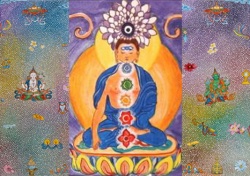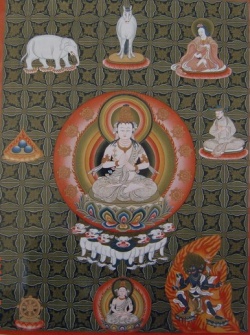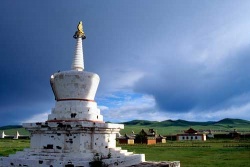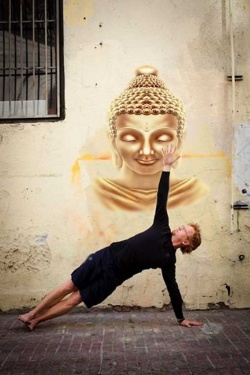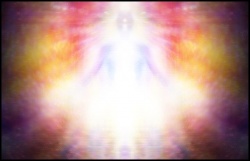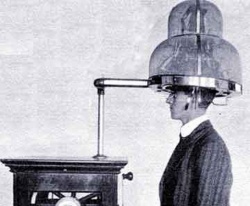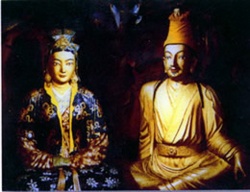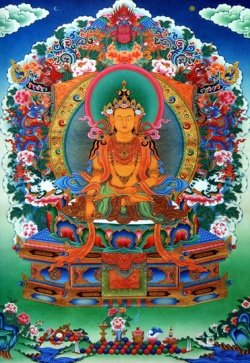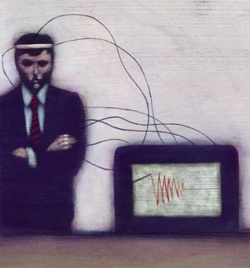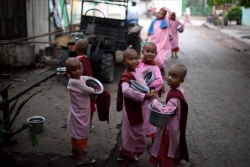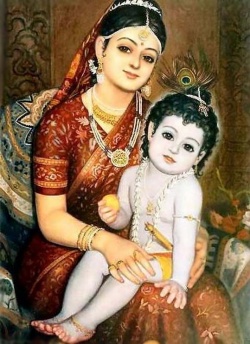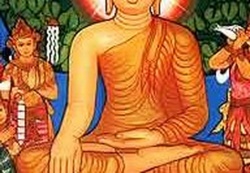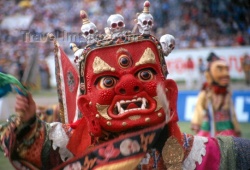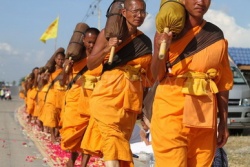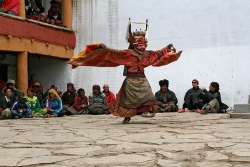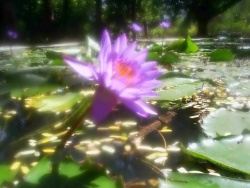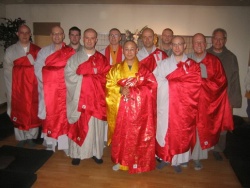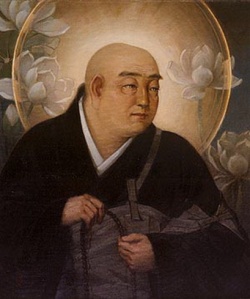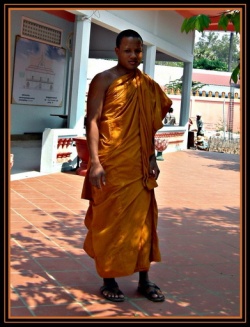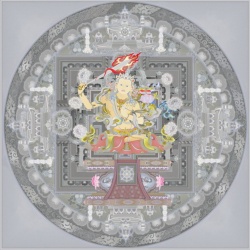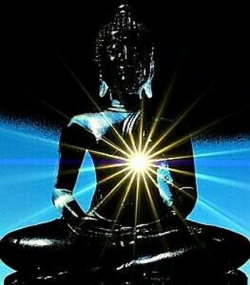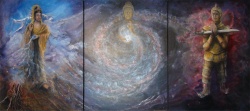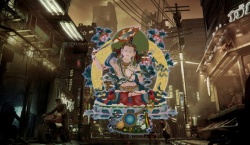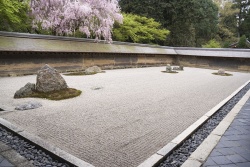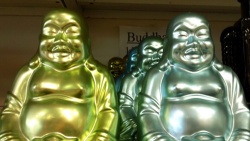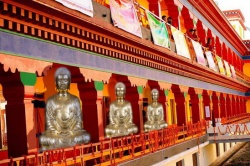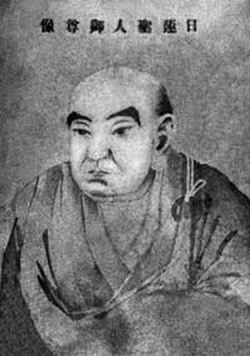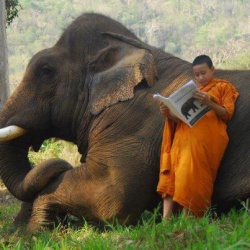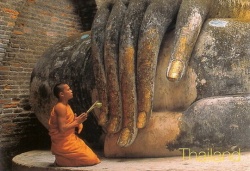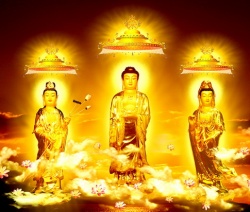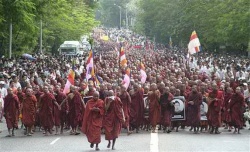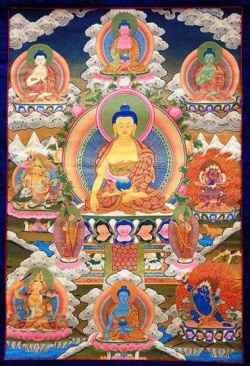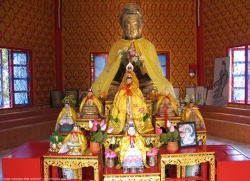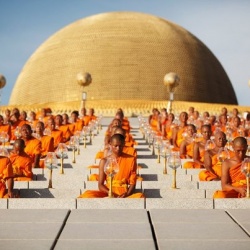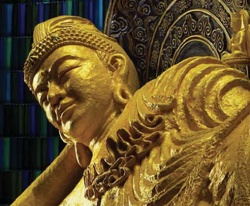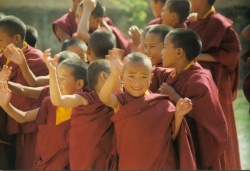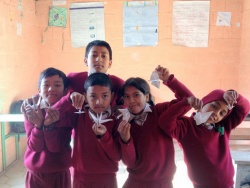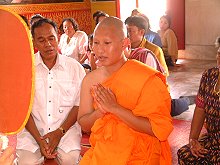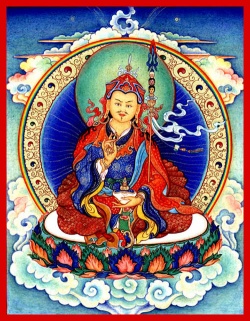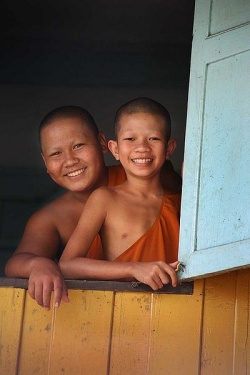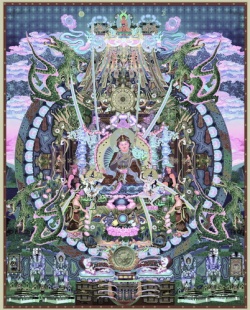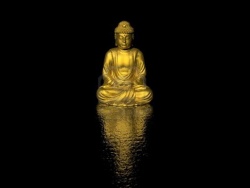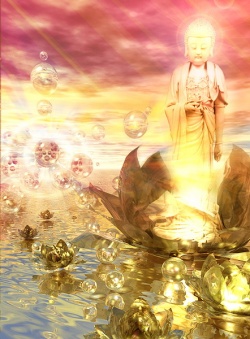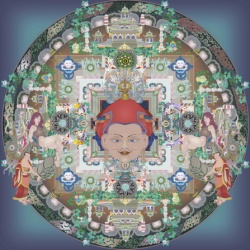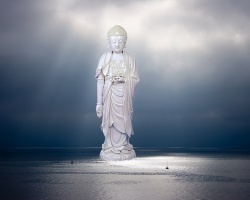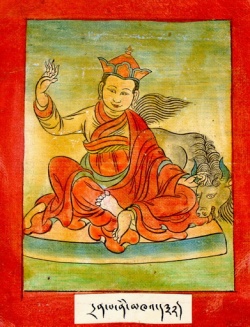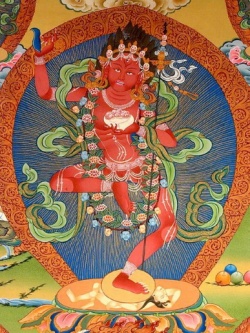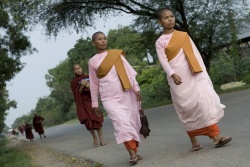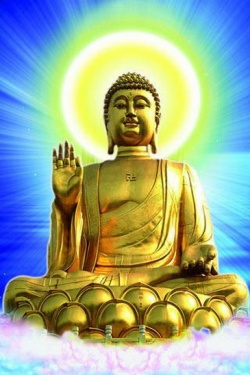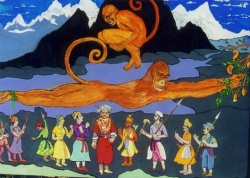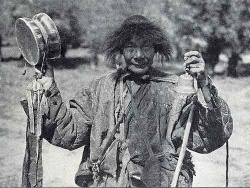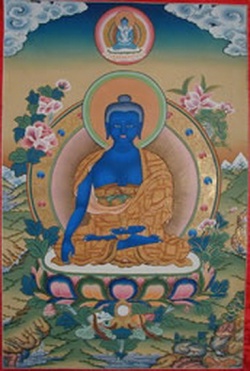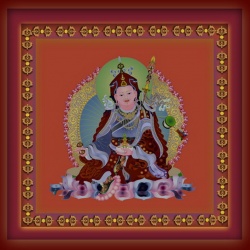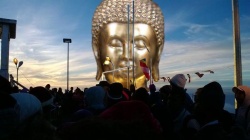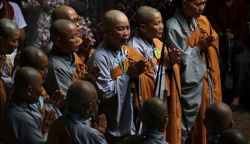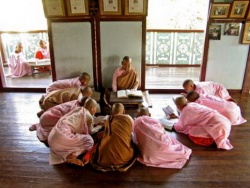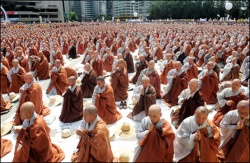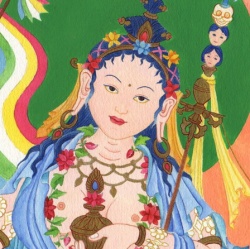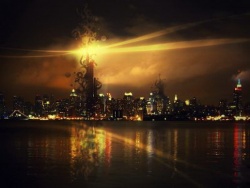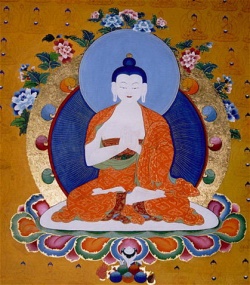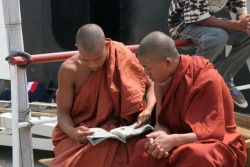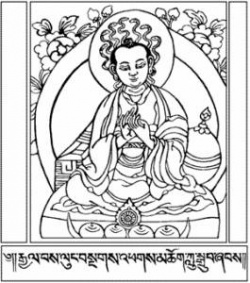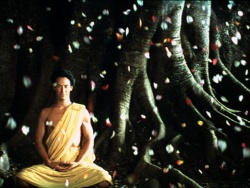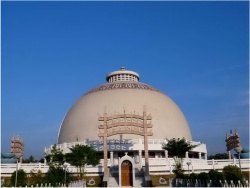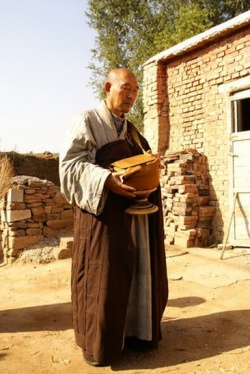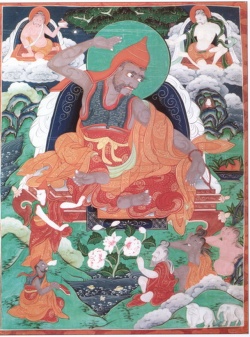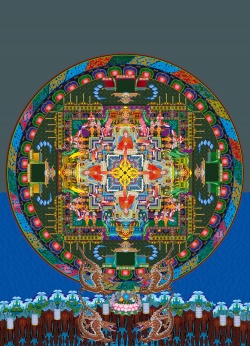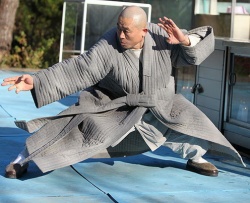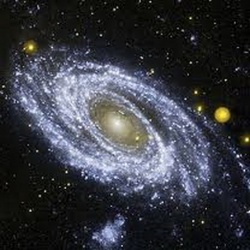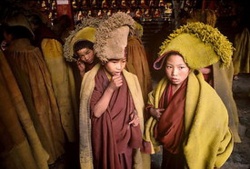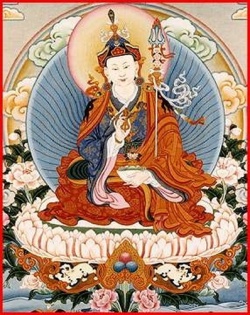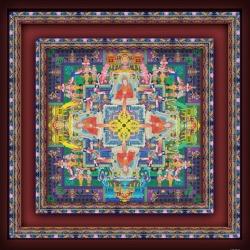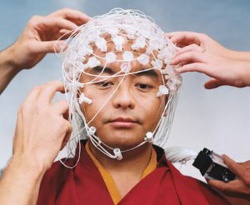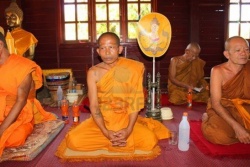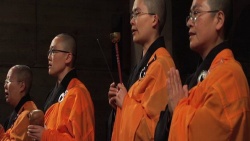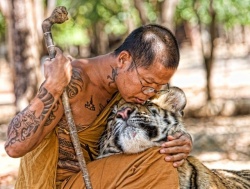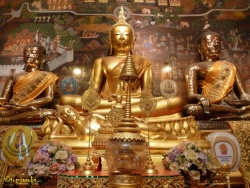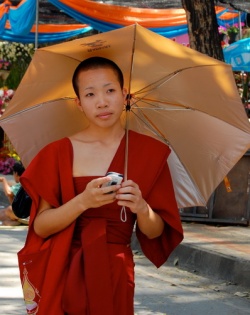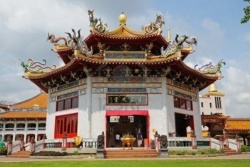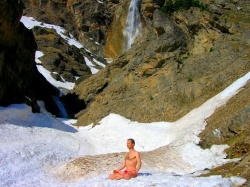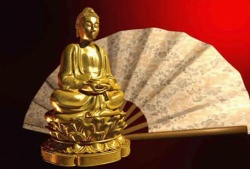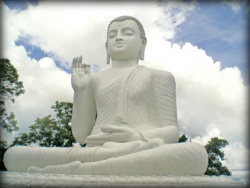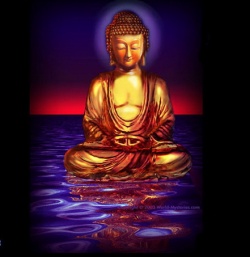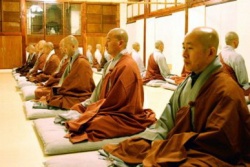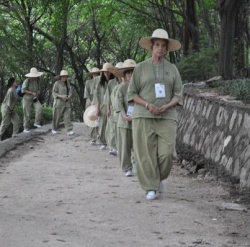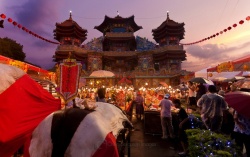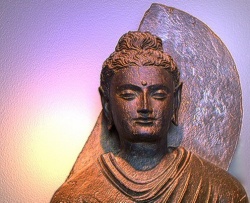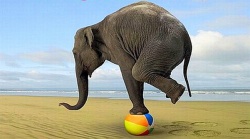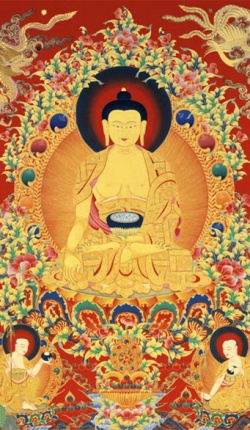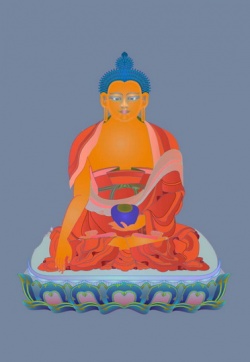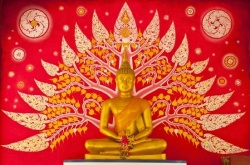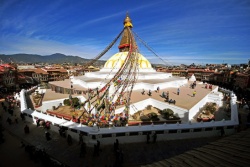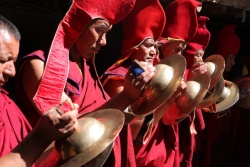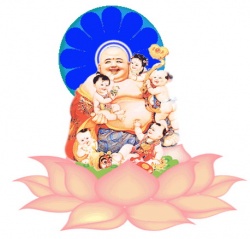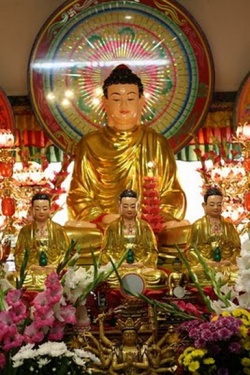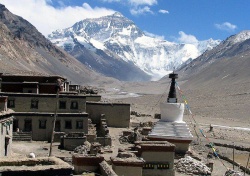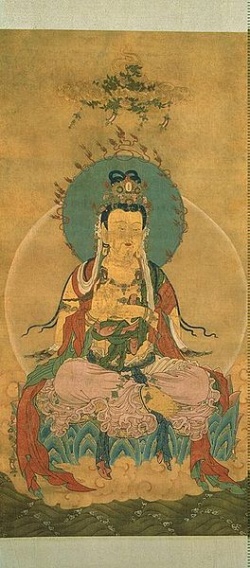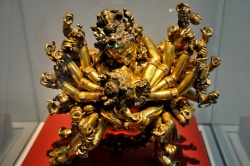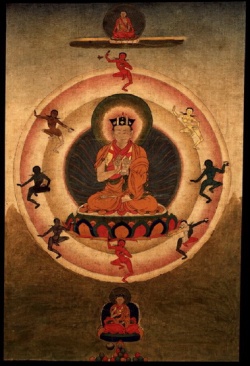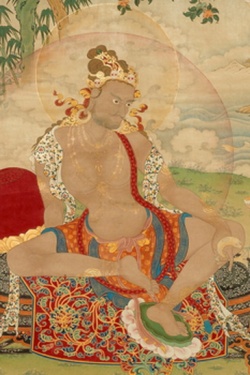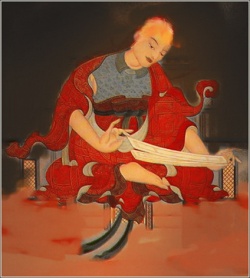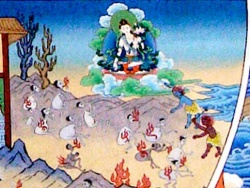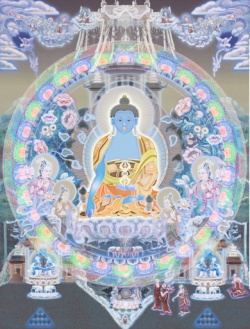Nyingma Lineage
Nyingma Lineage's Great Masters
Contents
- 1 The Pramodavajra Regent of the Divine (Garab Doje) - A Miraculous Birth
- 2 Pramodavajra's Youth
- 3 Great Enlightenment
- 4 Promulgating the Doctrine In India
- 5 The Master's Last Testament
- 6 Three Statements Pointing To Intrinsic Awareness
- 7 Majusrimitra Incarnation of Divine Wisdom
- 8 Sri Simha the Lion of Dzogchen (Palkyi Sanggey)
- 9 Guru Rinpoche's Short Biography
- 10 Vimalamitra (dri med bshes gnyen).
- 11 Yeshe Tsogyal Princess Of Karchen
- 12 Sadaprarudita and the Merchant's Daughter
- 13 A Disciple Of Lord Padmasambhava
- 14 The Nhub Sanggye Yeshe biography
- 15 Kukyen Longchen Rabjam
- 16 Minling Terdag Lingpa (1646- 1714)
- 16.1 Ancestry and Birth
- 16.2 Doctrinal Transmissions
- 16.3 The Great Terton
- 16.4 The Great Master and His Students
- 16.5 Preservation and Spreading of the Teachings
- 16.6 Lochen Dharmashri: His Greatest Disciple
- 16.7 Directives and Instructions to Disciples and Descendants
- 16.8 Terdag Lingpa's Legacy
- 16.9 Parinirvana
- 16.10 Chöpal Gyatso, Lochen Dharmashri
- 17 The Jamgon Khyentse Wangpo
- 18 Jamgon Kongtrul Lodro Thaye
- 19 Chokgyur Lingpa the Miracle Worker
- 20 Palrul Jigmed Choekyi Wangpo
- 21 Biography of His Holiness Dudjom Rinpoche
- 22 His Holinese Kyabje Dilgo Khyentse Rinpoche
- 23 His Holinese Khenchen Jigmed Phuntsok
- 24 The His Holiness Penor Rinpochej's Biography
- 25 Palyul Lineage
- 25.1 The Treasure Holder Mahasiddha Karma Chagmed Rinpoche
- 25.2 The First Throne Holder Vidhyadhara Kunzang Sherab (1636 – 1699 )
- 25.3 The Second Throne Holder Pedma Lhundrub Gyatso (1660 – 1727)
- 25.4 The Third Throne Holder The First Drubwang Pedma Norbu Rinpoche (1679 – 1757 )
- 25.5 The Fourth Throne Holder The First Karma Kuchen Rinpoche, Karma Tashi (1728 – 1791 )
- 25.6 The Fifth Throne Holder Karma Lhawang (unavailable)
- 25.7 The Sixth Throne Holder The Second Karma Kuchen Rinpoche, Gyurmed Ngedon Tenzin Palzangpo (1794 - 1851)
- 25.8 The Seventh Throne Holder Pedma Do-Ngag Tenzin Ngesang Chokyi Nangwa (1830 - 1891)
- 25.9 The Eighth Throne Holder The Third Karma Kuchen Rinpoche, Orgyen Do-Ngag Chokyi Nyima (1854 - 1906)
- 25.10 The Ninth Throne Holder The Second Drubwang Pedma Norbu Rinpoche, Pedma Kunzang Tenzin Norbu (Thubten Chokyi Langpo)(1887 - 1932)
- 25.11 The Tenth Throne Holder The [[Fourth Karma Kuchen Rinpoche, Thegchog Nyingpo (1908 - 1958)
- 25.12 The Eleventh Throne Holder The Third Drubwang Pedma Norbu Rinpoche, Thubten Leshed Chokyi Drayang, Also Known As Do-Ngag Shedrub Tenzin Chog-Lei Namgyal (1932 - Present)
- 25.13 The Twelveth Throne Holder The Fifth Karkuchen Rinpoche, His Holiness Karma Kuchen Rinpoche
- 26 The Kagyu Tradition
- 27 Footnotes
- 28 Source
The Pramodavajra Regent of the Divine (Garab Doje) - A Miraculous Birth
Prince Uparaja and his wife Princess Alokabhasvati of Odyiana had a beautiful daughter named Princess Sudharma. None of the old books tell us much about Princess Sudharma's personal appearance, but we can easily imagine her, fine of feature, small and delicate, similar to any of the petite golden skinned, dark haired girls that may be found in Swat in present times. Her aristocratic features, coupled with the gentle grace of a religious nature, undoubtedly lent Sudharma a particular beauty. This gentle, sweet girl was by nature very devout and kind.
Thus when a strange, wandering holy man in white robes known as Kukkuraja, "King of the Dogs". They came begging at the palace gate, the young Sudharma was deeply affected.
She recognized in the personality of the mysterious Yogi something that stirred her own religious yearning. As soon as she was old enough, she took the ordination of a Buddhist nun and went to live in retreat on a small island in the midst of Dhanakosha lake.
According to the old books, one day while taking a purificatory bath on the shore of the sacred lake, the nun Sudharma beheld a pure mystical vision of a celestial white being.2
Although the visionary figure is usually described as appearing in a luminous male angelic form, there is another version of the same legend which states that what she saw was a vision of the celestial Bodhisattva Vajrapani, the Lord of Mysteries, in the shape of a beautiful white swan.
We must remember that these early accounts were written long ago, and have come down to us as colourful stories where myth is mixed with genuine history. Perhaps after all it was the white clad Guru Kukkuraja who appeared before her.
In either case, as an angelic white human figure, as a white divine swan, or in the image of the god-like Bodhisattva Vajrapani himself, the old texts all agree in stating that the visionary being was ultimately an emanation of supreme Divinity, the one Absolute Vajrasattva.
In Princess Sudharma's mystical vision, the holy White Presence blessed her with special grace by placing a crystal vase 3 three times on her head. Blissful prismatic light radiated from this visionary vase into Sudharma's pure heart, and she was temporarily transported into a state of mystical rapture.
According to the old books, the whole Universe seemed to open up before Princess Sudharma's expanded oceanic consciousness, as she felt her individual self obliterated by waves of divine joy.
Her awakened soul-vision then grasped simultaneously an inconceivable panoramic awareness of totality, of everything behind as well as in front of her, of near and far, of above and of below.
During that split second in the midst of eternity, when her consciousness lost all boundaries, she experienced in full the multiple dimensions of cosmic existence, and felt herself transfigured by the grace of Divinity.
It is said that while she was enraptured in the cosmic joy of blessed divine ecstasy, the heavenly Bodhisattva Adhicitta, an emanation of the self-existent Divine Being (Vajra Sattva), was conceived in Princess Sudharma's virgin womb.
Therefore, according to the historical accounts available to us, the conception and birth of Sri Pramodavajra is rendered miraculous. Sudharma is portrayed as a perfect virgin maid, vowed to pure chastity, who becomes uniquely blessed by the holy cosmic being Vajrapani to conceive a child of Divinity, a son of God.
Of course there is an obvious similarity, for anyone raised in the culture of the West, between this story of Sudharma's miraculous conception and the equally miraculous conception of Jesus in the womb of the blessed Virgin Mary of Nazareth. In fact, tales of virgin births or of miraculous births of one kind or another, have been attributed to most of the world's great religious prophets, from the ancient Iranian Zarathustra virtually up to the present.
Where factual information is lacking, devout invention fills in the gaps. This, however, need not deter from the subsequent history of Sri Pramodavajra's life and deeds.
Nor is it surprising that many a special incarnation has been attributed by the faithful with a miraculous birth.
The mother of the historical Buddha Sakyamuni was said to have been a virgin at the time of her conception, and the same miracle was later adopted by the early Christians to enhance the life of Christ.
Our own Lord Guru Padmasambhava so it is claimed, was born miraculously from a spiritual lotus in Dhanakosha lake.
The symbolic meaning behind the legend of the virginal conception and birth of Sri Pramodavajra is clear.
Sri Pramodavajra was what in India is called an Avatar (from the Sanskrit ava, "descend", and tri, "to pass"), a term that signifies the special Incarnation of a divinely enlightened soul in the flesh.
We do not have to take the symbolism of virgin birth literally, for its poetic and mystical meaning to be acceptable to us.
The Avatar is a well known figure in the scriptural literature of India. For example, the modern Hindu saint Paramahansa Yogananda in his Autobiography of a Yogi, supports a belief that many of the world's great holy men or women might be considered avatars of the Divine.
Thus, for him, not only the traditional Hindu sages (rishis), but also Jesus, Mohammed, etc., were genuine Messengers from Above. He explains, in precise terms, that:
- "A siddha (perfected being) has progressed from the state of a jivanmukta (freed while living) to that of a paramukta (supremely free — full power over death); the latter has completely escaped from the mayic thralldom and its reincarnational round. The paramukta therefore seldom returns to a physical body; if he does return, he is an avatar, a divinely appointed medium of supernal blessings on the world."
That is not all. Just as the reflection of the moon in the sky can be observed in several different bowls of water simultaneously, so too the beatific identity of the divine Absolute may well occur in not one but various human Incarnations, either simultaneously or stretched throughout time.
It is thus that the Highest Most Saintly Individuals of the Universe can actualize within terrestrial existence, the conception of a sacred Incarnation, in order to act on behalf of the all-loving Divine in guiding the spiritual evolution of humanity. Such special sacred Incarnations are known in Tibetan as Tulkus (Skt: nirmanakaya, manifest embodiments of divine Buddhahood).
The number of actual Tulkus, or Avatars, who take birth on this planet are naturally very rare, but when they do appear, they act as instruments of special grace for the world. Unlike ordinary beings, who are swept along by the consequences of their deeds (karma) from life to life — this is the Buddhist theory — the enlightened Tulku consciously chooses to be born in the dark confines of the material world, so as to fulfill some authentic divine purpose.
The majority of recognized Tulkus, according to the Tibetan tradition, tend to be men or women who have previously, in an earlier life, attained some degree of sainthood. The saintly Tulku accepts the sacrifice of returning to this finite world, out of compassion for the sake of the teeming multitudes of sentient beings who remain unenlightened.
However a human Tulku may be looked upon as a direct emanation of the Divine itself, or an emanation of some unique aspect of the Divine. The way that this is described in Buddhist religious writings, is to refer to a certain being as an emanation of Vajrasattva, the Absolute, or as an emanation of one of the celestial Bodhisattvas.
Adhicitta, the sacred Individual from Above who became flesh in the womb of Princess Sudharma and later was known as Sri Pramodavajra, was such an emanation. The other uniquely sacred Incarnations that are especially recognised in Tantric Doctrine are three: the Vajra Manjusri Tulku embodying the omniscient wisdom of the Absolute, the Maha Avalokitesvara Tulku embodying the omnipresent love of the Absolute, and the Guhya Vajrapani Tulku embodying the omnipotent miraculous activity of the Absolute. We shall see that, in the history of the Golden Tradition, there are certain human saints who have been thought of as embodying these emanations.
Ten months after the miraculous conception of the holy Incarnation in the womb of the nun Sudharma, a male child was born. But instead of joy, the mother was overcome with shame.
After all, she was a nun, vowed to religious chastity and a life of contemplation. And not only was Sudharma a nun, but also she was a royal princess.
Her first thought — terrible though it was — consisted of finding some means to dispose of the unwanted child. Immediately the baby was born, she discarded his fragile little body by leaving it out on the local cinder pit to die.
Although many a reader in our modern age of rational thought will find the story of virgin birth an unattractive archaism, with Princess Sudharma's shame and compulsion to get rid of the child, they will have immediate sympathy.
How many a young woman, and especially a nun, finding herself pregnant, has not known the desire to avoid public attention through unburdening themselves of the baby, by abortion or other means? In Sudharma's century, for a young nun to be subject to such terrible public shame must have been unbelievably horrendous.
Sudharma had one devout maid servant, a young girl named Sukha Saraswati.
This maid attended the Princess Sudharma during her spiritual retreat, and it was this maid alone who knew the secret of her pregnancy.
Sukha Saraswati became hysterical when she observed that her mistress had disposed of the tiny baby.
Three days following upon the birth, she slipped out on her own to the cinder pit to see if the poor infant was dead.
To her amazement Sukha saw that the child was not only alive, but that he was happily playing in the ashes, surrounded in an aura of prismatic light.
Rushing back to her royal mistress, Sukha exclaimed with excitement: "O Lady! O Lady! Come and see! Your baby is alive." Sudharma was shocked. Now, riddled with guilt, she dashed along with her servant to the cinder pit.
There, just as Sukha had said, was the baby, gurgling with happiness, joyously propped up in the ashes like a little saddhu. All around his brown skinned, ash covered body, the miraculous glow of a heavenly rainbow light seemed to shine.
Seeing the baby for herself, Princess Sudharma underwent a complete change of heart. Where before she had been consumed by shame at having given birth to a child at all, now she only felt shame for the terrible act which she had done in attempting to get rid of it.
When Sudharma and her maid servant gathered up the precious child and returned with him, the very angels of heaven, so it is said, cried with joy. Sukha Saraswati, the maid servant, then told her mistress: "Truly, your baby is the son of the Buddha!"
So Sudharma named the child Akasavajra (Diamond of Space) and the celestial spirits (devas) sang in sweet voices:
- O Glorious Lord, O Divine Protector!
- O Lord of the World, revealing the true nature! Guide us,
- O Diamond of Space, we pray.
Thus the child was treasured by his mother and grew up under her solicitous care.
Pramodavajra's Youth
When he attained his seventh year, the boy Akasavajra desired to discuss wisdom with the Pandits of Uddiyana. In this regard he was a remarkable child. He went to his mother and said, "Mother, it is my desire to converse with the scholars. Please give me leave to attend college."
But Sudharma thought that her son was too young and immature for the company of scholars. "You are a mere boy," she said. "It is not possible for you to enter the academy of the learned until you have matured." Unable to obtain her blessing, Akasavajra ran away on his own, and sought out the wise men at the court of Prince Uparaja of Dhanakosha.
When Akasavajra first appeared amongst these scholars (pandits) and monks (bhikshus) during a royal audience, Prince Uparaja was affronted by the youth's presence, thinking, "Who is this child?" The scholars and monks were likewise upset to find a seven year old presenting himself as one of their equals. But when the boy began to speak words of purest wisdom, the King's mood changed to awe.
"Who is this child?" the King asked his counselors. "Is he a special emanation of the Divine or what?" Then, when summoned by royal command to speak before the whole academy of pandits, Akasavajra made respectful salutation and quickly demonstrated his innate wisdom and profound understanding of the Buddha's doctrine.
Overwhelmed by the child's brilliance, all the wise men of the land proclaimed him a prodigy. They gave him the ordination of a novice and bestowed on him the name of Prajnabhava, meaning the one who is a source (bhava) of peerless Wisdom (prajna).
Later, when his studies were complete, the young man received the full ordination of a Buddhist medicant monk and was given the title of Master (acarya) from the King. Thus he was known as Acarya Pramodavajra. It is by this name (or the familiar Tibetan translation, Gah-rab Dorje) that he is best known.
Great Enlightenment
As a monk, Acarya Pramodavajra lived a purely monastic, disciplined life for many years. His discipline as a monk prepared him for the contemplative life.
With time he more and more turned away from scholastic studies, to sit in quiet meditation. He meditated in his monastery cell and in the caves and forests of the Kingdom of Uddiyana.
At some point in the maturation of his spiritual evolution, he received the blessed Empowerment and Transmission of the profound Mahayoga teachings of the Secret Matrix Tradition (Guhyagarbha-tantra) from the renowned personal guru of the King of Uddiyana, the great white-robed saint Mahasiddha Kukkuraja.
After that he retired into retreat on the slopes of Mount Suryaprakasa in the north, where he performed mantra practice in a small grass hut.
Kukkuraja's instruction had been very direct. "Everything without exception is the Divine Body-Speech-Mind," he had said. "The Divine Body-Speech-Mind is all-encompassing.
Thus know your ultimate identity to be Vajrasattva, the Divine Body-Speech-Mind."
As the Tibetan text of the Kulaya-raja Sutra (Kun.byed.rgyal.po'i .mdo) states: "When everything is seen as the Great Self-identity (bdag.nyid.chen.po), it is known as Atiyoga."
Therefore Acarya Pramodavajra's spiritual practice (sadhana) consisted of meditating on the core of his being as ultimately the Absolute itself. For many years the meditation and mantra practice of the one divine Vajrasattva became his sole activity.
In his thirty-second year, Acarya Pramodavajra came face to face with Vajrasattva, the Divine: he attained complete Enlightenment. Simultaneously the earth quaked and the sky was filled with celestial sound.
Pleasure and pain lost their sway over him. The emotional strings of desire and fear fell away, and he found himself complete, in need of nothing.
Utterly transformed by pure vision, his whole being was flooded with the grace of great bliss, and his mind awoke through the cosmic empowerment of primordial Awareness.
Thus, in one instant, he grasped full insight into Absolute Totality, the omniscient state of Dzogchen.
From that moment on, Pramodavajra belonged to that stage which, in Buddhist mysticism, is referred to as "no more seeking".
He saw from the perspective of the vast timeless totality of self-existing Awareness (svayambhu-vidya), like a joyous undulation on the surface of the ever emerging ocean of universal consciousness, the numberless waves of phenomena appearing as millions of beings and worlds, arising and subsiding since beginningless time.
Identifying with consciousness, he knew every varied and finite experience of being as himself, while remaining immutably the Absolute (buddha), indivisibly no-thing (shunyam), indivisibly all-aware, and indivisibly all-love.
The ordinary human mind cannot comprehend the nature of such a Great Enlightenment until it is experienced for oneself.
Now, the holy enlightened sage Sri Pramodavajra held within his intellect all of the wisdom, all of the insightful understanding, all of the unique knowledge of what later became known as the Dzogchen Doctrine, and which, when finally written down, consisted of six million, four hundred thousand lines of Sanskrit verse.
This Doctrine concerns the nature of Ultimate Reality (dharmata) and the means of acquiring Enlightenment by cutting through to a clear view of that Reality.
This Doctrine, or optimal View, has been rightly called the innermost essence of Buddhism.
In a nutshell, the Dzogchen Doctrine points to our ultimate identity as nothing less than the Absolute itself.
Since the Absolute, or Divine Being, is that which includes or encompasses all, for which there can be no "other", the absolute view must by definition be nondual.
Although the phenomenal world appears relative, finite; and determinate — and, although human conscious experience arises in a manner always divisible, and hence bounded by subject and object — nevertheless the world and consciousness cannot ultimately be separate or "other", than the Absolute itself. This truth, i.e., the truth of nonduality, must finally be the only acceptable one.
If there were a reality other than the Divine, the independence of such a reality would itself limit the absoluteness of this Divine.
Since Divine Being cannot be limited, the natural corollary follows that the whole of appearance is not other than the ground of Awareness. The most important aspects of the Dzogchen tradition therefore concern the means whereby the ordinary conscious Seeker of the Truth can realize this Ultimate Reality.
What transpires from Sri Pramodavajra's insight is that Vajrasattva, Divine Being, is not , only the source of our reality, but is the sole reality. Divine Being stands at the genesis of Creation not only as our all-conscious common Father-Mother Endlessness, but far more literally as the whole of the totality of being and appearance born into the continuum of time.
Nondualism (advaya) means that God cannot be viewed as a somebody or something over there, divisible from we who are here. If Ultimate Reality (dharmata) is nondual, then our own common ultimate identity (maha-atmyata) cannot be other than God.
The world cannot be other than God. At the same time we are not able to simply accept this at face value. To do so raises all the obvious errors of pantheism and what is called idealism.
Although it may be declared that Vajrasattva is the sole reality, what about the world — the very real world of suffering and ego-consciousness which quite obviously is not Vajrasattva?
How can one declare that God is the only reality, when this world of suffering and separation is so obviously lacking in compassion?
And yet Dzogchen does teach that everything has always been divine and pure since the very beginning. Consequently all of these seeming paradoxes needed eventually to be explained in the Doctrine, so that the correct View could be achieved by the Seeker, for it is the spiritual duty of the one who has found the Truth to communicate it in a language that will benefit the ignorant.
But at first when the word went forth that the unique sage Sri Pramodavajra was teaching a new Doctrine, a non-causal doctrine, not everyone was pleased.
A foreign king holding extremist views sent an assassin to kill the enlightened Master. For the foreigner the very concept of identity between creature and Creator seemed the worst blasphemy.
In his narrow mind, it appeared that the assassination of the Master was a service to the Lord.
Indeed, the era during which we must suppose these events to have occurred was in fact one of great social upheaval and turmoil.
In 690 A.D. the lady Wu Chao had managed to usurp the throne of China and have herself made Emperor (Huang-ti), after having been proclaimed, by an ambitious court monk, as an Incarnation of the future Buddha Maitreya.
By 669 the Western Turks were undergoing considerable political turmoil and Tri Du-srong, the emperor of Tibet, was actively extending his power in Central Asia by means of continuous bloody warfare and pillage.
The neighboring Turkish Shahi kingdoms of Kapisa (Shambhala) and Uddiyana were also both being hard pressed on their southwesterly flank by the inexorable expansion of the southern Arab Moslems.
Ramashankar Tripathi tells us that although "hardly anything is known of the Turki Shahis" during this era, nevertheless it is certain they were carrying on "intermittent wars with the Arab invaders from the seventh to the middle of the ninth century A.D."
By 711 A.D. Moslem raiders would descend on Sind under the command of Muhammad ibn Qasim.
The Middle East was in turmoil and continuous political tensions swept the settled regions of Central Asia. It need not be surprising, therefore, that in this time of crisis; an attempt was made on the life of the holy father of our sacred Dzogchen tradition.
It was around the same time that a wandering trader in fine cloth, from the Valley of Cina, came to Uddiyana.
By chance the young trader met Acarya Pramodavajra and, impressed by the Master's saintliness, asked to receive transmission (agama) and empowerment (abhiseka).
Perceiving that here was a vessel worthy to receive the most excellent teachings, Sri Pramodavajra initiated the young man into the meditation and mantra practice of Vajrasattva.
The young man's name was Simha, the Lion. Later, as Sri Simha, he would be known as a main lineage holder of the Master's teachings.
Promulgating the Doctrine In India
In consequence of the attempt on his life, which proved unsuccessful only due to his miraculous foresight, the Master departed for Mount Malaya in the Salt Range to the south of Uddiyana. He gave up the discipline of a monk, and wandered freely in the white garb of a yogi. It was not long before he began to attract a small following of male and female disciples.
On Mount Malaya he was assisted by three Enlightened-women (dakini) disciples in transcribing into book form the complete teachings of Dzogchen. The work of composition was only concluded after three years of unstinting labour on the part of Sri Pramodavajra, the Dakini Vajradhatu, the Dakini Suvarna Shankara, and the Dakini Anantaguna.
When the work was finished they stored it in the archives of a cave-temple known as the Dakini-abhivyaktabhava, or the " Dakini's Source of Manifestation" , where it was held in the safe-keeping of the abbess, Dakini Cittasana.
With the certain knowledge that the precious, supreme Secret Doctrine was secure, Sri Pramodavajra then proceeded on pilgrimage to Vajrasana (modern Bodh Gaya), the site where centuries earlier Buddha Sakyamuni had attained his enlightenment. With his mystic consort, the Lady Suryakirana, he took up residence in the Cool Grove (Sitavana) cremation ground, which lies about a mile or so northeast of Vajrasana.
A large white stupa graced the Cool Grove cremation ground with its aesthetically beautiful presence.
This was the Shankarakuta stupa, which happens to be the same name as the temple and stupa in Uddiyana near where the Master had been born.
There, in the Cool Grove, at the base of the white Shankarakuta stupa, Sri Pramodavajra lectured on the mysteries of the Supreme Truth to many beings, both male and female.
One of the disciples who came to sit at the feet of the divine Master was the Mahapandita (" Great Sage" ) Manjusrimitra. Eventually Sri Manjusrimitra became the guru's chief successor and spiritual regent.
The Master's Last Testament
Sri Pramodavajra spent the rest of his days teaching at the Cool Grove and at various spots in and around Bodh Gaya. Occasionally he and his band of chosen disciples would wander northwards to the hot springs that are near the Vulture's Peak, not far from Patna.
Eventually the Master's body weakened with age, as is the fate of all who walk this earth. Then one day, without the slightest pang of remorse, Sri Pramodavajra passed out of this world.
When Sri Pramodavajra departed from earthly life, he left his Last Testament in the hands of his beloved disciple Manjusrimitra. This highly treasured Last Testament consists of a tiny fragment of script that has come down to us in its Tibetan version. Translated into English, it is roughly as follows:
Three Statements Pointing To Intrinsic Awareness
- Direct introduction to one's own nature.
- Direct recognition of that singular state.
- Direct immersion through faith in liberation.
We understand that this Testament, short though it is, was composed as a means of transmitting from generation to generation a special fragment of spiritual information between initiates.
Direct introduction refers to the teaching that it is essential to find a guru who can actively expose one's innermost nature or essence, through the power of his own presence. It means that the seeker must struggle to grasp the mysterious nature of mind in itself. That is the first step in cutting through.
Direct recognition refers to the teaching that the seeker of the Truth must simultaneously be able to relate his understanding of the mind to the arena of actual experience.
That is, he (or she) must be matured to the point where, when the truth is introduced, he can turn its significance inwards. Maturation is developed through the generation process (utpatti-krama) and completion process (nispanna-krama) of the yoga of beatific Sri Vajrasattva.
Direct immersion then means that, by bare sustained remembrance of the experience of the truth, without attempting to control the activity of the mind in any way, liberation will naturally occur on its own.
This refers to what is called "self-liberation" because it occurs without an egoic effort on the part of the seeker. In fact, no other type of liberation is possible, the dawning of Enlightenment being ultimately a matter of grace.
Such is the essence of the vast and profound teachings of Tantric Dzogchen practice. When practiced in the presence of an enlightened Dzogchen Master, this is the method that results in enlightenment in a single lifetime.
Majusrimitra Incarnation of Divine Wisdom
Manjusrimitra was the intelligent son of an upper class Brahmin from a second grade village to the west of Bodh Gaya.
It is said that as a youth he was handsome, with gracious features and clear dark eyes. This fine featured boy, who seemed to deport himself like a young prince, was fair of skin, tanned to a golden hue in India's daily sun.
His hair was as black as a raven's back.
Life At Nalanda University
Manjusrimitra was initially taught at home by skilled tutors. When he was well educated at the graduate level, he went to Nalanda University, which was at that time the world's greatest establishment of learning.
Nalanda was the end result of a series of endowments initially made by six kings, culminating in the lavish patronage of the great Emperor Harsha.
The buildings, many of which were six storied, were majestic in their size and height, with richly adorned towers and observatories seemingly lost in the clouds.
A stone inscription of the eighth century describes how the row upon row of six-storied monasteries, each possessed a series of golden spires (sikhara-sreni) seemingly touching the sky.
Down below, fair lawns surrounded the buildings, along with a scattering of ornamental ponds, planted with blue lotus and deep-red Kanaka flowers, while at stately intervals Amra groves spread their lush foliage over all, affording cool shade.
The academic area at Nalanda was marked off by a lofty enclosing wall. The four main gates opened into the great college, from which were separated eight other halls, standing in the middle of a vast park.
The University provided for all its alumni (without cost) the basic necessities of clothing, food, bedding, and medical care. Education was free.
The students being so abundantly supplied with the essential material needs of life, were therefore expected to concentrate whole-heartedly on their education, and the conditions for admission were very strict. Nalanda University was an academy for higher graduate studies.
Nalanda University boasted 1,500 teachers in charge of 8,500 students. The teachers were expected to be able to recite by heart, at minimum, twenty collections of Sutra and Shastra.
Of these teachers, about 500 were said to be able to recite and comment on as many as thirty such collections.
There were about ten from amongst the teachers who knew as many as fifty collections, and these latter were viewed, as we can well imagine, with special awe. But above all of these, we are told, were four seniors, who resided in the four Gate-houses at the four quarters of the University cantonment. These last were considered the most learned of all.
Huang Tsiang, a Chinese monk who visited Nalanda University during his pilgrimage to India, tells us that all the alumni "dwelling here are, as a body, naturally or spontaneously dignified and grave, so that during the 700 years since the foundation of the establishment, there has been no single case of guilty rebellion against the rules."
We also know that the courses of study offered at the University covered virtually the entire range of world knowledge then available. Courses were drawn from every field of learning, Buddhist and Hindu, sacred and secular, foreign and native.
Students studied science, astronomy, medicine, and logic as diligently as they applied themselves to metaphysics, philosophy, Samkhya, Yoga-shastra, the Veda, and the scriptures of Buddhism. They studied foreign philosophy likewise.
Amongst the residents, and the staff, there were persons of various affiliations: there were of course the great body of Buddhist monks, but also the worshipers of Krishna, the white robed Saivites, the Samkhyists, the Materialists (Lokayatikas), the Vedantins, and those of foreign lands:
the Yavanas (Greeks), the [[Wikipedia:Central Asians|Central Asians]], and the Chinese. Undoubtedly Christian and Manichaean missionaries could match argument with Brahmanist or Ceylonese savant, and Magi could confer with Turkhoman, in perfect tolerance.
Nalanda University became the common meeting-ground for all sects and beliefs, for every kind of philosophy and science, where in its daily "tournaments of discussion" every rational and irrational doctrine could be tested in an environment run on humanistic principles.
A philosophical opinion or scientific discovery at once approved and recognized at Nalanda would immediately acquire universal respect. To win a debate at the University was therefore a prize much sought after.
But the scholastic atmosphere, fired by animated controversies between divergent schools of thought, was not the University's sole pre-occupation. Before it was an academy, Nalanda was a monastery – indeed, a group of monasteries, juxtaposed in harmony.
Those who enrolled in the University lived their term as monks, recognizing in the midst of the various intellectual differences of the age, a higher ideal capable of evolving a common vision founded on the spirit of mystical contemplation.
Manjusrimitra, ordained as a Buddhist monk, studied for some ten years at this seat of extraordinary culture and learning. Having graduated with honors from the basic curriculum, he acquired the renown of a Pandit, or scholar. His brilliance was rewarded with a teaching post.
Then by degrees, he advanced to the position of Mahapandita and became one of the venerated Gate-holders of the University.
Finally he was unanimously acclaimed the leading scholar of the whole academy, and hence really of the whole world in that era, with the title of supreme Patriarch (Kulapati).
He was particularly learned in the Madhyamaka (Middle Way) philosophy expounded by the brilliant first century Buddhist sage Arya Nagarjuna.
The Great Debate
One day a learned man named Manjusritiksana came to Nalanda University and proclaimed in front of the Patriarch Manjusrimitra, "O noble lord, if you want to acquire Great Enlightenment in this your present lifetime, then you must go to the Sitavana cremation ground near Bodh Gaya! There is a saintly Guru there who expounds the nondualist doctrine."
Now, this message did not exactly please Manjusrimitra at all! Initially the great Patriarch was far from open to meeting with Sri Pramodavjra. From much of what he had heard, he expected the Master to be the exponent of doctrines fundamentally at odds with what he considered to be true Buddhist philosophy.
The Mahapandit Manjusrimitra represented the classical, scholastic tradition of Madhyamaka.
He was the uncontested head of the great monastic University of Nalanda, and thus representative of a long historical scholarly line that considered itself the pinnacle of orthodoxy. He viewed anything to do with Yogacara as a false doctrine.
Nor was doctrine the only issue at stake. Compared to the saffron-robed monks, whose lives were meant to stand for impeccable virtue and chastity, the Guru Pramodavajra was a vagabond Yogi-saint, a popularly acclaimed white-robed Siddha, who lived with a woman consort, and practiced meditation in a charnal ground strewn with the ghastly remnants of the dead.
When the powerful Mahapandit went out to see Sri Pramodavajra for the first time, it was with a full retinue of admiring followers, and with the plain intention of engaging the Yogi-Master in a debate that would put him to shame.
The history books of our Tradition do not tell us how the august Patriarch traveled from Nalanda to the Cool Grove cremation ground of Bodh Gaya, but from other texts we do know that the University was duly mindful of the dignity that should belong to the position of its official Patriarch.
The company would therefore have formed an imposing procession, carrying standards, parasols, flower garlands and perfume sprinklers, accompanied by young novices swinging smoking incense censors.
At the head of this grand assembly would have been the great Patriarch Manjusrimitra himself, in full splendor, dressed in magnificent golden coloured robes, seated on a noble elephant.
Upon arrival, a formal throne would have been erected for the distinguished Mahapandit.
As many as twenty lesser Pandits, noted for their dignified bearing, would then have escorted the Master Pramodavajra into the august presence of their Patriarch.
After formal introductions, Manjusrimitra would presumably have opened the debate with a broad attack from the Madhyamaka position. We know that the Patriarch expected to win hands down.
Of course, quite the opposite happened. It was the Great Pandit who looked the fool, and whose vaunted knowledge proved empty in the presence of Sri Pramodavajra's penetrative wisdom.
With masterful answers the Saint quietly laid Manjusrimitra's arguments bare, and showed how shallow is purely intellectual knowledge when faced with the direct experience of actual Enlightenment.
The most learned scholar Manjusrimitra had come like a general to do battle, only to fall conquered before the invincible insight of the living saint.
Thus the Master is said to have tamed the great scholar and brought him within sight of seeing his own true nature.
After his defeat, all that Manjusrimitra could do was admit his subtle egoism and the exposed limits of his knowledge. He sat at the feet of the Master and begged to become a disciple.
This humble but truly honest act of submission to the Master scandalized many of the lesser scholars of the Patriarch's entourage.
We read in the history books that the majority of those that went forth that day to witness the debate, turned away from their Patriarch when he submitted to Sri Pramodavajra.
The crowd of fools marched back to Nalanda, leaving the defeated Manjusrimitra to his new life.
In general people need the institutions that support their position in the world. Consequently they fiercely hold to the ideological concepts belonging to those institutions.
Desiring a stable frame of reference, they cling to whatever fixed system of beliefs that confirm meaning for them. Once satisfied with such a set of concepts and beliefs, it becomes next to impossible for them to change.
A full mind and heart, like a full stomach, no longer feels the need to seek anything more. Thus people close themselves to the spiritual quest.
The scholars of Nalanda University left their Patriarch because he could no longer serve their need of lending authority to a system of beliefs that he no longer saw as true.
Living in Dependence on the Guru
In defeat, the great sage Manjusrimitra was bereft of those intellectual constructs that until then had supported his view of life.
He became, as it were, an empty vessel ready to receive utterly fresh, direct insight. Into that open cup the Master poured his illuminated spirit of truth.
Sri Pramodavajra began the re-education of Manjusrimitra by instructing him as follows:
- "The nature of your own mind-essence is, from the very beginning, none other than Buddha.
This mind, in and of itself, is both birth-less and deathless. It is simply like the sky. If the intrinsic truth of the nonduality of all phenomena is understood in its totality, and if this view is merely sustained in faith, without making any kind of effort, then that is how one should practice meditation."
On another occasion Sri Pramodavajra said:
- "Remain aware as thoughts arise, remain aware if thoughts do not arise: there is no difference in Awareness in either case."
Holding to these precepts, Manjusrimitra proceeded to live in dependence on the Guru, merely sustaining remembrance without making any effort to control or incline the mind.
Consequently, in rapid succession, and through the sublime grace of the compassionate Master, the lotus-like petals of the delicate bud of Manjusrimitra's inner heart opened up, revealing the central sun of the eternal Buddha within.
With the sharp diamond point of the profound teachings of Absolute Totality (mahasamdhi), which immediately reveals the authentic ground of reality just as it is, and without any hesitation or meandering, he rapidly awoke to the Light.
Manjusrimitra had been like a ripe fig ready to fall from the tree of Enlightenment when he first met his divine Guru. His years at Nalanda studying the Dharma had prepared him well.
It therefore did not take much for him to be led to see the nature of mind. In short order he attained Enlightenment.
Aided by perfect instruction, the disciple thus became equal to the Master. Even then he continued to serve the Guru, with complete love and joy.
Thus Manjusrimitra came to dwell in a supreme state of transcendental bliss.
He became Pramodavajra’s leading disciple — his gyaltsap or lineage heir. And so over the years, the aging guru and leading disciple, surrounded by devotees and friends, traveled about India, bringing blessings and light to innumerable beings.
Sri Pramodavajra's Death and Resurrection
As is the fate of all, with time Sri Pramodavajra's body could no longer sustain life, and he passed away. Manjusrimitra was stricken with grief.
Although he perfectly well knew that in reality the immutable essence of mind is neither born nor dies, nevertheless out of the passion of his human love for the Guru, Manjusrimitra's heart wept, desiring the human personality and physical presence of Pramodavajra that he had grown to so deeply care for. Overcome, he prayed to his beloved Master, refusing to believe that death could sever the bond of intimacy that had grown so strong over the years.
And lo, how greatly did Manjusrimitra's grief turn to holy pleasure, when during the solemn cremation rites, Sri Pramodavajra's resurrected bodily form, so dear to his disciple, appeared before him amidst the flames, transfigured within a translucent sphere of pure radiant light!
It is said that, in what was a final act of selfless communion, and before ascending forever beyond this finite, mortal world of matter, the momentarily resurrected form of Pramodavajra miraculously placed into Manjusrimitra's trembling hands a small but concretely physical casket fashioned from gold-metal, containing the divine Master’s last testament. This it is that is known as the Three Statements Pointing to Absolute Awareness.
We are told that this final miraculous gift of the Master destroyed for ever the last traces of Manjusrimitra's instinctual fear of death — his final fear of separation and loss in this world.
He became, at that moment, instantly and completely liberated. Full enlightenment was then his.
Henceforth, says sacred history, no separation existed between Manjusrimitra's consciousness and the immortal presence of his beloved spiritual father.
Now disciple and master existed one and the same, in a wholly mystical state of union, as the individual dew drop of finite personhood "slipped silently into the shining sea" of infinitude, to become inseparable with Buddha-Absolute.
It should not be thought incredible that Pramodavajra appeared in an actual body of resurrection after his death. Similar stories are recorded of other great saints,
such as Jesus, Milarepa, Kabir, Sri Simha, Padmasambhava, and Ju Mipham Namgyal.
St. Paul, who once persecuted the apostles of Jesus because they believed in their own Master’s resurrection, eventually became so convinced of this fact that he wrote
- "So when this corruptible shall have put on incorruption, and this {{Wiki|mortal]] shall have put on immortality, then shall be brought to pass the saying that is written: 'Death is swallowed up in victory."
Likewise Manjusrimitra is said to have briefly appeared in physical form to at least one of his disciples after his death.
After Sri Pramodavajra's passing, the Master Manjusrimitra went to live in the Sosadwipa cremation ground that was to the west of Bodh Gaya, where he taught many Yogis and Yoginis and other spiritual practitioners.
There he produced a fresh redaction of Sri Pramodavajra’s doctrine, which it is said, had been composed in 6,400,000 slokas and stored in the archives of the Dakini-abhivyakta-bhava, [[Cave}} Temple]], under the care of a certain abbess named Lady Cittasana.
This new redaction he supposedly reduced to a more available form, by dividing the original into three categories: a Mind section, Space section, and Esoteric Instruction section.
Sometime after that, Manjusrimitra settled down to live with a beautiful woman named Sri Devi, the widow of a peasant farmer.
Her first marriage had been arranged, as is so often the custom in India. But her second marriage to the Master Manjusrimitra was sanctified by true love.
The two lived happily on their little farm near Bodh Gaya for the rest of their lives.
Sri Manjusrimitra spent his days performing quite ordinary duties around the farmyard, or else merely relaxing in contemplative ease on one or other of the two charpoys that were set out on the hard packed earth yard in front of their one-roomed adobe hut, where shade was afforded by a single, rather sparse tree.
Here in the cool of a tropical evening, a number of devout disciples would usually gather for discussion and meditation, or to sing prayerful bhajans.
Some would come from great distances to enjoy darshan (audience) of the renowned master and his saintly wife. There were at these evening gatherings devotees who thought of themselves as Buddhist, and others who considered themselves Hindu.
All assembled together in perfect tolerance and harmony, regardless of caste or sect.
Such is the life story of [[Manjusrim
itra]], one of India’s greatest yogi-saints.
Sri Simha the Lion of Dzogchen (Palkyi Sanggey)
Sri Simha, or Simhaprabha as he may have been known, was born in a noble family in the Cina Valley of northern India. He lived during the 8th century.
The location of the "Land of Cina" has been the cause of considerable confusion for both Tibetan historians and modern Western scholars, to the extent that even Dudjom Rinpoche's The Nyingma School of Tibetan Buddhism perpetuates the error of stating that Sri Simha came from China. Evans-Wentz, just as incorrectly, described Sri Simha as a Burmese guru.
Dr. Hanson-Barber places Sri Simha in [[Wikipedia:Central Asia|Central Asia]], while Dowman has suggested that he was Khotanese.
Tulku Thondup, author of Masters of Meditation and Miracles, describes Sri Simha birthplace as "a city called Shokyam on Sosha Island in China." None of these allocations are correct.
To fully appreciate Sri Simha's background we must briefly digress into the geography of a mysterious seventh century Himalayan country called Suvarnadwipa and its southern neighbour, the Kinnaur Valley.
The Golden Matriarchy and the Land of Cina
It is little known that before the Tibetan people swept from the East into the regions of trans-himalaya, there once was a land in Western Tibet known by the name of "The Land of Women" (Stirajya).
Because the rivers of this land were rich in gold, this country was also known as the Golden Land (suvarnadwipa).
Yet another name for this country appears to have been the "Golden Matriarchy" (suvarnagotra).
The ancient Greeks held many myths concerning the Amazons, a tribe of warrior women, and their land called Amazonia. Dionysus was said to have encountered them on his travels to India, and supposedly Heracles successfully fought against them, capturing their queen Antiope.
According to Robert Graves, the term "Amazon" may originally have been an Armenian word, meaning "moon-woman", a priestess of the Moon-goddess.
Although the Greeks are said to have located the land of the Amazons in Scythia, on the Black Sea, and it is true that priestesses of the Moon-goddess on the southeastern shore of the Black Sea were known to have born arms, it remains uncertain whether the myth originated there.
It is just as probable that tales of a nation governed by a line of queens could have been passed to the Greeks along the trade routes from India.
As Prof. R. A. Stein says, the Western Land of Women was "a mysterious region mentioned by Chinese and Indian authors."
Apparently this matriarchy, with its capital at the Silver Castle of Khyunglung (east of present day To-lung) in Western Tibet, was the same as the land of Zang-zung.
The latter is the Tibetan name of the land. Zang-zung or Suvarnadwipa was an ancient Indo-European nation, said to have been ruled by a royal lineage of women.
This matriarchy or queendom once existed along the valleys of the upper Sutlej and the Indus rivers, from Tirthapuri, west of Mount Kailash, as far as the borders of modern Ladakh.
In Ladakh itself, matriarchal lineage has been known during various periods of Ladakhi history.
It is likely that Suvarnadwipa once consisted of the whole of Western Tibet and Ladakh, prior to conquest by the Tibetan people invading from the east.
Apart from gold and matriarchy, the Golden Land of Suvarnadwipa (or Zangzung) was famous for manufacturing and exporting to India a peculiarly fine wool cloth known as cina-patti, or in other words, "fabric (patti) from Cina."
Thus we find in Kautilya, for example, the mention of Cina as a valley within the territory of Suvarnadwipa, from whence cina-patti was brought to India. At present this same extra-fine cloth, no longer manufactured in Suvarnadwipa, but instead in Kashmir, is known as cashmere.
Prof. Stein is vague in delineating the actual borders of the ancient land of Suvarnadwipa:
"How far Zang-zung stretched to the north, east and west is a mystery," he says. :
"It seems to have dovetailed into two countries mentioned by T'ang historians as Lesser and Greater Yang-t'ung." This only confuses the matter further, since Pelliot and Tucci consider Yang-t'ung to be Zang-zung itself.
Today, the territory in Tibet that once was ancient Suvarnadwipa, is more or less a dry barren wasteland.
In Sri Simha's era, however, it was apparently rich, not just in gold, beautiful Amazonian women and fine cloth, but in verdant gardens, herds of sheep and goat, and apple orchards.
The researches of Marcelle Lalou have sufficiently shown that the territory of the Indian Kailasa, south of Western Tibet (below Suvarnadwipa), comprising modern Kinnaur, was known in ancient times as the valley of Cina. Ancient Cina (or modern Kinnaur), south of the 15,400 ft Shipki Pass (known to the Tibetans as Sarang-la), was apparently a vassal state of Suvarnadwipa. In present times this extensive but isolated valley, hemmed in by the Himalayas, now belongs to India.
It is pierced by a major India-Tibet roadway, originally commissioned by Lord Dalhousie in 1850. The valley is home to both Buddhist and Hindu temples.
Confusion arose when, in the 9th century, Tibetans attempted to translate, from the early historical records of the Dzogchen Tradition, the name "Cina" into their own language.
By that time the Indo-European matriarchy of Suvarnadwipa (or Zang-zung) had been overrun by Tibet for more than a century. Every vestige of the land, its people and its language, had long since undergone severe changes.
The name ‘Cina,' referring to the southern district of Suvarnadwipa, no longer held any meaning for the Tibetan historians.
"Cina" and "Mahacina" were, by the ninth century, almost mythical places.
While "Mahacina", which probably originally meant Central Asia, came to mean "China" (rGya-nag, the "vast region where people dress in black" according to the Tibetans), the location of Cina simply got lost.
With time, Tibetans came to believe that "Cina" was related in some way with "Greater China" (mahacina), and therefore that Sri Simha was a Chinese sage.
The Kinnauri tribal group is in fact an Indo-European people who, nevertheless, tend to consider themselves distinct not only from Tibetans but also from their Indian cousins to the south.
Homskad, the language spoken in Kinnaur, is dispersed into about 12 different dialects.
Kinnauris are traditionally farmers, who adhere to a mixture of Hindu and Buddhist customs, with most villages having both Saivite Hindu and Tibetan Buddhist temples.
The present culture is probably not much different than when Sri Simha lived there in the 8th century.
Scholars have also been ambiguous about the location of the town where Sri Simha was born.
All that the Tibetan sources tell us is that it was named So-khyam, the meaning of which has remained until now uncertain.
So, what are the facts? Well first off, Cina — the land from whence Sri Simha came — definitely is the Kinnaur Valley, also known as the Kunnu Valley; a Himalayan district, today within India.
Suvarnadwipa lay to the north of this valley, in what now is Western Tibet.
"So-khyam" is the Tibetan rendering of the name "Su-gnam", the latter a prosperous village at the nine thousand foot level, deep in the Kinnaur Valley.
And the gold? Yes, a large deposit is still there to be mined. The largest lode may be found at Shok Jalung, on the Tibetan side of the mountains, and should you possess a dream about going there to seek your own fortune, we will even give you the precise co-ordinates: latitude 32° 24,' longitude 81° 34'.
There is however, at least one major obstacle for the hopeful prospector to face: the location is at 16,000 ft above sea level, and virtually impenetrable.
Now that we have shown where Sri Simha was born, let us return to the story of his life.
Sri Simha's early religious education
At the age of fourteen Simha, began the classical study of grammer, logic, art, medicine and law under the direction of a great scholar, Acarya Haribhala of the Bodhivriksha Monastery in Cina. Then at the age of 18, he went north into Suvarnadwipa to be enrolled in a collage of higher religious education.
It is said that while on the journey to the Golden Land of Suvarnadwipa, the celestial Bodhisattva Avalokitesvara, who embodies the love and compassion of Buddha, appeared in a pure vision to Simha and said to him:
"O blessed son of noble family, if you wish to attain Enlightenment in a single lifetime, you should go to Soshadwipa in India."
Simha was certainly deeply affected by this vision, but due to circumstances beyond his control, he was not able to go to India at that time.
The history of his life says that he first needed to complete his education and study the secrets of Tantra before he would be ready to travel to Soshadwipa.
Therefore, in Suvarnadwipa he received the novice vows of a Buddhist monk and began to study scripture and philosophy.
At the Five Peaked Mountain in Suvarnadwipa he also studied all the exoteric and esoteric Tantras under the low caste Master Bhelakirti.
Upon attaining the age of 20, he received the full ordination of a Bhikshu. He would remain a monk for the next thirty years.
It does not say how long Simha stayed at the Five Peaked Mountain, but while there, we are told that for a second time the Bodhisattva Avalokitesvara appeared to him in a vision, and informed him that he should go to Soshadwipa in India. He therefore made the determination to go, and after about three years, when all preparations had been made for the journey, he set forth.
We know from the texts that Soshadwipa was the name of a town associated with a cremation ground called "Cool Grove", to the west of Bodh Gaya, in the heart of northern India, where the famous guru Sri Manjusrimitra is said to have resided.
Sri Simha meets his guru
At Soshadwipa, to the west of Bodh Gaya in India, Sri Simha met the master Manjusrimitra and was initiated into the teachings of Dzogchen. It is said that he served his guru for the next twenty-five years and thus absorbed the full teachings of the Dzogchen path.
Sri Manjusrimitra answered, "Without making the least effort, just be. That in itself is the optimal method for the Yogi who has grasped the View of Absolute-Totality."
At the end of Sri Simha's twenty-five years of service to his master, Sri Manjusrimitra passed away.
Manjusrimitra did not die as ordinary people do, but rather, while sitting in the posture of meditation, dissolved his physical body into pure light, and ascended to the sphere of Absolute Being, in what is described by the yogis of Tibet as a "Great Ascension" (pho-wo chen-po).
The ancient texts define Great Ascension as a transformation in which a Yogi or Yogini dissolves the matter of the body's corporeal form into its component atoms (Lus rdul-phran-du deng, total dissolution of atomic structure into its matrix) and the mind into its own ultimate nature, thereby attaining liberation into primordial original purity.
The master Manjusrimitra's ascension is said to have occurred when he was in meditation at the great Stupa of Sitavana ("cool grove") cremation ground in Soshadwipa.
Today, this cremation place is located in a lovely Sal forest not far from Bodh Gaya.
On the mountain face above is a famous cave, with a small monastery occupied by Tibetan monks. Wandering yogis, both Hindu and Buddhist, still frequent the site.
After Manjusrimitra's passing, so it is claimed, Sri Simha performed meditation and prayer, calling on his beloved guru.
In response, Sri Manjusrimitra appeared one last time in a fully resurrected body, within a sphere of luminosity, in the sky above the Stupa at Sitavana.
In that resurrected form, so it is said, he handed Sri Simha a tiny little jeweled casket, no bigger than a finger-nail in size, containing his last testament.
According to legendary history, this last testament consisted of what is known as the precious Six Meditation Instructions.
The Six Meditation Instructions of Sri Manjusrimitra form a brief text that has been carefully preserved and passed down from one holder to the next, in the sacred lineage of the Dzogchen Tradition, to the present time. It is part of the great treasure of our tradition.
Sri Simha promulgates the Dzogchen teachings in China
After attaining full realization, Sri Simha became the principal lineage holder of the Dzogchen Tradition.
He was a master who truly understood the inner meaning of all the Tantras.
It is also said that Sri Simha went to Bodh Gaya and extracted from the library of the Diamond-throne Monastery the Pith Instruction (Skt: upadesa, Tib.: men-ngak-de) of the Dzogchen Tradition that Manjusrimitra had previously deposited there.
Sri Simha then took the Dzogchen teachings back with him to his home town in the China Valley and there he settled more or less for the rest of his life, becoming a famous teacher.
The Pith Instructions of Dzogchen consist of esoteric scriptures written down by Pramodavajra, the guru of Manjusrimitra.
Thus the lineage of Dzogchen-holders is said to descend from Pramodavajra (Tib: Garab Dorje), to Manjusrimitra (Tib: Jampel She-nyen), to Sri Simha (Tib: Pel gi Sengge), and then to Sri Simha's two disciples, Jnanasutra and Vimalamitra.
The latter introduced the tradition into Tibet in the time of the Sage- King Tri-srong Detsen, who reigned from circa 755 to 797 AD. The transmission of the tradition has ever since been passed down mainly through the Nyingmapa school in Tibet.
It is explained that Sri Simha divided the Pith Instruction into four sub-sections, and these are known as the Exoteric Cycle, the Esoteric Cycle, the Secret Cycle, and the Supreme Secret Cycle.
Before his own death he deposited copies of the first three cycles in a rock cut crypt beneath the Bodhivriksha Temple of Sugnam (Sokyam) in the land of Cina.
The texts of the Supreme Secret Cycle, however, he hid separately within the pillar of the "Gate of a Myriad Blessings". It is difficult, however, to clarify as to where these places in the Kinnaur Valley may have actually been.
Perhaps future archeological work in the region will help one day to give us a better insight into the facts underlying the half-legendary and half-historical records of early Dzogchen?
It is further stated that Sri Simha conferred the first three cycles of Dzogchen instruction on Vimalamitra and the supreme esoteric cycle on Jnanasutra. This implies that Jnanasutra alone received the complete or final teaching.
Near the end of his life, Sri Simha was invited by "the King of the land of Li" to give teachings.
The Tibetan transcription for the name of this king is Paljin, which roughly means "Glorious Provider".
The accounts state that Sri Simha flew through the air to the land of Li, riding on the back of a white lion, shaded by a royal parasol that was held up by a group of six angels (devas) or spirit-beings (yakshas).
Most Tibetan scholars assume that the land of Li is Khotan, thousand of miles distant in [[Wikipedia:Central Asia|Central Asia]], since "Li" became the common Tibetan name for Khotan.
But we know that in earlier times the Tibetan name "Li" referred to Nepal, and it is much more likely that Nepal is the place where Sri Simha would have traveled, since the latter is not such a great distance from Kinnaur, in the same Himalayan chain of mountains.
What is more, the biography of the yogi-master Vajra-Humkara informs us that he met and became a student of Sri Simha in a forest grove in Nepal. Sri Simha eventually died in that land.
We also know that the master Padmasambhava, who later was to enter Tibet via Nepal, was a disciple of Sri Simha.
There are various texts attributed to Sri Simha that have been preserved in Tibetan.
Especially, there is an extremely esoteric and profound commentary on the Heart Sutra that is ascribed to him, which typically interprets the sutra in a non-dualist, uniquely Dzogchen manner.
What is typical of Sri Simha's style is an ability to present the classical teaching of Buddhism according to its more esoteric meaning.
At his death, it is also said that Sri Simha dissolved his body into rainbow light, similar to Manjusrimitra, and that he left a last testament, known as The Seven Nails.
This too has remained a vital text of the Dzogchen Tradition, handed down to the present. Jnanasutra, who was not present (he was in either Kinnaur or
Bodh Gaya at the time of his master's death), is said nevertheless to have received this last testament from the hand of Sri Simha in person, who appeared bodily before him.
Such is the basic account of the life of the sublime Dzogchen master Sri Simha.
Guru Rinpoche's Short Biography
Now follows a short life story of Guru Rinpoche, also known as Padmakara or Padmasambhava, extracted from the Precious Garland of Lapis Lazuli, a collection of life stories of the 108 main tertöns written by Jamgön Kongtrül the First and found in Volume I of his Treasury of Precious Termas – the Rinchen Terdzö.
Padmakara has influenced countless beings through the Vajrayana teachings and in particular through the activity of the profound terma treasures.
This great master was not an ordinary person on the path or just a noble being on one of the bodhisattva bhumis but an emanation of both Buddha Amitabha and Shakyamuni who appeared in order to tame the human beings and spirits difficult to convert. Even the great bodhisattvas are incapable of fully explaining his life example but in brief I will narrate it as follows:
In the dharmakaya realm of the Luminous Vajra Essence he has by nature attained perfect enlightenment since the very beginning as the liberated ground of primordial purity. He is renowned as the original protector, Unchanging Light.
In the self-manifest sambhogakaya realm of the Thunder of the Drum of Perfection, he spontaneously manifested as the boundless wisdom array of the five families of Buddha Immense Ocean possessing the five certainties.
As the external manifestation of this self-appearing display, in the countless sceneries of bodily forms in buddhafields of the five families comprised of the semi-manifest natural nirmanakaya realms of Mahabrahma, he appears to all the bodhisattvas on the ten bhumis. Since these all are the cloud banks of Guru Rinpoche's wisdom display, the 'inexhaustible wheel of adornment,' he is known as the All-Holding Lotus.
By the power of these wisdom displays he appears in countless worlds of the ten directions as the magical apparition of nirmanakayas who tame beings.
In particular, it is taught that only in this Saha world-system he illuminates fifty worlds with the lamp of the teachings of Sutra and Tantra appearing as the eight manifestations to tame beings in the different parts of the world.
The Dakini Yeshe Tsogyal had a vision in which she saw a manifestation of Guru Rinpoche called Immense Vajra Ocean in the direction to the east.
Each of the pores in his body held one billion realms and in each realm there were one billion world systems. In each of these world systems there were one billion Guru Rinpoches who each created one billion emanations.
Each of these emanations carried out the activity of taming one billion disciples.
She then saw the same display in each of the other directions and in the center. In this world of Jambudvipa, Guru Rinpoche is known as just one nirmanakaya who tames beings but according to the different capacities and giftedness of people he is perceived in various ways.
The history of the Oral Transmission of Kilaya and most Indian sources explain that he was born as the son of a king or a minister in Uddiyana;
while the terma treasures for the most part narrate that he was miraculously born. In some texts he is said to have appeared from a bolt of lightning at the summit of Mount Malaya.
Each of these wondrous stories differ in many ways. This is indeed a topic that lies far beyond the reach of an ordinary person's intellect.
I shall now limit the explanation down to a mere seed, the life of Guru Rinpoche according to miraculous birth as it appears in the terma teachings:
In the land of Uddiyana situated to the west of Bodhgaya there was an island in a huge lake on which appeared a multicolored lotus flower through the blessings of the buddhas.
Buddha Amitabha sent from his heart center a golden vajra marked with the letter HRIH into the bud of this lotus flower which miraculously turned into a small child eight years of age holding a vajra and a lotus and adorned with the major and minor marks.
The child remained there teaching the profound Dharma to the devas and dakinis on the island.
At that time Indrabodhi, who was the king of the country, had no sons. He had already emptied out his treasury by making offerings to the Three Jewels and giving alms to the poor.
As a last resort, in order to find a wish-fulfilling jewel he embarked on a journey with his minister Krishnadhara on the great lake. On their return first Krishnadhara and later King Indrabodhi met the miraculous child.
The king regarded him as an answer to his prayers for a son and brought him to the palace where he was given the name Padmakara, the Lotus Born.
Padmakara was then asked to sit on a throne made of precious gems and given lavish offerings by all the people.
The prince grew up, bringing countless beings to maturation through his youthful sports and games. He married Prabhadhari and ruled the kingdom of Uddiyana in accordance with the Dharma.
At that time he perceived that he would be unable to accomplish the immense welfare of other beings by governing a country so he asked Indrabodhi permission to leave which was not granted. In an act of play, he then pretended that trident slipped out of his hand.
It fell and killed the son of one of the ministers. He was then sentenced to be expelled to a charnel ground.
He remained in Cool Grove, Joyful Forest and Sosaling, engaging in the conduct of yogic disciplines.
During this time he received empowerment and blessings from the two dakinis Tamer of Mara and Sustainer of Bliss. When bringing all the dakinis of the charnel grounds under his command, he was known as Shantarakshita.
Padmakara returned to Uddiyana, to the island in Lake Danakosha where he practiced Secret Mantra and the symbolic language of the dakinis through which he brought the dakinis on the island under his command.
He then practiced in the Rugged Forest and was blessed with a vision of Vajra Yogini.
He bound under oath all the nagas of the lakes as well as the {planetary spirits and was invested with supernatural powers by all the dakas and dakinis. Thus he became renowned as Dorje Drakpo Tsal, Wrathful Vajra Power.
He then journeyed to the Vajra Throne in Bodhgaya where he showed many miracles.
People asked who he was and when he replied that he was a self-appeared buddha they did not believe but instead defamed him.
Seeing the many reasons to have a teacher, he went to Zahor where he took ordination from Prabhahasti and was given the name Shakya Senge (Lion of the Shakyas.)
He received the teaching on Yoga Tantra eighteen times and had visions of the deities.
The he went to the female master Kungamo who was the wisdom dakini Guhya Jñana appearing in the form of a nun.
He asked for empowerment and she changed him into the letter HUNG which she then swallowed and emitted through her lotus.
Inside her body he was bestowed the entire outer, inner and secret empowerments and purified of the three obscurations.
Later, he met the eight great knowledge-holders and received the Eight Sadhana Sections.
He received the Magical Net from the great master Buddha Guhya and Dzogchen from Shri Singha.
In this way he studied and received all the sutras, tantras and sciences from numerous learned and accomplished masters of India.
He became adept by learning a topic just once and had visions of all the deities even without practicing.
At this time he was known as Loden Choksey and he displayed the manner of perfecting the vidyadhara level of maturation.
He then went to the country of Zahor where he magnetized Mandarava, a qualified dakini who was the daughter of King Vihardhara.
Taking her as his sadhana support, they practiced for three months in the Maratika Cave after which Buddha Amitayus appeared in person, conferred empowerment upon them and blessed them to be inseparable from himself.
They were given one billion tantras on longevity and accomplished the vidyadhara level of life-mastery.
Having attained the vajra body beyond birth and death, they went back to teach the kingdom of Zahor.
While begging for alms, they were arrested by the king and his ministers and burned alive.
The master and his consort inspired faith by displaying the miracle of transforming the pyre into a cool lake in the center of which they sat on a lotus flower.
They caused all the people to embrace Dharma practice and established them in the state beyond falling back into samsara.
Padmakara then returned to convert the people of Uddiyana.
While begging for alms, he was recognized and burned in a huge pyre of sandalwood.
The master and his consort again appeared unharmed on a lotus flower in the center of a lake wearing a garland of skulls to symbolize liberating all sentient beings from samsara.
Because of showing this miracle he was then renowned as Padma Tötreng Tsal, Powerful Lotus of the Garland of Skulls.
He remained in Uddiyana for 13 years as the king's teacher and established the whole kingdom in Dharma practice. During this time he gave the empowerment and teachings for the Dharma Ocean Embodying All Teachings (Kadü Chökyi Gyamtso), through which the king and queen as well as all the destined ones accomplished the supreme vidyadhara level. He was then known as Padma Raja, the Lotus King.
In accordance with a prophesy in the Sutra on Magical Perception, Padmakara transformed himself into the monk Wangpo Dey in order to convert King Ashoka.
Having established Ashoka in unshakable faith, during a single night he erected in this world one million stupas containing the relics of the Tathagata.
He also subdued several non-Buddhist teachers, was poisoned by one king but remained unharmed. When he then was thrown into the river he made the river flow upstream and danced about in mid-air. Through that he became known as Powerful Garuda Youth.
Moreover, Padmakara manifested himself in the form of Acharya Padmavajra, the master who revealed the Hevajra Tantra, as well as the Brahmin Saraha, Dombi Heruka, Virupa, Kalacharya and many other siddhas.
He practiced in the great charnel grounds where he taught the Secret Mantra to the dakinis.
He subdued the outer and inner mundane spirits and named them protectors of the Dharma. At that time he became known as Nyima Özer [Skt. Suryaprabha).
When five hundred Non-Buddhist teachers were about to defeat the Dharma in debate at Bodhgaya, Padmakara challenged them and was victorious.
Some of the teachers resorted to evil spells, but Padmakara scattered them by means of a wrathful mantra given by the dakini Tamer of Mara.
The rest converted to Buddhism and the banner of the Dharma was raised to the skies. At that time he became known as Senge Dradrok (Lion's Roar).
Up to this point he had exhausted the three defilements and resided on the vidyadhara level of life-mastery, the stage of having fully perfected the supreme path.
Proceeding to the cave of Yangleshö situated between India and Nepal he met Shakya Devi, the daughter of a Nepalese King, whom he accepted as his sadhana support and consort.
While practicing Vishuddha Heruka three powerful spirits created obstacles, preventing rainfall for three years and causing disease and famine. Padmakara sent messengers to India asking his masters for a teaching that could counteract these obstacles.
Two men returned loaded with Kilaya scriptures and the obstacles were spontaneously pacified the very moment they arrived with the scriptures in Nepal.
Padmakara and his consort then attained the supreme siddhi and abided on the vidyadhara level of mahamudra.
Guru Rinpoche perceived that the practice of Vishuddha Heruka brings great accomplishment. But that practice is like traveling trader who meets with many hindrances, whereas Kilaya is like an indispensable escort.
Due to this coincidence Guru Rinpoche he composed many sadhanas combining the two herukas.
At this place he also bound under oath the sixteen mundane protectors of Vajra Kilaya.
Padmakara visited other ancient kingdoms where he taught the Dharma: Hurmudzu in the vicinity of Uddiyana, Sikojhara, Dharmakosha, Rugma, Tirahuti, Kamarupa, and Kancha, as well as many others. It is not sure when he went to the land of Droding, but the tantric teachings he gave there on Hevajra, Guhyachandra Bindu, Vishuddha, Hayagriva, Kilaya and Mamo are still continued this present day.
Padmakara is generally regarded to have lived in India for 3600 years benefiting the teachings and sentient beings. But it seems that learned people accept that to be half-years and simply a generalization.
In order to convert people in Mongolia and China Padmakara emanated in the form of the King Ngonshe Chen and the yogi Tobden.
Moreover, he appeared in the country of Shangshung as the miraculously born child Tavi Hricha who gave the instructions on the hearing lineage of Dzogchen and led many worthy disciples to the attainment of the rainbow body.
In this way Padmakara's activity for bringing people to the path of liberation by means of appearing in various places, in various forms, speaking various languages is indeed beyond measure.
Now I will describe how Padmakara came here to the land of Tibet: When King Trisong Deutsen, himself an emanation of Manjushri, was twenty years of age he formed a strong aspiration to spread the sacred teachings of the Dharma.
He invited Khenpo Bodhisattva from India who taught about dependent origination and the ten virtuous actions.
A year later the foundation was laid for a huge temple but the spirits of Tibet created obstacles and prevented the building. In accordance with the Khenpo's prediction, the king sent five runners to invite the great master Padmakara to come.
Having foreknowledge of this, Padmakara had already gone to Mang-Yül between Nepal and Tibet. On the way to Central Tibet, he went via Ngari, Tsang and Dokham and miraculously visited all of the districts where he bound under oath the 12 Tenma Goddesses, the 13 Gurlha and 21 Genyen as well as many other powerful spirits.
At the Tamarisk Forest at Red Rock he met the king of Tibet where he proceeded to the top of Hepori to bring the gods and demons under his command. He laid the foundation for Samye and saw it through to completion, employing also the gods and demons who had earlier hindered the building. In five years the work was completed for the temple complex of Glorious Samye, the Unchanging and Spontaneously Accomplished Temple, including the three temples of the queens, which was built to resemble Mount Sumeru surrounded by the four continents, eight subcontinents, sun and moon, and the wall of iron mountains.
During the consecration ceremony five wondrous signs occurred. The king then wished to translate the scriptures and establish the Dharma so he had many intelligent Tibetan boys study to become translators. Inviting other masters of the Tripitaka from India, he had the Khenpo ordain the first seven monks and gradually establish an ordained sangha. The Khenpo Bodhisattva and Padmakara and the other panditas together with Vairochana, Kawa Paltseg and Chog-ro Lui Gyaltsen and the other translators then rendered into Tibetan all the existent Buddhist scriptures on Sutra and Tantra as well as most of the treatises explaining them.
Vairochana and Namkhai Nyingpo were sent to India where Vairochana studied Dzogchen with Shri Singha while Namkhai Nyingpo received the teachings on Vishuddha Heruka from the great master Hungkara. They both attained accomplishment and spread the teachings in Tibet. King Trisong Deutsen then requested empowerment and instruction from Padmakara. At Chimphu, the hermitage above Samye, the great master disclosed the mandala of Eight Heruka Sadhanas into which he initiated nine chief disciples including the king. Each of them were entrusted with a specific transmission and all nine attained siddhi through practicing the respective teaching.
Padmakara gave numberless other profound and extraordinary teachings connected with the three inner tantras to many destined students headed by the king and his sons and the 25 disciples in Lhodrak, Tidro and many other places.
Guru Rinpoche remained in Tibet for 55 years and six months; 48 years while the king was alive and seven years and six months afterwards. He arrived when the king was 21 (810 A.D.). The king passed away at the age of 69. Padmakara stayed for a few years after that before leaving for the land of the rakshas.
Padmakara visited in person the 20 snow mountains of Ngari, the 21 places of practice in Central Tibet and Tsang, the 25 sacred places of Dokham, the three hidden valleys, and numerous other places each of which he blessed to be a sacred place of practice. Knowing that a descendant of the king would later try to destroy Buddhism in Tibet, he gave many predictions for the future.
Conferring with the king and the close disciples, Padmakara concealed countless terma teachings headed by the eight personal treasures of the king, the five great mind treasures, and the 25 profound treasures. The reasons for hiding these termas were to prevent the teachings of Secret Mantra to be destroyed, to avoid [...] the Vajrayana's (being) corrupted or modified by intellectuals, to preserve the blessings and to benefit future disciples. For each of these hidden treasures Padmakara predicted the time of the disclosure, the person who would reveal them, and the destined recipients who would hold the teachings.
He manifested in the terrifying wrathful form of crazy wisdom in the thirteen places named Tiger's Nest binding all the mundane spirits under oath to serve the Dharma and entrusted them to guard the terma treasures. At that time he was named Dorje Drollö.
To inspire faith in future generations, he left an imprint of his body at Bumtang, handprints at Namtso Chugmo and footprints at Paro Drakar as well as in innumerable other places of practice.
After the death of King Trisong Deutsen, Padmakara placed Mutig Tsenpo on the throne. He performed a drubchen at Tramdruk where he entrusted the profound teachings to Gyalsey Lhaje, the second prince, and gave him the prophesy that he would benefit beings by becoming a revealer of the hidden treasures in thirteen future lives.
It is impossible to count exactly how many students in Tibet received empowerment from Padmakara in person, but the most renowned are the original 25 disciples, the intermediate 25 disciples and the later 17 and 21 disciples. There were 80 of his students who attained rainbow body at Yerpa and also the 108 meditators at Chuwori, the 30 tantrikas at Yangdzong, the 55 realized ones at Sheldrag. Of female disciples there were the 25 dakini students and seven yoginis. Many of these close had bloodlines that have continued until the present day.
When about to leave for the land of rakshas to the southwest, the king, the ministers and all the disciples tried to dissuade Padmakara from parting but to no avail. He gave each of them extensive advice and teachings and departed from the pass of Gungtang, riding on a horse or a lion, accompanied by numerous divine beings making offerings. At the summit of the Glorious Copper-colored Mountain on the Chamara continent he liberated Raksha Tötreng, the king of the rakshas, and assumed his form. After that, he miraculously created the palace of Lotus Light endowed with inconceivable decorations and also emanated a replica of himself on each of the surrounding eight islands where they reside as kings who teach the eight heruka sadhanas.
At present he dwells on the vidyadhara level of spontaneous presence in the form of the regent of Vajradhara, unshakable for as long as samsara remains. Full of compassion he sends out emanations to benefit beings. Even after the teachings of the Vinaya have perished he will appear among the tantric practitioners. There will be many destined disciples who attain rainbow body. In the future, when Buddha Maitreya appears in this world, Padmakara will emanate as Drowa Kundul and spread the teachings of Secret Mantra to all worthy people.
Vimalamitra (dri med bshes gnyen).
A master in the Dzogchen lineage and the crown ornament of five hundred panditas, who had attained the indestructible form of the rainbow body. He received the transmission of Dzogchen from Shri Singha and Jnanasutra. Vimalamitra is regarded as one of the three main forefathers for establishing the Dzogchen teachings, especially the Instruction Section, in Tibet, which he chiefly transmitted to five people: King Trisong Deutsen, Prince Muney Tsenpo, Tingdzin Sangpo of Nyang, Kawa Paltsek and Chokro Lui Gyaltsen. Having translated these extremely profound instructions, he concealed the texts at Samye Chimphu for the sake of future generations. On his departure to the Five-peaked Mountain in China, Vimalamitra made the promise to return once every century in order to clarify and propagate the teachings of the secret, innermost essence, Sangwa Nyingtig. The oral lineage of his teachings on the Instruction Section was continued by Tingdzin Sangpo of Nyang who also concealed one set of the scriptures. one hundred and fifty five years after Vimalamitra departed from Tibet, an emanation of him named Dangma Lhungyal took out the hidden texts. They are now included in the collection known as Vima Nyingtig, the Heart Essence of Vimalamitra. In his role as lineage holder of Nectar Quality among the Eight Sadhana Teachings, he is counted among the Eight Vidyadharas of India, the receiver of the Eightfold Volume of Nectar Quality. According to this lineage he was born in Elephant Grove, an area in the western part of India. He was learned in both the common and extraordinary topics of knowledge and received teachings on the tantras from Buddhaguhya and many other illustrious masters. Having practiced, he reached the accomplishment of the vidyadhara level of mahamudra and wrote numerous treatises, mainly on the teachings connected to the Magical Net.
Yeshe Tsogyal Princess Of Karchen
Yeshe Tsogyal (777-837 A.D.) was born in the princely Kharchen family. Her father's name was Namkhai Yeshe and her mother was called Ge-wa Bum. When she was born, a spring of fresh water spontaneously burst from the ground and formed a sizable pond next to her house. This pond came to be known as "Lha-tso", the Divine Lake. Later the spot would become a famous pilgrimage site for generations of devotees.
Sadaprarudita and the Merchant's Daughter
In ancient Buddhist history it is recorded that, around the beginning of the Christian era, a young spiritual seeker called Sadaprarudita came from the West to northwestern India in quest of knowledge and enlightenment. He became a disciple of the very learned Master Dharmodgata of Kashmir. Sadaprarudita received from Master Dharmodgata the sacred treatise that is known as the Golden Book "sealed with seven seals", the root text of Transcendental Wisdom (Prajnaparamita).
In the records of these long ago events, there is mention of a certain merchant's daughter who helped and encouraged the self-sacrificing Sadaprarudita, and without whom he never would have succeeded in his quest. That merchant's daughter, along with Sadaprarudita, worked hard on the spiritual Path. She is recognised as a great Bodhisattva, and to this day is known as Saraswati-devi, the divine mother of knowledge, grace and wisdom. Indeed, Sadaprarudita could not have attained his Enlightenment without her aid. It is said that Yeshe Tsogyal was an incarnation of the Bodhisattva Saraswati-devi.
A Disciple Of Lord Padmasambhava
Life was not at first good to Yeshe Tsogyal. She was brutally raped by her first suitor and fought over by her second. When she fled from the latter, she was taken and placed in the Emperor's harem. Later the Sage-Emperor offered her as a consort to our Master, the Lord Padmasambhava.
Lord Padmasambhava set her free and she became his disciple. Only then did she begin to discover happiness in her life. That was in the year 794 A.D., when Yeshe Tsogyal was sixteen years old. When she received Empowerment her flower fell on the sacred mandala of Vajrakilaya and through practicing the appropriate sadhana she rapidly gained accomplishment. She then received all of the Lord Padmasambhava's teachings and became his spiritual heir.
Since Yeshe Tsogyal possessed a phenomenal photographic memory, it was possible for her to memorize vast numbers of texts without the slightest difficulty. Thus the entire Khadro Nying-t'ig teachings were handed into her care.
The Princess Yeshe Tsogyal traveled to Nepal in 795 A.D., where she met her soul-mate and mystical consort, Atsara Sahle. The Yogini and her consort traveled to various hermit caves, where they practised their Sadhana with great diligence.
Yeshe Tsogyal would seem to have been a stronger personality than her mate. She had suffered extensively in her youth. She had great determination to attain spiritual awakening. Atsara Sahle was from the valley of Kathmandu, where the biting cold of Tibet in winter is never experienced. It was therefore more difficult for him, when they lived as hermits in the high mountains. Yet both struggled as best they were able on the hard path of spiritual endeavour.
There came a period when, while living alone in the wintry cave of Nering Senge, her mate having retreated to warmer climes, that Yeshe Tsogyal began to face all the demons of her mind. Visions rose up before her in the process of her meditations, equal to those of Buddha Sakyamuni beneath the Bodhi-tree, or Christ in the throes of his Temptation, or St. Anthony in the Desert, full of hideous and terrifying intensity. Hordes of phantoms advanced upon her: fearful, seductive, malign, and evil. With these, the product of her own traumatic passions, she wrestled, while remaining unmovable in her vajra-like samadhi, the immutable poise of impartial contemplation. For days the onslaught continued, until finally she was left in peace. This was the trial of her final spiritual catharsis.
Afterwards, at the lonely cave of Paro Taktsang in the highlands of Bhutan, with her consort Atsara Sahle, she disciplined herself through vigorous fasts, long meditation, and the spiritual practice known as karmamudra, so as to blend the refined positive and negative seed essences (bindus) of her heart nerve-plexus (cakra) and branch nervous-systems (nadi), from whence the five major and five secondary bio-energies (vayu) of the living body derive, so as to crystallizing in the whole of her presence the basis of an inner vajra-body. This rigorous blending together of refined nerve substance (the white and red seed essences), and the undoing of the last psychological knots of the heart centre, pertains to the final stage for winning Buddhahood in a single lifetime. Yeshe Tsogyal's retreat at Paro Taktsang would be the last austerity practiced for her own benefit.
In Paro Taktsang after pursuing her goal with incredible diligence, Yeshe Tsogyal attained the level of a world - encompassing Insight holder. Thus she gained the basic stages of Enlightenment.
Later she travelled all over Tibet with her Precious Guru, the Lord Padmasambhava, blessing particular locations and depositing Treasure texts for the benefit of future mystics.
She went into an isolated Meditation Retreat in 796 and did not come out until 805, after her great Guru had already left Tibet, but when she did finally emerge it was as a fully Enlightened Buddha. Possibly in 837, but perhaps later, she transcended worldly existence, ascending bodily to the manifest pure field dimension of the Sacred Red Mountain, the luminous sphere of her Guru, the Lord Padmasambhava.
The Nhub Sanggye Yeshe biography
Nub Sanggye Yeshe was born in the Dra Valley, surrounded by the mountains of Central Tibet. He was a child of the Nub family clan. In the ancient scripture known as the "Rid-dzin Dus-pa Tsa-wai Gyud," there is a prophecy which refers to the birth of this exceptional child. It reads:
- "Most especially, the mystery of the Buddha-embodiment shall be revealed by the precious one called Sanggye Yeshe."
It is thought that this is a prophecy referring to the fact that, as White Manjusri (the enlightened Bodhisattva of Tantric Science), he would be the chosen one to introduce the inner yogic teachings of Buddhahood and preserve them in Tibet.
From the age of seven he began to study under a Tantric master named Odren Pel-gyi-Zhonnu. He was a young man when Guru Padmasambhava came to Tibet, and the youngest of the great Guru's 25 chief disciples. When he received the Empowerment of the Eight Mandalas, his flower fell upon the mandala of Wrathful Manjusri. He was therefore given the Sadhana of Jampal Yamantaka, the slayer of death, as his personal spiritual practice. After practicing for twenty-one days consecutively in solitary retreat, he arrived at a Pure Vision of the tutelary form. This conferred upon him such miraculous power – so it is said – that on one occasion while meditating in the cave of Drag Yangdzong, he pierced the solid rock with his wooden phurba. (A 'phurba' is a ritual spike, or 'magic dagger,' used in exorcism. Although many are made of meteorite iron, Sanggye Yeshe's came from Nepal and was fashioned out of wood.)
Afterwards Nub Sanggye Yeshe received the complete tantric collection and esoteric instructions of Padmasambhava in the Dorje Tsenga Cave, a cave that is located in a place where yogis used to gather on the frontier of Nepal and Tibet.
Sanggye Yeshe visited Nepal, India and Gilgit on seven different trips. He received teachings from Sri Singha in the Cina (Kinaur) Valley, and in other locations met with Vimalamitra, Santagarbha, Dhanasila and many other great Indian masters. In Tibet he received further instruction from Nyag Jnanakumara, Sogpo Palye, and Zhang Gyalwai Yonten. Becoming a great expert of Mahayoga and the mind-section (sems-sde) of Atiyoga, Sanggye Yeshe acquired particular fame as a tantric wizard.
At the age of fifty-four Nub Sanggye Yeshe went to Nepal one further time, where he requested numberless empowerments and teachings from the Master Vasudhara. During the nine months that he then spent in retreat, his mind was liberated and he entered into the abiding nature of Reality. Where ever he traveled after that, the local spirits would come forth to honour him. A little while later, in a place called Omeitsel, he experienced a divine vision of Yamantaka and completely realized his intrinsic nature.
Sanggye Yeshe founded his primary hermitage at the sacred site of Yangdzong in Central Tibet. It was there that he acquired a large following.
When King Lang-dhar-ma came to the throne he overturned the policies of his predecessors and became a vicious persecutor of Buddhist practitioners throughout the land. However, when he attempted to extend this anti-Buddhist attack against the disciples of Nub Sanggye Yeshe, the latter produced such an amazing and frightening display of miraculous power, that the King stayed his hand. It is said that at one point when threatened by a military force, sent to kill him, Sanggye Yeshe faced the armed troop, raised his hand to the sky, and brought down a bolt of lightning that split apart an enormous boulder. The King relented. "I will not harm you nor your followers," he said, and let them go in peace.
Sanggye Yeshe is viewed as the second of the greatest ancient Tibetan Masters to have preserved the Buddhist tantric teachings in Tibet. His transmission survived the dark age brought on by the evil King Lang-dhar-ma. The foremost preserver of the Dharma through that period of persecution was a student of Padmasambhava known as Nyag Jnanakumara; Sanggye Yeshe was the second foremost; and Zur-chen (followed by his son Zur Sakya Senge) was the third. Without them, Buddhism in Tibet would not have survived.
Nubchen Sanggye Yeshe wrote several very important texts; the most valuable from an historical point of view, being the bSam-gtan mig sgron, a treatise detailing the status of Dzogchen meditation instruction in Tibet during Padmasambhava's era.
Sanggye Yeshe passed away into Nirvana in a mass of light when he was 111 years of age.
Among his many incarnations we find Tilopa's teacher Guru Vijaya (10th Century), Terton Zhing-trom (11th Century), Dri-me Kunga (late 14th C.), Tsa-sum Lingpa (early 18th C.), and Jamgon Mipham Namgyal Rinpoche (1846-1912). As a disciple and student of the great Guru, the enlightened Sanggye Yeshe's incarnations are believed to carry a special transmission pertaining to the Master Padmasambhava. This incarnate line is said to embody Lord Padamsambhava's living presence – in other words, meeting with an incarnation of Sanggye Yeshe is said to be like meeting Lord Padmasambhava in person. Sanggye Yeshe was an amazing, holy Buddhist saint, whose teaching-tradition can be traced in many lineages, both Nyingmapa and Kagyu, up to the present day.
Kukyen Longchen Rabjam
Janet Gyatso, who has written a book about him called Apparitions of the Self describes Jigme Lingpa as "the premier poet-visionary of the 'Old', or Nyingma, tradition of Tibetan Buddhism." Jigme Lingpa was a mystic and a yogi-hermit, famous for his mastery of esoteric doctrines and his visionary meditative experiences.
Known as the "omniscient" (kunkhyen) saint Jigme Lingpa (1730-1798), he was believed to be a reincarnation of the eighth century Tibetan King Tri-song De-tsan, who had been a disciple of Guru Padmasambhava. Near the end of his life, this King turned the throne over to his son and entered a period of isolated retreat, which he maintained up until his death some years later. During that retreat he dedicated himself to spiritual practice. He died at the age of fifty-five and took rebirth in the eleventh century as Sang-gye Lama, who became a great treasure-text revealer.
Jigme Lingpa was born in Yo-ru Chong-gye, near Palri Monastery. From childhood on, he clearly possessed a continuous memory of his previous incarnations, such as that of Tri-song De-tsan, Sang-gye Lama and so on. In his immediate previous lifetime he had been Rigdzin Choje Lingpa, a great yogi-saint. In part due to these memories, he possessed an overwhelming attraction for the religious life.
At the age of six he entered Palri Monastery, where he received novice ordination under the name Khyentse Ozer. As yet unrecognized and from a simple background, six years old Jigme Lingpa lived the life of a poor novice, doing such things as working in the kitchen or cleaning the grounds to support his residence there. No one paid him much attention and the boy learnt mainly by overhearing the classes of the other students. In this way he received teachings from many Lamas, and thus became knowledgeable in scriptural recitation, logic, mathematics, astrology, literature, poetics, history, rudimentary science and medicine, and spirituality.
It was evident that the child was something of a prodigy. He quickly learned to master a subject just by glancing at the texts. In this way he acquired some renown as a scholar.
When he was thirteen he met Rigdzin Thukchok Dorje, who taught him the profound meditation practice of "Mahamudra, Liberation through Gnostic Vision" (phyag-rgya chen-po ye-shes mthong-grol). These teachings had a formative influence on Jigme Lingpa's spiritual thought, and would result in his sudden awakening while in retreat some fifteen years later. Jigme Lingpa accepted Thukchok Dorje as his sole, supreme root Lama.
At the age of 28, he put aside scholastic learning. As Dudjom Rinpoche says, "His own writings demonstrate that his mind was bent on the attainment of the essential, and that he eschewed efforts to master the literary conventions." Having escaped the trap of intellectual scholarship, he entered into a three year meditation retreat. While in that retreat, due to the intensity of his devotion, he received several visions of Manjusrimitra and Guru Padmasambhava. As a result he quite suddenly attained realization, and the delusory aspect of appearances collapsed for him.
While in a visionary trance, Jigme Lingpa retrieved a set of instructions concerned with the most esoteric path of spiritual development, known as "the Heart Point of the Great Expanse", or Longchen Nying-t'ig, from the great stupa of Boudhanath, in Nepal. This collection of instruction has inspired most of the spiritual practice of the Nyingma school ever since.
A "secret prophecy", found in the ancient text called Lama Gong-du, announces:
- "In the south of Tibet an incarnation named O-zer will liberate sentient beings by teaching the Heart Point (Nying-t'ig) of the doctrine. He will guide whomsoever has a connection with him, to the pure land of the Insight-holders (Vidyadharas)."
It is assumed that this prophecy refers to Jigme Lingpa.
When Jigme Lingpa's retreat was concluded, he went on pilgrimage to Samye Chimpu, the site of the first monastery established in Tibet, which had been consecrated by the Master Padmasambhava. With great austerity he proceeded to practice meditation for another three years, while at Samye Chimpu, in the cave of Sangchen Me-tok. During that time he beheld in vision the pure resurrected form of the sainted master Longchenpa Rabjampa (1308-1363) and conversed with the latter on at least three separate occasions. While still in retreat, fifteen disciples were attracted to him spontaneously, and Jigme Lingpa imparted to them the empowerment and teachings of the Longchen Nying-t'ig for the first time. He imposed a vow of secrecy upon them, however, not to reveal the practice for seven years.
After coming out of retreat many disciples began to gather around him. In Donkar Valley in southern Tibet he built a monastic hermitage named Tsering Jong. He did not want to have a big monastery, but wished instead to promote a place that would truly support meditation practice. He spent the remainder of his life at Tsering Jong attending to the stream of patrons and disciples who came to receive his profound nectar-like guidance. Those who knew him intimately report that throughout the time he lived at Tsering Jong his life was rich in miracles, but never wanting to draw attention to himself, he did his best to keep this miraculous display as hidden as possible.
It was exactly seven years after his retreat when a yogi in meditation learned about the existence of a special teaching called the Nying-t'ig or 'Heart Doctrine' of the Buddha. Through clairvoyant means this yogi came to know that Jigme Lingpa held this special teaching. So he went to where Jigme Lingpa was residing and begged him to reveal it. This was the signal for Jigme Lingpa that it was now time to make his revelation of the Longchen Nying-t'ig public. Since then the "Heart Point" teachings have spread far and wide, to all parts of Tibet, the Himalayas and beyond.
Over his lifetime Jigme Lingpa produced nine volumes of texts and treatises. These volumes contain the basic root treatises of the Heart Point of the Great Expanse, the Longchen Nying-t'ig. The Yon-ten Rinpoche'i Dzod and its two-volume commentary forms his most famous work. He also composed a ritual text called the Vajrakilaya according to Tantric Tradition (phur-ba rgyud-lugs), a work on exorcism and magic.
Three primary practices pertaining to the Longchen Nying-t'ig are as follows:
- The Sadhana of the Assemblage of all the Insight-holders (Rig-'dzin 'Dus-pa). In the Longchen Nyingthig there are Exoteric, Esoteric, Secret and Most Secret Sadhanas. The Rig-'dzin 'Dus-pa is classed as an esoteric sadhana of the Heart Point.
- The Sadhana of the Queen of Great Bliss (Yum-ka De-chen Gyal-mo). The Queen of Great Bliss or Dechen Gyalmo is the esoteric root sadhana of the Divine Mother, Yeshe Tsogyal, who lived as a yogini in the eighth century.
- The Chod-practice known as "Far-peeling Laughter of the Goddess" (gCod-yul mKha'-'dro'i gang rgyangs bshugs). There are many different Chod practices in Tibetan Buddhism and they are all excellent. The Far-peeling Laughter of the Goddess is, however, exceptional. Not only was it delivered into the hands of Jigme Lingpa from Yeshe Tsogyal herself, but as Yangtang Tulku said:
- “Every word of this sadhana is filled with profound meaning; even if one does not especially think about the meaning, the phrases are such that they penetrate to the core of the soul, and there awaken insight.”
The above are three formative spiritual practices (sadhanas) used by the Dharma Fellowship. In that regard, Jigme Lingpa is a saint with a very special close connection for all fellowship members.
Jigme Lingpa consistently applied whatever wealth came his way to promote the Buddha Dharma, especially in the sense of restoring or reviving the great wisdom of the past. For example, he recognized and restored key architectural sites and meditation caves from Tibet's first Buddhist period. The preservation of the wisdom of this earlier period became a key preoccupation of his. He also presented a wheel of fine gold to the great temple of Samye Monastery and paid to have a silver statue of the Future-Buddha, Maitreya, erected in one of the Samye chapels.
He became the Guru of aristocratic Lhasa society and attracted patronage from the royal family of Derge in far eastern Tibet. Through these connections he was able to revive the Nyingma school and its practices at a time when it was languishing, as the result of considerable persecution from other schools and the destruction of many of its major centres.
When the Gurkha army of the south marched into Tibet and came up against Samye, with the design of striking at Lhasa, the heart of the country of Tibet, Jigme Lingpa raised up a spiritual barrier to avert the conquest. This resulted in the army not being able to go any further. Thus he succeeded by miraculous means in putting an end to the war and saved Tibet from foreign conquest. Consequently the Tibetan government granted him many honours and veneration.
Janet Gyatso wrote:
- "Jigme Lingpa is seen by his followers as a charged exemplar, a model of the visionary power to be attained when the 'vast profundity' of his Treasure's words are fully heeded. To discover a Treasure is believed to entail mastery of sexual yoga and the ability to communicate with dakinis, members of an elusive class of female realized beings who are the mediaries of Treasure revelation. It also implies an ability to remember past lives, a belief which in Jigme Lingpa's case enabled him to identify with some very eminent figures… Jigme Lingpa is famed equally for his power with words, not only in rendering visionary revelations, but also in explicating the complexities of Nyingma metaphysics and soteriology. All of his writing is marked by subtle nuance and a fine literary flourish."
Among the list of his innumerable disciples, there were his principal lineage-holders Jigme Thinley Ozer (1745-1821) and Jigme Gyalwa'i Nyu-ku. Other disciples included the Sakya Tri-chen Nga-wang Palden Chokyong, the two Tulkus of Dri-gung, Rigdzin Chenpo of Dorje-Drak Monastery, and the royal family of Derge in eastern Tibet.
In his seventieth year in 1798 at his hermitage-monastery of Tse-ring Jong, he imparted his final words: "I am always in the state of Ultimate Reality (dharmata)," he said. "Therefore, for me there is no coming or going. The play of birth and death is entirely relative. There is just Great Enlightenment, the primordial state of Liberation." Still sitting upright in meditation, he let the body's activity cease, and dissolved into the condition of absolute peace.
Dudjom Rinpoche bestows the following praise on this unequalled yogi-saint: "Jigme Lingpa's own enlightened activity, which embraced all quarters from the frontiers of India in the south, to China and Mongolia in the east, with the light of the doctrine, has been unrivalled during this late age."
Motivated by compassion for all the sentient beings seeking Enlightenment the world over, Jigme Lingpa reincarnated and again spread the Dharma in the 19th century, as the supreme master Jamgon Khentse Wangpo. In our own century, he lived and taught amongst us, and we were most fortunate to know him as Dilgo Khentse Rinpoche.
Minling Terdag Lingpa (1646- 1714)
Ancestry and Birth
Rigzin Terdag Lingpa was the speech emanation of the great translator Vairocana. At the request of the dakinis, the body of his pristine cognition assumed the form of Heruka and Terdag Lingpa, accompanied by rainbows and various wondrous omens, was born on Monday, March 26, 1646 (tenth day, second month, fire dog year).
His mother was Yum Lhandzin Yangchen Drolma, who was herself a direct descendent of the Chögyal Dynasty of the great kings Songtsen Gampo and Trisong Deutsen.
His father, Sangdak Thrinley Lhundrup, was the reincarnation of Nubchen Sangyay Yeshe, one of the twenty-five disciples of Guru Padmasambhava. Sangdak Thrinley Lhundrup himself, born at Chak Jangchubling in 1611 (iron female pig year), was the son of Khedrub Don-Nga Tenzin, a learned and accomplished teacher of the Nyö clan. Sangdak Thrinley Lhundrub was a renowned scholar and teacher who studied with more than 30 highly accomplished masters of the time. He then bestowed these profound and vast teachings on his supreme spiritual son of body, speech and mind, the great treasure finder Chögyal Terdag Lingpa Rigzin Jurme Dorje.
Doctrinal Transmissions
Terdag Lingpa's studies of the doctrinal transmissions were infinite. As is written in the Nyingma Choe-jung (history) authored by His Holiness Dudjom Rinpoche:
"It would be difficult to even fully comprehend the titles of the texts he studied and mastered, but they include all the transmitted precepts of the Nyingma lineage including well known treasures such as: The Sutra Which Gathers All Intentions, The Magical Net, The Three Samayoga and The Cycles of Yangdak Heruka, Vajrakilaya and Yamantaka. The great accomplished masters of India and Tibet such as Padmasambhava, Vimalamitra, Humkara, Buddhaguhaya, Vairocana, Yeshe Tsogyal, Nyangral Nyima Ozer and the all knowing Longchenpa, appeared before him in their Supreme Wisdom form and created emanational mandalas empowering Terdag Lingpa in the transmitted precepts and treasures. These transmissions were later exemplified by his own treasure teachings and commentaries upon the essential instructions of the profound path. He beheld and was empowered by many meditational deities such as Vajrakumara, Vajrasattva, Yangdak Heruka, the Great Compassionate One, the peaceful and wrathful deities and Vajra Yogini. Chögyal Terdag Lingpa maintained and taught the profound teachings for the benefit of all sentient beings and embodied the three indestructible truths of all Buddhas."
The Great Terton
Terdag Lingpa was a a great Terton or 'treasure' (terma) finder.
At the age of eighteen, he discovered the terma of the Innermost Spirituality of the Awareness-Holder rig-'dzin thugs-thigs at Yamalung on Friday, June 15, l663 ([tenth day 5th month, water hare year).
At the age of twenty-two, he discovered the terma of Yamantaka, The Destroyer of Arrogance gshin-rje dregs joms) at Sheldrag on Saturday, September 24, 1667 (8th day khrums month, fire sheep year).
At the age of thirty-one, he discovered the terma of the Wrathful Guru (guru grag-po) and the Atiyoga and the Vajrasattva cycle rdor sems ati skor at Okar Drak on Saturday, December 19, 1676 (15th day, tiger month, fire dragon year)
At the age of thirty-five, he discovered the terma of the Doctrinal Cycle of the Great Compassionate One as The Universal Gathering of the Sugatas (thugs-rje chenpo bde gshegs kun-dus kyi chos skor in public at Shawuk Tago on Friday, August 23, 1680 (29th day, 6th month, iron monkey year).
The Great Master and His Students
Terdag Lingpa transmitted the precious teachings to numerous fortunate students who gathered before the great master, drinking the nectar of his speech. Foremost amongst his personal disciples was the supreme conqueror, the precious Fifth Dalai Lama with whom he shared a patron-priest relationship.
Many other renowned masters of the time considered him their teacher: Sangyay Gyatso, the regent of the Great Fifth Dalai Lama, Rigzin Pema Thrinley of Dorje Drak, Sakya Trizin Kunga Tashi, the Zhabdrung (along with his successor and the other personages at Tsethang and Neudong), the Tsurphu Gyaltsab, Trehor Choktrul, Drikung Kunchok Thrinley Zangpo, Taklungpa Tenzin Sizhi Namgyal, Drukpa Paksam Wangpo, Gampo Choktrul Zangpo Dorje, Chamdo Gyalwa Phagpa Lha, Ngawang Chökyi Tulku, Ngawang Kunga Tenzin of Dokham, Kathog Gyalsay Sonam Detsen, the second Dzogchen Pema Rigzin Jurme Thekchog Tenzin.
Of the great famous masters in that period, there seem to have been none who did not supplicate him.
Preservation and Spreading of the Teachings
Known as one of the greatest Tertons of Tibet, this great treasure finder worked tirelessly to preserve and spread the dharma throughout Tibet. He established Og Min Ogyen Mindrolling monastery in 1676, ensuring the continuation and preservation of the profound Nyingma teachings.
Many precious teachings, on the brink of being lost, were compiled and restored under his guidance. He authored a magnificent treatise, the Terchen Kabum (collected works), containing expositions on the various branches of studies of Tibetan Buddhism in sixteen volumes. Terdag Lingpa also compiled texts such as the bDud 'joms Bhum Zang, a collection of various empowerments on which the Great Terdzod was later based. He bestowed these precious teachings on his younger brother, Lochen Dharmashri, an emanation of the great translator Yudrak Nyingpo, who then transmitted them to Gyalsay Drincen Rinchen Namgyal, an emanation of Vimalamitra.
Lochen Dharmashri: His Greatest Disciple
Chögyal Terdag Lingpa's main disciple was his younger brother, the great Lochen Dharmashri, the sun of the teachings, born in 1654 (wood male horse year). He was renowned throughout Tibet as one of the most learned exponents of Buddhism in its history.
Lochen Dharmashri authored one of the most famous treatises of the Nyingma School, the Lochen Kabum. These twenty volumes of his collected works begin with his unprecedented writings on the intentional meaning of The Sutra Which Gathers All Intentions (Dupa mdo) and the Magical Net (Gyutrul Drawa), in the form of great commentarial expositions. His commentaries on the Guhyagarbha Tantra - the Sangdag Gongjen and the Sangdag Zhalung - are famous for their clarity and eloquence.
As is written in the Nyingma Choe-jung by H.H. Dudjom Rinpoche:
"From these two, master and disciple (Terdag Lingpa and Lochen Dharmashri), the lineage divided into many streams, extending all the way from the monasteries of Kathog, Palyul, Sechen and Dzogchen in Kham to Gyelmorong in the far east and to the Golok region of Amdo."
Directives and Instructions to Disciples and Descendants
Chögyal Terdag Lingpa's advice for his disciples and descendants was to work continuously for the preservation and spread of the precious Dharma. As one of the great visionaries of Tibet, he instructed his descendants to stay away from any intrigue, the antithesis of Dharma. The followers of his lineage were to maintain a low profile and to live as true practitioners.
His directive was that the main Mindrolling monastery should preserve the pure teachings and shine as an example and reference for the Nyingma tradition regarding all liturgies and sacred rituals, such as lama dances, mandala drawings, ritual instruments and objects, as well as other fine points of doctrine and conduct. He cautioned his followers that the number of monks in the monastery should never be so many that the teachers could not give full attention to each individual. Thus, at the times in Tibet when massive monasteries had thousands of monks, Mindrolling never had more than three hundred.
In keeping with his deep understanding of the essence of the spiritual life, the monastery that Terdag Lingpa built for the practice and study of dharma, is hidden in the valley of Drachi, on a site especially chosen so that the quiet splendor of the monastery comes into view only when one is almost there. This, he said, was to remind all the followers of the lineage how a true practitioner should live.
Terdag Lingpa's Legacy
In this way, Chögyal Terdag Lingpa's contribution towards the preservation and spread of the precious teachings has continued through the succeeding centuries. As quoted from the Nyingma Choejung of H.H. Dudjom Rinpoche:
"At a time when the elucidation and accomplishment of the wonderful legacy of Trisong Deutsen and other great masters of the transmitted precepts and traditions of the Nyingma School, foremost amongst which is the trilogy of The Sutra which Gathers All Intentions, The Magical Net and The Mental Class, had almost become like a lamp that had run out of oil, Terdag Lingpa, with courageous and untiring great perseverance, sought out those transmissions and traditions and restored the teachings from their very foundations through his efforts and attainments. In fact, because of the kindness of this great Bodhisattva, his brothers, disciples and his descendants, the Sa-Nga Nyingmapa or the Ancient School of Secret Mantrayana has been equal to the meaning of its name, and its genuine, continuous lineage has increased without decline down to the present day. Therefore, none can match Terdag Lingpa's wonderful kindness and legacy. Due to the efforts of this great master, we later Nyingmapa do not merely rely on ephemeral ceremonies and rituals and refer to them as profound doctrines but continue to maintain this tradition in its pure form, which is a great treasure trove of teachings."
Parinirvana
On the morning of March 17, 1714 (the second day of the second lunar month), Chögyal Terdag Lingpa said, "I must take seven steps toward the East". He then rose and after walking seven steps, sat down cross-legged and, as his Last Testament 'da ka'i zhal chams, said:
"Appearances, sounds and awareness are deities, mantras and the sphere of dharmakaya, Spreading forth infinitely as display of kayas and primordial wisdom. Within the practice of great, profound and secret yoga, May these be indivisible and of one taste within the innermost essence of mind." He then said, "Now the dakinis have arrived to usher me on" and raised his hands in the gesture of playing the damaru and bell and with a contemplative gaze, sitting in meditation posture, passed into Parinirvana amidst many wondrous omens.
Chöpal Gyatso, Lochen Dharmashri
Terdag Lingpa's sole inner spiritual son was his second younger brother, Lochen Dharmashri, the Great Omniscient Chöpal Gyatso, who is known as one of the foremost learned masters of the Dzogchen teachings. He was born in the year of the Wood Horse as the fifth child of the seven children of Sangdag Thrinley Lhundrub and Yum Lhadzin Yangcen Drolma.
Although Tibet has been blessed with the presence of many great enlightened masters, it is said very few are comparable to Lochen Dharmashri in learning and understanding of the profound dharma. The Terlung (gter lung- treasure prophesies), prophesized the birth of Lochen Dharmashri as the birth of "a great master with the name beginning with dharma, an emanation of Yudra Nyingpo, with unparallel wisdom and qualities of compassion and great devotion, who will uphold the victorious banner of dharma for the benefit of sentient beings."
Lochen Dharmashri was an emanation of one of the 25 disciples of Guru Rinpoche, Yudra Nyingpo. Yudra Nyingpo was a prince of Gyalmo Tsawe Rong (Gyarong) in Eastern Tibet. In Gyarong, Yudra Nyingpo received teachings from Vairocana, who was exiled in the area for a certain period of time. Studying with Vairocana, Yudra Nyingpo became a great scholar and translator. Later he traveled to Central Tibet and received teachings from Guru Rinpoche and he became one of the greatest masters of semde and longde teachings of Dzogpa Chenpo in Tibet.
Lochen Dharmashri's father, the great master Sangdag Thrinley Lhundrub, passed away into parinirvana when Lochen Dharmashri was only nine years old, still a young boy. Upon the passing away of his father, Lochen Dharmashri fervently supplicated to the kudung of his father while performing the kudung chöpa (sku gdung mchod) - prayers and offerings to the kudung. On the same night, he dreamt that Sangdag Thrinley Lhundrub appeared amidst rainbow lights and dissolved into himself. Lochen Dharmashri awoke immediately and experienced immense joy and clarity. It is said that at that time, his mind and the guru's mind merged into one and from then on Lochen Dharmashri's mind was filled with exceptional clarity and profound understanding of the dharma.
From his young age, Lochen Dharmashri was taught the dharma and brought up by his older brother Chögyal Rigzin Terdag Lingpa with great love and kindness. He was also lovingly taught and cared for by his other older brother Gyalse Tenpa'i Nyima and his mother Yum Lhadzin Yangcen Drolma.
At the age of thirteen, Lochen Dharmashri received the genyen (dge bsnyen) vows from Rigzin Terdag Lingpa who performed the tsug phü (gtsug phud), hair cutting ceremony. Terdag Lingpa then bestowed him the name Tenzin Jamyang Wangpo (bstan 'dzin 'jam dbyang dbang po).
At the age of fifteen, he received from the Great Fifth Dalai Lama Ngawang Lobsang Tenzin Gyatso the rabjung (rab byung) vows and at the age of twenty, in the great palace of Potala, Lochen Dharmashri received from the Great Fifth Dalai Lama the gelong (dge slong) vows of full ordination.
Having accomplished great learning and mastering all sciences and philosophies, at the age of twenty-seven, in the presence of a great assembly, Lochen Dharmashri was granted the eminent distinction of the title of "The Great Learned One".
Most importantly, it is said that throughout his life Lochen Dharmashri was very particular in not creating any nyetung (nyes ltung) - transgressions and violations in relation to even the smallest of the vows. Like the brilliant sun and moon, Lochen Dharmashri always kept the most perfect conduct free of every stain. His precision and carefulness with his vinaya vows and samayas is even today considered to be the example of perfect purity within the vinaya lineage of Tibetan Buddhism. Until this day, Lochen Dharmashri's commentary on the Dom Sum (sdom gsum) - the "Collection of Treatises on the Three Vows" is considered one of the most important and authoritative works on the topic of ethics in buddhadharma.
At the age of 12, on the auspicious 25th day of the 7th month of the Wood Snake Year, Lochen Dharmashri received from his older brother, Chögyal Terdag Lingpa, the entire cycle of teachings and the empowerment of [[Rigzin Thugthig[[ (Terdag Lingpa's first terma Heart Essence of the Vidyadharas). The occasion was marked by many auspicious signs and it is said that Lochen Dharmashri had plucked an ordinary twig of a tree and put in into the bumpa, and as the empowerment was bestowed the ordinary twig bloomed with flowers.
At the age of 16, Lochen Dharmashri received the Dra Kalapa (sgra kalhapa) and Debgyor (sdeb sbyor) from Gungtang Panchen Shenyen Namgyal ([[gung thang pan chen bshes gnyen rnam rgyal) and also mastered the Lantsha (lan tsha) andWartu (war tu) scripts.
From his older brother Gyalse Tenpa'i Nyima Rinpoche, Lochen Dharmashri studied the science of astrology. From the master Karma Küngyen (karma kun mgyan) he received the teachings of the Kalachakra and from Taglung Drubchen Ngawang ([[stag lung grub chen ngag [dbang]]) the teachings and transmissions of Saraswati.
From his older brother, Chögyal Terdag Lingpa, Lochen Dharmashri studied ritual dances, the art of mandala, and ritual melody (gar thig dbyang gsum). It was from Terdag Lingpa that he also received the teachings on the Classes of the Three Vows (sdom gsum rab dbyed). From his second older brother Gyalse Tenpa'i Nyima, Lochen Dharmashri received the vinaya teachings, and the teachings on the conduct of the vinaya. At the age of 27, Lochen Dharmashri received the entire body of Longchenpa's teachings.
In particular, throughout his life, Lochen Dharmashri continued with deep devotion to carefully serve and attend to his incomparably kind teacher, Chögyal Rigzin Terdag Lingpa, from whom he received a vast amount of profound teachings and transmissions.
Included in these transmissions and teachings was a vast amount of terma teachings (gter chos) of great Tertöns such as Grubthob Ngödrub (grub thob dngos grub), Neten Dangma Lhüngyal (gnas brtan ldang ma lhun rgyal), Chetsün Senge Wangchug (lce btsun seng ge dbang phyug), Gya Zhang Trom (rgya zhang khrom), Lhaje Nubchung (lha rje gnubs chung), Ngadag Nyang Ralpachen (mnga' bdag nyang ral pa can), Guru Chöwang (gu ru chos dbang) and Pema Ledrel Tsal (pad ma las 'brel rtsal) and many more.
Furthermore, from Chögyal Rigzin Terdag Lingpa, Lochen Dharmashri also received the empowerments, teachings and transmissions of all of the termas revealed by Terdag Lingpa, such as the Rigzin Thugthig, Thugje Chenpo Desheg Kundu and the Atiyoga and Vajrasattva Cycle. Lochen Dharmashri also received many marvelous and profound teachings and transmissions from the Great Fifth Dalai Lama.
Lochen Dharmashri received the entire transmission of the root of all teachings - the Nyingma Gyübum (rnying ma rgyud 'bum). The Nyingma Gyubum consists of 25 (31) volumes containing a collection of transmissions of the three inner tantras. From the great master Dorje Drag Rigzin Chenpo Pema Thrinley (rdo rje brag rig 'dzin chen po pad ma phrin las), Lochen Dharmashri received the entire body of the newer tantras, the essential teachings and empowerment of Kalachakra, the Gyutrül Zhitro (sgyu 'phrul zhi khro) and Lama Sangdü (bla ma gsang 'dus).
From the great, learned master of the Sakyapa, Sakya Dagchen Künga Tashi (sa skya bdag chen kun dga' bkra shiz), Dharmashri received the transmissions of Yangdag Gonlug (yang dag 'gon lugs kyi dbang), Domsum (sdom gsum) and Rigter (rigs gter).
From master Dingri Künpangpa Lodrö Tenpa (ding ri kun spangs pa blo gros brtan pa) Dharmashri received the wang (dbang), lung (rlung) and tri (khrid) of the Zhije Ngachi Barsum (zhi byed snga phyi bar gsum kha 'thor dang bcas pa).
From the great master Khedrup Chöcong Gyaltsen (mkhas grub chos skyong rgyal mtshan) he received the entire teachings, empowerment and profound instructions of the Shangpa lineage. From Lochen Rinzang (lo chen rin bzang) he received the entire tri (khrid) of the Jor Drug (sbyor drug).
Furthermore, from Drubpei Wangchuk Lodro Gyatso (grub pa'i dbang phyug blo gros rgya mtsho) he received further teachings on Kalachakra and Jor Drug (sbyor drug).
From Dorje Dzinpa Künga Tendar (rdo rje'dzin pa kun dga' bstan dar) Lochen Dharmashri received the Sang De Jig Sum (gsang bde 'jigs gsum), Ngoglug Kyi Dorje Denzhi (rngog lugs kyi rdo rje gdan bzhi), Mahamaya, Marpo Korsum, (dmar po skor gsum) and Gurzhel Gyi Jenang (gur zhal gyi rjes gnang).
From Shenyen Jampa Phuntsok Namgyal (bshes gnyen byams pa phun tshogs rnam rgyal) he received the Chenrezig Senge Dra (spyan ras gzings seng ge sgra), Drozang Lug Namse Karpo Tshedzin ('gro bzang lugs rnam sras dkar po tshe 'dzin), Chenrezig Palmo'i Lug (spyan ras gzigs dpal mo'i lugs) and the Gurzhal (gur zhal).
From Domtsön Künga Dargye (sdom brtson kun dga' dar rgye) Lochen Dharmashri received the Uma Metog Threngjü ('dul ba me tog phreng rgyud), Sumjapa Tsadrel (sum brgya pa rtsa'grel), Uma Rigsthog Kor (dbu ma rigs tshogs skor), Dompa Nyishupa (sdom pa nyi shu pa), Lama Ngacupa (bla ma lnga bcu pa) and the Jowo'i Chöjung Jatsa (jo bo'i chos 'byung 'brgya rtsa).
From Lungrig Mawei Wangchuk Sangye Chödar (lung rigs smra ba'i dbang phyug sangs rgyas chos dar) he received Uma Tsajug Zhisum (dbu ma rtsa 'jug bzhi gsum), Namdrel (rnam 'grel), Dulwa Dotsa ('dul ba mdo rtsa), Ngönpa Dzö (mngon pa mdzod), [Drelchung Dönsal]] ('grel chung don gsal) and Sapen Gyi Thubpa Gongsal (sa pan gyi thub pa dgongs gsal).
From Kyi Künga Tensal (skyi kun dga' bstan gsal) Lochen Dharmashri received the Gyuthrul Thramo'i Kor (sgyu 'phrul phra mo'i skor) and Zur Tsho Tölug Pa'i Gyuthrul Gyi Yigcha Threntsheg (zur tsho stod lugs pa'i sgyu 'phrul gyi yig cha phran tshegs).
From the master Zhalupa Rinchen Zangpo (zha lu pa rin chen bzang po) he received the transmissions of Drimed Namnyi (dri med rnam gnyis). From the master Kangyurwa Drubpa Dorje (bka' 'gyur ba grub pa rdo rje) Lochen Dharmashri received the Dode Kalzang (mdo sde bskal ba bzang), Jetongpa (brgyad stong pa), Ngedön Gyi Dothren (nges don gyi mdo phran), Jamchö Denga (byams chos sde lnga), Bodhisattvacaryavtara (spyod 'jug) as well as many teachings of the sutra lineage. From the master Drikung Trülpay Ku ('bri gun sprul pa'i sku) he received the Drami Nyen Pa'i Tshewang (sgra mi snyan pa'i tshe dbang).
Again, from Trewo Trülpay Ku Chöying Wangpo (tre bo sprul pa'i sku chos kyi dbang po) he received the Chagchen Lhancig Kyejor (phyag chen lhan cig skyes sbyor), Wangchig Dorje's Khriyig (dbang phyug rdo rjes mdzad pa'i khrid yig), Pehar Gyi Drubthab Trin Nag Khrig Pa (pe har gyi sgrub thabs sprin nag 'khrigs pa).
From the master Pawo Tülpay Ku (dpa' bo sprul pa'i sku) Lochen Dharmashri received the Chagchen Yige Zhipa'i Dön Tshugce Ma (phyag chen yi ge bzhi pa'i don tshugs bcad ma).
In short, Lochen Dharmashri held and accomplished a vast body of gsar rnying ris med (new school, old school and rime school) transmissions, which he received from almost twenty different teachers. He remained extremely humble and always spoke of his learning and accomplishments as a drop in the ocean. In receiving all these various transmissions and teachings, Lochen Dharmashri not only received them, but also accomplished these practices. Furthermore, he played a pivotal role in the revival and strengthening of these transmission lineages.
He received vast teachings and transmissions from Chögyal Terdag Lingpa, his elder brother, whom he revered as his root teacher and served as an attendant. Of the many teachings and transmissions he received they included: the two kinds of Nyingthig, Kunzang Gong dü (kun bzang dgongs 'dus) and Ati Zabdön (ati zab don snying po), Dorsem Khri yig (rdor sems kyi khrid yig ma bu), Longde Dorje Zampa (klong sde rdo rje zam pa), Dong trug (dong sprugs kyi gzhung), Thrö nag (khros nag) and Cöd (gcod khrid). Lochen Dharmashri also received Terdag Lingpa's termas and many other kama and terma transmissions as well as pith instructions.
Subsequently Lochen Dharmashri practiced and accomplished each of these ocean-like teachings and spent many years in retreats. He gained deep insight of the profound path of teachings and spent much time in retreat and practicing the teachings he received.
In the Year of the Hare, seeing obstacles to his lifespan, he entered into a retreat of vajra recitation- rdor bzlas and accomplished great samadhi. From the age of 48 until 64, he taught extensively through the summer and winter each year.
In order to serve the Dharma and strengthen its foundation, he also bestowed and trained a huge body of monastics with excellent discipline, personally training them and giving them ordination to become exemplary monks. Following the tradition of avoiding large groups of people taking vows, he would ensure their sincerity and understanding by bestowing the vows directly to the individual or to very small groups. He is said to have personally bestowed the bhikshu (full ordination) to 447 monks, 1298 getsuls (novice- shramanera vows) and countless other vows to many fortunate ones.
He served the Dharma and his root teacher, Chögyal Terdag Lingpa throughout his life and became and a great example of "mkhas tshul gsum ldan": learning, exemplary ethics and compassion. To this day, Tibet owes the presence of the pure vinaya lineage brought into Tibet by the great Khenchen Bodhisattava to the efforts and contribution of Lochen Dharmashri.
In the Year of the Fire Bird (1717) - Lochen Dharmashri had reached the age of 65 when the great conflict with the Dzungar Mongols turned into a bloody war and the invasion of the region brought massive destruction to the buddhadharma and many monasteries were razed to the ground.
At that time, Chögyal Terdag Lingpa, who had passed into parinirvana a couple of years before, had established the magnificent monastery and sangha of Mindrolling and it had become one of the foremost learning centers of Nyingmapas. Mindrolling came under the destruction of the invasion and the entire monastery was destroyed and burnt.
Since the sons and daughters of Chögyal Terdag Lingpa were still young, Lochen Dharmashri was serving as the regent and administrative head of Mindrolling. He was captured and imprisoned by the Dzungar Mongol army in Lhasa. Along with many other teachers, Lochen Dharmashri was then taken to be executed. Before doing so, he was asked if he had a final wish.
Several years before, during one of his discussions with his older brother, Chögyal Terdag Lingpa had recommended that Lochen Rinpoche study and practice the accomplishment of Tsendeb Phowa (practice of transferring consciousness). He had accordingly followed that instruction of his Guru.
Lochen Dharmashri asked if he could be taken to the Lhasa Jokhang (the Lhasa Jokhang temple was built by King Songtsen Gampo in 642 and amongst many other important relics and representations of the three jewels also contains perhaps the most venerated object of Tibet, the Jowo Sakyamuni Statue) and be allowed to offer his prostrations to the Jowo statue before being executed. His hands were bound and he was taken there surrounded by the Dzungar Mongol soldiers. As he was walking to the temple, he began reciting the Zancö (bzang spyod smon lam)- Prayer of Excellent Conduct as he walked towards the temple. As he recited the line "gonpo kun gyi dung du dag chi'o"* he placed his head on the feet of Jowo and performing the tsendeb phowa, expelled his consciousness and passed away into parinirvana.
Since then, it is the tradition in Mindrolling that whenever the Prayer of Excellent Conduct is recited, there is a pause in the recitation at the point where Lochen Dharmashri passed into parinirvana. It is so that we can remember this great master's vast activities and infinite kindness and, most importantly, follow the profound path that he has shown us.
The Jamgon Khyentse Wangpo
Jamyang Khyentse Wangpo (1820-1892), or Khyentse the Great, was perhaps the greatest living Master throughout Tibet during the nineteenth century. He had an enormous impact on all those around him, and an enduring influence on all four schools of Tibetan Buddhism. He especially affected and inspired the spiritual lives of Mipham Namgyal Rinpoche (1846-1912), the great Jamgon Kongtrul Lodro Thaye (1813-1899), and the treasure-text revealer Chokyur Dechen Lingpa (1829-1870).
He was born near Khyungchen Trak in a family of the Nyo clan of the village of Dilgo in the Terlung Valley of Derge, eastern Tibet, amid wondrous signs on Saturday 15 July 1820. His father was Rinchen Wangyal, an administrator of the local Derge government, and his mother was Sokza Sonamtso from a family of Mongolian descent. From around the age of three and four, Khyentse clearly remembered his previous lives.
At the age of eight, he began to study Tibetan astronomy, mathematics and physics, medicine and literature. Endowed with all the signs of genius, the child was able to grasp difficult philosophical problems with the greatest of ease. Sometimes by merely glancing through a book rapidly it was possible for him to memorize the book's entire contents.
He also demonstrated an advanced spirituality. At one point in his youth, when he was seriously sick, he prayed and had a vision of the Master Padmasambhava and the woman saint Yeshe Tsogyal. These two imparted to him a Vajrakilaya empowerment that immediately cured his illness. From that time forth he appeared to have exceptional control over the health and life forces of his body.
When he was eleven, Jamgon Khyentse visited Kathok Monastery and he was there recognized as the incarnation of the great enlightened saint Jigme Lingpa (1730-1798). Jigme Lingpa, in turn, was believed to be an incarnation of the great 8th century enlightened saint Vimalamitra. He was thus given the further names Jigme Khyentse Dokar and Pema Osel Do-nga Lingpa to indicate that fact.
At the age of fifteen he had a pure vision, in which he saw himself in Bodh Gaya at the time of the great teacher Manjusrimita. The latter appeared to instruct him in the profound doctrines of Transcendental Wisdom (prajna-paramita) and the essential insight of Great Completion (i.e., Dzogchen). In front of the Bodh Gaya temple, he purified his trace defilements through an experience in which his physical body was entirely burned up and transformed into a perfectly pure energy-body like that of Vimalamitra. This visionary experience had a deep affect, from that time forth, on his mind and conduct.
At the age of sixteen, Khyentse Rinpoche experienced another vision while meditating one day. In this vision he found himself on the mystical Copper-coloured Holy Mountain (Zangdok Palri) that represents the pure dimension of Guru Padmasambhava. There, surrounded by many enlightened yogis of the past and a host of female yogini-saints (dakinis), he experienced many wondrous, ineffable awakenings. This visionary experience culminated with the fully enlightened Lotus-master Padmasambhava dissolving into light and merging as one into himself. From that time forth it was as if Khyentse Rinpoche was an embodiment of Padmasambhava in person.
In his eighteenth year, he entered the Hermitage of Sechen Monastery for a period of meditation and there received, from Jigme Gyalwe Nyuku himself, the full transmission of the Longchen Nying-t'ig tradition.
In his twenty-first year, Jamgon Khyentse Wangpo received full ordination as a monk from Khanchen Rigdzin Zangpo of Mindrolling Monastery and the Bodhisattva vows from Sangye Kunga. After that, all a period of several years, he received a complete training in all the main lineages of Sutra and Tantra. With tremendous perseverance he acquired a broad range of learning, studying under no less than 150 different instructors. As Dudjom Rinpoche says, "At this time, there is no one [in the whole of Tibetan Buddhist studies] with whom he might be compared, so extensive was his learning."
Then on a trip to Central Tibet he visited the famous Cathedral of Lhasa. When praying before the Jo-wo image of Lord Buddha, the rice that he tossed as an offering was seen to transform into white flowers. The people who saw this miracle also claimed that many unlit butter-lamps sitting before the main shrine also appeared to become lit spontaneously.
Wandering around Tibet like an ascetic yogi, he made extensive pilgrimage to sacred places in the provinces of Central Tibet, Tsang, and Ngari. During this time of wandering he had many visions and meditation experiences. It was also at this time that he revealed a corpus of spiritual instruction known as the Chetsun Nying-t'ig. Around the end of his twenty-fourth, year Jamgon Khyentse returned to eastern Tibet.
Again, when attaining the age of 30, he set forth on a second pilgrimage. At a place called Gegye in Changdok, during that time, he discovered a special set of spiritual teachings known as the Secret Practice of the Heart Essence of the Lake Born. The term "Lake Born" refers to the great master Padmasambhava. At Samye Monastery, the first monastic establishment to be built in Tibet, Guru Rinpoche (i.e., Padmasambhava) for a second time appeared to merge wholly into him.
Then in his forties, a third vision of Padmasambhava enabled him to know all at once, all the treasure-text revealers (tertons) of the past and future directly connected to the Lotus-master. The sages and Lamas of Tibet recognize this as the moment when Jamgon Khyentse Wangpo became chief master of all the treasure-texts. He was recognized henceforth as the holder of thirteen lineal orders and number one of the five chief spiritual Terton-kings of Tibet.
From that time, he made Dzongsar Tashi Lha-tse, a Sakya monastery in Derge, his main seat. Using the wealth that his many devotees gave him, this monastery which had been sacked during the Nyakrong wars, he entirely rebuilt from the ground up. Similarly, he also oversaw the restoration of a great number of temples and libraries elsewhere in eastern Tibet. Even though he was prophetically aware that many of these temples would only be destroyed again in the next century, when the Communist Chinese forces would invade the country, he nevertheless considered this restoration work very important.
Well established at Dzongsar Tashi Lha-tse, Jamgon Khyentse Wangpo spent his time giving teachings and empowerments to his many disciples. For example, he gave the empowerment and complete instruction of the Mindrolling Dor-sem cycle more than fifty times. Two of the main holders of this tradition, who received the empowerment and practical instruction of the Dor-sem cycle from Khyentse Rinpoche, were Mipham Namgyal and Sakyasri. In consequence the Mindrolling Dor-sem Vajrasattva cycle has become the central spiritual practice in the Dharma Fellowship line of transmission. It was bestowed by Namgyal Rinpoche (considered the incarnation ofJu Mipham Namgyal) and then again imparted, via the line of Sakyasri, by Bardok Chusang Rinpoche. While enduring extreme hardship in Chinese detention camps, Khenpo Munsel secretly passed this cycle to his disciples, one of whom was Lingtrul Rinpoche, now teaching at Kathok Gonpa. Khanchen Palden Sherab Rinpoche imparted the empowerment for this mystical tantric practice several times when he was teaching at our centre in California.
In general, because Jamgon Khyentse Rinpoche had acquired absolute mastery of the twofold precious Bodhicitta, and also due to the fact that he was entirely non-sectarian (Ri-me) and without bigotry in his support for all the lineage schools of Tibet, he had a vast array of disciples.
It is said that he was never sick in his life after the first vision of Padmasambhava which occurred in his youth. On the 18th April 1892 he called his disciples to him, scattered some flowers over their heads and gave them his blessing. He then composed himself in meditation and consciously departed from the physical body into the vast expanse of Vimalamitra's intention. So it was that he completed a life of inconceivable acts for the benefit of sentient beings.
His main Nyingma disciples were: Terton Chokgyur Lingpa, Ju Mipham Namgyal, Jamgon Kongtrul Lordro Thaye, Adzom Drukpa, Terton Lerab Lingpa, Jedrung Thinley Jampai Jungne (Dudjom Namkhai Dorje) of Riwoche, Third Dodrupchen Jigme Tenpe Nyima (son of Dudjom Lingpa), Third Shechen Gyaltsap, Fifth Dzogchen Thupten Chokyi Dorje, Second Kathok Situ Chokyi Gyatso, Za-Pokhung Tulku Gyurme Ngedon Wangpo, among others.
Among the Kagyupas, he was the teacher of the fourteenth and fifteenth Karmapas, the second Kongtrul Yonten Gyatso (1813-1899), the Taklung Ma Rinpoche, Situpa Pema Nyinche (1774-1853), Dazang Tulku, Dokhampa, Pandita Karma Ngedon, and Samding Dorje Phagmo.
Jamgon Khyentse Wangpo reincarnated in many manifestations simultaneously. These reincarnations include Chokyi Wangpo (1894-1909) of Dzongsar, Chokyi Lodro (1893-1959) of Kathok, Karma Khyentse Ozer (1896-1945) of Palpung, Guru Tsewang (1897-?) of Dzogchen, Kunzang Drodul Dechen Dorje (1897-1946) of Dza Palme, and Dilgo Khyentse Tashi Paljor (1910-1991) of Shechen.
Among these incarnations it is said that Kathok Khyentse Chokyi Lodro (1893-1959) was the most outstanding of them all. After the death of Dzongsar Khyentse Chokyi Wangpo (1894-1909), Kathok Khyentse moved to Dzongsar Monastery, the seat of the previous Khyentse Wangpo, and since then Kathok Khyentse has become known as the Dzongsar Khyentse. Dilgo Khyentse Rinpoche was the next most significant embodiment of Khyentse Wangpo. He escaped out of Tibet at the time of the Communist invasion and established Sechen monastery in Nepal.
Jamgon Kongtrul Lodro Thaye
Jamgon Kongtrul Lodro Thaye was one of the most brillant stars in the galaxy of scholars and siddhas from Tibet, the land of snow. Predicted by the Buddhas, he was the crown jewel in the rime (non-sectarian) movement of Buddhism in Tibet. He was born on December 14, 1813, to Sonamphel and Tashitso in front of Mount Pema Lhatse, one of the eight sacred places in Kham (eastern Tibet). Lodro Thaye became learned in the ten ordinary and extraordinary branches of knowledge, and it became his responsibility to explain and compose texts, which incorporated a great number of teachings from both the old and new traditions, including the lineages of oral teachings, hidden treasures (terma), and teachings of pure vision. These were all brought together in Lodro Thaye's great Five Treasuries of Knowledge. Like a second Buddha, he served all traditions of Dharma without any bias, through his teaching, practice, and activity. At the age of eighty-seven on January 19, 1899, he passed away.
Chokgyur Lingpa the Miracle Worker
Spiritual treasure may come in many forms, as sacred objects, relics or medicine, but one of the forms especially valuable, is in that of special teachings. These teachings might appear as visionary revelations from the mind of a great Lama. There is, however, a very startling manifestation, known in Tibet as Sa-Ter, which is that of a fully composed written text, that the so called "Treasure Finder" (Tib: Terton) extracts from a material location. Such phenomena falls into the category of the miraculous.
When Guru Padmasambhava was in Tibet he saw that the time was not yet ripe to give out the full range of spiritual teachings that he could have made available. He foresaw that down through the centuries, various and different teachings would be of benefit to succeeding generations. He therefore took his leading disciples of the time, and deposited certain teachings and instructions deep within their minds, to be brought forth in future generations. In many cases, when the time came to 'extract' a specific teaching or instruction, the appointed Revealer or "Terton" would intuitively be led to a certain location. At that location, in front of witnesses and during the performance of specific religious rites, the Revealer would then seemingly extract the teaching in the form of a "treasure-text" (Tib: terma) by putting his hand, for example, into a solid rock and carefully drawing the text out. Such an event might be hard to believe, unless one were to see it oneself.
In the following life story of Chokgyur Lingpa (1829-1879) there are many accounts where treasure texts were brought forth in the manner described. What is important to understand is that these materializations occurred before many witnesses, some of whom were highly sceptical. Especially at the beginning of Chokgyur Lingpa's life, he had to prove himself, and this meant that people were watching him very carefully. The existence of fakes and charlatans was not unknown in Tibet, and some young men might be tempted to try and perform a treasure-finding by the use of slight-of-hand. Sceptical Tibetans were as keen in the past to catch someone using magic tricks as any modern scientist or parapsychologist in today's world would be. They watched Chokyur Lingpa very carefully indeed.
There is no real explanation for Chokyur Lingpa's amazing feats, other than the miraculous. When we use the word miracle, however this doesn't mean that Chokyur Lingpa necessarily transcended the natural laws of physics; it simply means that he applied a higher principles, which pertain to the physics of the mind, that in present times remains little known to scientists. In this regard he was no different from the long list of exceptional miracle workers that are recorded in the history of all the religions, the world over.
Chokyur Lingpa did not only bring forth treasure-texts. He also from time to time materialized physical objects. The precipitation of the written word on paper, without application of pen, pencil, crayon or brush, is a rare paranormal feat, but it has been recorded on numbers of occasions before and since Chokyur Lingpa times. The same is also the case for the materialization of objects. It seems that two fundamental conditions for such events to occur are, (1) the presence of an exceptionally person (generally what we call a "saint") and (2) complete belief in the possibility by at least some of those who are present. The latter factor is important, and means that faith, or an open mind, is essential for supernatural events to manifest. We shall find in the following biography that Chokyur Lingpa not only had supreme confidence in his own abilities, but he was supported emotionally and spiritually by two powerful Lamas, Jamgon Khentse Rinpoche and the renowned Jamgon Kongtrul Rinpoche.
Chokgyur Lingpa — also known as "Chokling" for short — was born in Nangchen, a province of eastern Tibet. His father was Pema Wangchuk of the Kyasu clan and his mother was named Tsering Yangtso. His parents named him Norbu Tenzin and as a boy he herded cattle. There was nothing special to mark him off as a significant incarnation, nor any indication that he would live an exceptional life. As a youth his uncle taught him how to read and write, but beyond that he was not given any further education.
One day as a young man he was just walking along, when he noticed a small clay "tsa-tsa" lying on the ground. In Tibet these were not exceptional. A "tsa-tsa" is a simple, unbaked clay figure, sometimes containing a little ash from the cremation of a particular Lama or maybe a saint, preserved as a relic and often carried around by a pious person for spiritual "good luck". Chokgyur Lingpa picked up the tsa-tsa and put it in his sash.
Now, since he was passing the estate of a rich person, the dogs of the house rushed out at him. In old Tibet this was a common occurrence and the passer-by had to defend himself with a stick. In this instance, some of the dogs bit Chokling as he tried to drive them off. People rushed forward to help him. When this happened, the belt holding his clothing together came loose, and the little tsa-tsa that he had only just before picked up, fell to the ground and broke open. Out rolled a tiny scroll of yellowed paper.
Those who saw this, immediately examined the tiny scroll and found that it was inscribed with a curious script — llines of writing, seemingly precipitated onto the strange paper. It would later turn out, when the script was decoded, that this was an inventory of all the Termas that Chokgyur Lingpa would eventually reveal throughout his lifetime. This whole event — the finding of the tsa-tsa, its breaking open, and the tiny scroll falling out — was very magical and strange, but it happened in such an innocent manner, that its full meaning was hardly grasped at the time. From the time of finding the tsa-tsa, Chokgyur Lingpa began to undergo an interior change. He was still a young boy and had the characteristics of boys of his age in Tibet. But some sort of transformation was beginning to manifest within himself. We know little about this change because Tibetan biographies often do not report the subjective experience of individuals; recording only the external history or, at most, the visionary experiences of their subjects. However, there is a report of Chokgyur Lingpa going at this time to Dragkar Dzongchung, where he received an outline of twenty spiritual practices as a Terma. These teachings were only to be performed by himself and were intended to awaken his miraculous powers. Together with this terma he discovered a small mirror, a crystal and tiny vajra (sceptre). This vajra now rests in the reliquary of the Chokling Tulku of Bir.
Now, as Chokgyur Lingpa grew into a young man, he became a Kagyu monk at Parmi Monastery. While there he received novice vows and had the good fortune to receive an empowerment of Lama Gondu from the eighth Pawo Rinpoche. He remained at Parmi Monastery for many years. Later he was taken to Nangchen Gar, a Drugpa Kagyu monastery under the patronage of the local ruler of Nangchen. At Nangchen Gar he began to learn tantric practices and proved himself so skilled at "Lama-dance" (cham) that he was given the position of dance leader. The rhythmic dance movements and gymnastics involved in Cham have the two-fold purpose of conveying certain kinds of knowledge through body movement, and bringing about a harmonious state of being through {{Wiki|psychophysical]] integration. They form a type of body- meditation that also has the properties of a language. Each monastery usually had its own set of dances. These dances consisted of various precise movements, prayers in motion, involving complex and symbolic choreography. Chokgyur Lingpa discovered that these dances released certain blocks deep within his psyche. The dance movements of Nangchen Gar had been handed down for many generations. While Chokling was performing them, he discovered that certain portions of the dance were incorrect, or not any longer operating at a peak level. Once, while leading the dances in the open courtyard of the monastery, Chokling's consciousness shifted into a vision of Guru Padmasambhava with 25 disciples performing a more meaningful form of dance movements, which were very complicated. Chokling started following those movements, as if he were Guru Rinpoche himself, and since he was the dance leader, this meant that everyone else performing the dance started to imitate him. The monastic Ge-ko (disciplinarian) was very upset when he saw this.
The Ge-ko was a traditionalist. Thinking that Chokgyur Lingpa was deliberately disobedient, he had him expelled from the monastery. This was a big shock for everyone concerned.
Chokgyur Lingpa then went to Derge, which was the capital of eastern Tibet, and he stayed for some time at Jamgon Kongtrul's monastery. He was still looked upon as an ordinary person, and so, when he boasted amongst some of his friends that he was a Terton, they made fun of him. They nicknamed him Kyasu Terton, not out of respect but as a joke.
Evidently there was a prophecy which someone dug up later, which said that the Chok-ling Terton would not be recognized until he attained the age of 25. Anyway, when Chokgyur Lingpa became 25 some events occurred which caused him to become publicly well-known. In Tibet, in those days, to be a Terton was something like being a pop star. Everyone was fascinated with seeing a Terton, everyone wanted to see miracles, and this made the person very famous. Of course, if the person was a fake, this would lead to enormous public ridicule. But Chokgyur Lingpa was certainly no fake!
In his 25th year, Chokling met Palpung Situ Rinpoche, whose personal name was Pema Nyingche Wangpo, a hugely important and famous Lama at that time. At that meeting he offered Situ Rinpoche a ritual phurba that he had discovered by miraculous means and showed Rinpoche his treasure-texts. He was very humble, and explained to Rinpoche that he believed himself to be an authentic Terton, but the judgement would be up to Rinpoche's decision. Situpa said, "Hmmm, this might be very good." He quite favoured the young Chokling. But he also thought that the case should be put to the test. So, Situ Rinpoche suggested that, since there was a drought occurring, maybe Chokling should produce rain. Chokling immediately went into meditation, and a short while later the clouds gathered and it really began to rain. This convinced Situ Rinpoche that Chokling was an authentic miracle worker. After that Chokgyur Lingpa returned to Jamgon Kongtrul's monastery. He now had the backing of great Situ Rinpoche, but he asked Jamgon Kongtrul if the latter would write him a letter of recommendation to give to the great Jamgon Khyentse Wangpo. This Jamgon Kongtrul did.
In his letter to Khyentse Wangpo, Kongtrul Rinpoche still expressed some hesitation as to whether Chokling was an authentic Terton or not, but he inclined to believe that something quite wonderful was going on. He suggested that maybe Khyentse Rinpoche could ascertain the truth. The letter says in part, "I sense that he is genuine… He has so far revealed one terma called Pema Tsuktor and I find the words and meaning of this text to be entirely wonderful… and yet he is quite uneducated. Were he to attempt to write such a text himself he would be quite incapable of doing so, given his education level."
Now, it so happened that when Chokgyur Lingpa showed up at Jamgon Khyentse Rinpoche's abode, Rinpoche recognized him immediately. Even before reading Kongtrul Rinpoche's letter, Jamgon Khyentse embraced Chokling and exclaimed, "For thirteen lifetimes you and I have been son and father! What joy to once more be together again." He then read the letter of introduction that Jamgon Kongtrul had sent, and he arranged matters so as to bestow on Chokling the full transmissions of Yangdak Heruka with Nine Lamps and Vajrakilaya. He also imparted the instructions of the Lama Yang-t'ig. At that time Chokling experienced Khyentse Rinpoche as the ancient King, Tri-song Detsan in person, an earthquake shook the ground, there was a great clap of thunder, and other startling events occurred. Thus the "knots" (grantha, psychological blockages or binds) of Chokling's heart were undone, and memories of the past filled his consciousness.
From a critical scientific point of view, a fascinating thing now happened. Chokgyur Lingpa showed Khyentse Rinpoche an important treasure-text that he had discovered. This was the text known as Tukdrub Barchay. Khyentse Rinpoche immediately recognized it as the same text that he had discovered quite independently. When both texts were laid out side by side, it was seen that the wording was identical. Chokyur Lingpa's redaction had been drawn out of a solid material location (sa-ter), while Khyentse Rinpoche had received his entirely within his mind (gong-ter). Comparing the two texts, the one now confirmed the authenticity of the other. This was really a wonderful confirmation.
Jamgon Khyentse Wangpo then told Chokling that he should commit to writing any revelations that he had held in his mind. Up to that point Chokling had not wanted to present his own mind revelations (gong-ter) since he feared, lacking a reputation as a Terton, such revelations would be without the physical proof which Sa-ter possessed. The latter could be seen clearly, as they were drawn out of their physical location — they were solid, apparently real objects, extracted from a rock, the wall of a cave, or sometimes from lakes and rivers. In that sense they afforded physical proof. Gong-ter, on the other hand, simply spilled out of the consciousness, and had no physical support to give them credence. Now that Chokling had been asked to reveal his personal gong-ter, he did so with alacrity. Khyentse Rinpoche became his secretary, and as Chokling spoke (while in trance), he transcribed the words that were spoken.
Jamgon Khyentse Rinpoche and Chokgyur Lingpa did not have the slightest doubt about each other. They were in virtual telepathic rapport together. At one time when performing a particular spiritual practice, they simultaneously experienced the same vision of meeting Guru Rinpoche and his consort Yeshe Tsogyal. It is really quite extraordinary what an amazing pair these two were.
When he was around 27 or 28 years old, Chokgyur Lingpa received Bodhisattva vows from Dzang Rinpoche. After that he became a vegetarian. By the time he was 30 he had become very famous. He went again to see Jamgon Kongtrul Rinpoche. At that time Kongtrul Rinpoche was suffering from leprosy, for which in Tibet at that time there was no medical cure. Today we treat leprosy with penicillin, but back then this was not available. Chokgyur Lingpa told Kongtrul Rinpoche that there was a terma document which contained a meditation practice specific for him, that would cure his leprosy. Together they went and extracted this brief text. By following the practice that it recommended, Rinpoche's leprosy entirely disappeared.
Chokgyur Lingpa established a monastic seat at Kela, in Nangchen province. At that time he had a vision of Jamyang Khyentse Wangpo inseparable from Padmasambhava himself. During this visionary experience he saw a certain rock at Kela with light coming from it. Simultaneously, miles away, Khyentse Rinpoche had a vision in which he saw Guru Padmasambhava pointing toward the same rock at Kela. This seemed to signify something important. Consequently Chokgyur Rinpoche was able to reach in and extract a treasure-text from that rock. The text in question was called Tukdub Sampa Lhundub and along with it was extracted a small statue of Guru Rinpoche made from a special type of stone. It is said that this same statue had once belonged to King Tri-srong Detsan and had been used by the latter as a support for meditation. The statue still exists, and today rests in a box in Sikkim, in His Holiness the Karmapa's treasury.
On another occasion Chokling discovered a famous Kilaya-text. In front of witnesses he went before a particular rock, which he opened up in a miraculous way. Looking inside, people could see 75 shining phurbas (i.e., magic daggers), all emitting electrical sparks like tiny lightning flashes. Chokling then reached in and extracted the main phurba, which was fashioned from a substance not native to this planet. A fairly small little yellow scroll was bound round this phurba which, when unfolded and decoded, revealed a special practice for invoking Vajrakilaya. This phurba remains in the possession of His Holiness the Karmapa to the present day.
Many termas have been deposited in caves occupied by yogis and yoginis. These termas are not ordinary books, just left lying around. They are psychic precipitations deposited in the inter-dimensional spaces of the rock walls of these caves. Only at the set time and according to precise yogic rites is it possible for the proper Terton to extract such teachings. One such cave is the secret Namgyal Cave of Jamgon Mipham Gyatso, which is a cave called Karmo Tagtsang Keutsang and holds within it the inter-dimensional door of Go-kar-mo. The walls of this crystal clear Vajra-skull cave vibrate with symbols and glyphs, which appear and disappear continuously, undulating with flashes of colour reflecting all the varied hues of wisdom-fire.
Everywhere shines the radiance of every kind of gem stone. Fresh water is streaming down. Variously hued, lovely Dakinis continuously pass through the walls, coming and going, appearing and re-appearing, rising and descending. Another such cave also on the slope of the white snow-capped mountain of Yegyal Namkha Dza is called Yubar Dra, which means Glowing Turquoise. This cave lies behind a waterfall, so that when one is inside, the sun shining through the water fills the cave with rainbow light. The valley around the cave is full of wild flowers and the whole place is incredibly beautiful. When Chokgyur Lingpa went to the latter, he extracted from the inner wall of the cave the 'treasure-text' called Kunzang Tuk-t'ig, revealing the most profound Highest Yoga (Maha-ati-yoga) teachings ever.
Yet another famous cave was called Pema Shelpuk, the Crystal Lotus Cave. This existed in a valley of flowers, high in the mountains. Streams irrigated the valley. The cave, surrounding valley, and the huge rock in which the cave was set, all are white in colour. In that cave the woman yogini-saint Khadro Yeshe Tsogyal once lived when practicing meditation. Over the ages, however, the cave had become haunted and people were frightened to go near. The three great adepts, Jamgon Khyentse, Chokling and Jamgon Kongtrul went together to that cave and found there the Dzogchen Desum treasure texts. When extracting the treasure, Chokling levitated upwards and took the treasure text out of the rock ceiling of the cave. This was witnessed by several hundred people who had gathered to see the event. Afterwards the three adepts went to Jamgon Kongtrul's retreat at Palpung and performed a collective dubchen (grand ritual) at the Tsari Jewel Rock.
Amongst the many disciples who received empowerments from Chokgyur Lingpa was His Holiness the 14th Karmapa, Tekchok Dorje. The great Karmapa invited Chokgyur Lingpa to visit Lhasa. Thus, in Lhasa Chokling became very famous and a vast number of followers gathered around him. He travelled around visiting all the pilgrimage sites, including Samye Monastery and the Karmapa's seat at Tsurphu. Demo, the regent of Tibet at that time, petitioned Chokgyur Lingpa to perform a series of prayer ceremonies for the benefit of the nation.
Chokgyur Lingpa made some rites to protect the Tibetan government and people, but he was also aware of the coming disaster. He composed some prophecies, warning about the Communist invasion. He also wrote a prophecy outlining all the lives of the Karmapa, both past and future, which he said would number twenty-two. With each life, he gave a brief description and the name that the Karmapa would be known by.
After Lhasa, he travelled to Mindrolling, the central Nyingmapa monastery in Tibet, and to Dorje Drak. At each of these places he was given great respect and treated as an important person.
He then returned to his homeland in eastern Tibet. There too he went from place to place, and at each place he visited, the people retain to this day a memory of the countless miracles that he performed. If we were to record these events, the list would go on and on.
At Senge Yutso, the Lake of the Turquoise Lion, he stirred up the lake in such a way that around the shore the beaches became covered in gold. When he arrived at the lake it was frozen over. To break the ice, people threw rocks into the lake. Since Chokling was creating a magical field, the rock throwing was said to disturb the water-spirits (nagas) of the lake. Taking his shirt by one end, Chokgyur Lingpa tossed the other end into the lake and then pulled back, as if using the shirt to draw something out of the water. He kept doing this. Suddenly the water was boiling with scorpions — not exactly real scorpions, but supernatural scorpions, which crossed the dimensional barrier — and for a moment Chokling was actually scared. He leapt back. Jamyang Khyentse slapped Chokling on the face and shouted at him, "How dare you show fear. You are Guru Rinpoche's representative. Toss it in again!" This all happened very quickly. Chokgyur Lingpa tossed the end of the shirt back into the water and pulled, and out came a piece of gold the size of a sheep's belly. The beaches were then strewn with gold and everyone gathered it up. This gold was later used to fund many temples and support the Dharma.
Chokgyur Lingpa also stayed at Dzogchen Monastery for some time. He extracted several termas from a local mountain there and he gave a lot of teachings. It was during that time that Dza Paltrul Rinpoche and Chokling met one another. They exchanged teachings and Patrul Rinpoche declared at that time that Chokgyur Lingpa was the reincarnation of Sanggye Lingpa, an earlier very famous Terton.
At Sechen Monastery Chokgyur Lingpa led an important dubchen (grand rite) of Yangdag. He went on to Katok, where the great Kunzang Palden Rinpoche saw him. Chokling performed the Tsechu Dance of Padmasambhava and his eight manifestations at Katok Gonpa.
Travelling from Karmey Monastery to Surmang, the seat of the Trungpa Rinpoche, he proceeded on to Neten Monastery. There he suddenly fell ill. The people quickly gathered and began a prayer vigil, but Chokgyur Lingpa passed away in the morning. At the moment he died, the earth quaked and it is said that flowers rained down from the sky.
Chokgyur Lingpa's body was placed, in the sitting position, in a golden stupa that was erected to contain it. The white shirt that he had used to stir up the Lake of Senge Yutso was placed with the body. Unfortunately, in 1969 the Chinese Communists destroyed this stupa and the body was cremated.
Thus was the astounding life of Chokgyur Lingpa, a life of amazing miracles
Palrul Jigmed Choekyi Wangpo
- The Mipham Jamyang Namgyal (1846–1912)
This biography has been compiled or copied from a number of sources, including Dudjom Rinpoche's authoritative text, The Nyingma School of Tibetan Buddhism. Some of our sources have come from oral accounts handed down by various Lamas who knew Mipham personally.
Jamgon Mipham Jamyang Namgyal the Great was born to an aristocratic family in 1846 in Do-Kham, Eastern Tibet. His father was a prince of the Ju family line; his mother came from the Mukpo line. Both of these families were wealthy patrons of Buddhism and sired courtiers in the service of various local feudal rulers established at that time in eastern Tibet and in Mongolia.
Even in young age Jamgon Mipham Namgyal showed all the signs of an exceptional mind. Already by his seventh year he had memorized a considerable number of scriptural books and poems, including the entire text of the Ascertainment of the Three Vows. He familiarized himself with practical medicine and learnt how to set up astrological charts. At the age of twelve, Mipham Jamyang Namgyal became a novice monk at Sa-nga Chöling monastery in Ju, which was a branch monastery of Sechen, where he proved himself an incredibly gifted student.
At the age of fifteen, he came across an ancient text of the Svarodaya that deeply inspired him. In consequence, he went on a retreat, meditating on Manjushri, the Bodhisattva of Wisdom, for over a year, at the hermitage of Ju-nyung. In conjunction with his meditations, while in retreat, he effected certain alchemical operations for the production of a "pill" (ril-bu'I las-sbyor), with the result that he succeeded in awakening certain of his dormant psychic faculties. After that, it is said that he was able to master any subject of study with the least possible effort. From that point on he demonstrated not only a phenomenal memory, but the exceptional ability to comprehend any book placed before him, merely by flipping through its content at high speed.
When he was seventeen, Mipham Namgyal travelled to Golok, which is in the far northeastern region of Tibet, towards the Chinese border. This move began a life of travel for him.
At the age of eighteen he went on a pilgrimage to central Tibet and visited all the holy places of Padmasambhava. From about this time he acquired renown amongst his peers as a mathematical (sa-ris) prodigy — someone who, when presented with even the most difficult of numerical equations, was capable of giving correct answers almost instantly. Thanks to his maternal uncle's support, he attended the monastic college of Ganden for a month of intense learning. Following that, he travelled to several devotional places in the region of Lhodrak Karchur, where his spiritual sensitivity was brought to an extreme pitch. At one point, while caught up in an act of devotion, he was so carried away that all ordinary appearances dissolved completely and he found himself absorbed into the supreme vajrapamo-samadhi of bliss and emptiness. This is said to be the moment that initial enlightenment dawned for him. He also came to the intuitive realization of himself as White Manjusri. These facts, however, he kept secret and, out of pure humility, did not reveal during his lifetime, except to a few of his most intimate disciples.
In his travels, Mipham met his two root teachers, Paltrul Rinpoche and Jamyang Khyentse Wangpo. He spent much of this period receiving teachings and empowerments from these and other masters.
On his return to eastern Tibet he further received the transmission and empowerment of White Manjusri according to the tradition of Mati from Jamyang Khyentse Wangpo. Through this ritual the inner experiences acquired during his meditation and devotions in Lhodrak Karchur were crystallized in a concrete manner and the lotus of his heart became permanently open. On this occasion, Jamyang Khyentse Rinpoche made four declarations, proclaiming who Mipham Rinpoche was and prophesizing what would happen. The first was that Mipham Rinpoche's realization was equal to that of the future Buddha Maitreya. The second was that his knowledge and wisdom was not different from that of Manjushri, who knows everything. The third was that his capability in reason, logic, debate, and philosophy was beyond compare, like that of the great logician and philosopher Dharmakirti. The fourth was that his fame would spread around the world, and that he would become universally recognized. Khyentse Rinpoche then commanded Mipham, who he viewed as his spiritual son, to use his talents to compose textbooks outlining the complete corpus of the Nyingmapa teachings handed down over the ages, and he presented him with a red Pandita hat.
The venerable Khyentse Rinpoche is quoted as having said of Mipham Namgyal: "In the present age there is no one on earth with greater genius than Lama Mipham Namgyal."
Obedient to his Guru Khyentse Wangpo, Mipham Rinpoche embarked on a period of intensive writing, producing clear and authoritative documentation on the whole range of Nyingmapa wisdom. In particular, he laid out in systematic order the continuity of the Buddhist path, starting with basic Vinaya, and proceeding all the way up to the level of Dzogchen. Nor did his writings explain just the Nyingmapa doctrine alone, but encompassed the whole of Dharma as then known in Tibet, with the result that his encyclopedic output is now studied by each of the four great schools of Tibetan Buddhism.
On one occasion Japa Do-nga, one of the most learned scholars of the Gelugpa order, expressed the opinion that certain of Mipham's statements in his Commentary on the Wisdom — chapter of Santideva's Bodhicaryavatara were fundamentally incorrect. This resulted in a number of great and heated debates, the theme of which became the subject of much controversy throughout Tibet. Although the points of controversy still reverberate in those hallowed places where Tibet’s greatest scholars gather to discuss technical matters of Dharma, during present times, it has now generally been conceded, that Mipham's position was after all the correct one, while Japa Do-nga's view was mistaken.
Mipham Namgyal himself was not sectarian at all. Although he accomplished the deliberate aim of putting down in written form the specific teachings of his particular school, which he dearly loved and respected, he fully appreciated all the different traditions of Buddhism. He was, in this regard, part of the famous Ri-me, or non-sectarian, movement that developed in nineteenth century Tibet, to which his teacher Jamyang Khyentse Rinpoche and others, such as the great Shakyasri and Patrul Rinpoche, belonged.
Having completed his task of summarizing the whole Nyingma tradition in textbook format, Mipham betook himself to the mountain marked by the sign of Dza, and there in the "Tiger Cave" of Karmo, he practiced meditation. During that time he accomplished the yogas of the Creation-process and through means of the Completion-stage, purified the pulses of all the active energy currents of his maya-body in the direct experience of uncreate Clear Light. Most of all, by means of the technique of Cut-through (thek-chod) and Leap-over into Spontanteous Presence (lhun-grub thod-rgal), as taught in the Nyingma system of Dzogchen, he saw in visionary memory the kaleidoscope of all his previous lives, and fully attained complete absolute Buddhahood, without anything left out.
Mipham Rinpoche traveled extensively. He enjoyed leading the life of a wanderer, teaching his students while traveling from one place to another. He said that this had been very much part of his habit in previous lifetimes, also. The historical Buddha, he pointed out, rarely stayed in one spot for long, but constantly traveled about India.
Mipham became highly respected, especially in Eastern Tibet. Shardza Togden, a very great yogi who many looked upon as an enlightened saint, publicly declared that Mipham Namgyal was the incarnation of the great seventh century Indian yogi Sri Pramodavjajra (Tib: Garab Dorje). When Shardza Togden saw Mipham Namgyal and his disciple Khenpo Kunpal together, he said that once more father and son were one, for Khenpo Kunpal, one of Mipham’s spiritual heart sons, was considered Pramodavajra’s intimate disciple, Manjusrimitra. Shardza Togden never hesitated in praising Mipham for his insight and wisdom.
Generally speaking, Mipham Namgyal was never formally recognized or enthroned during his lifetime as an official Tulku or reincarnation of a particular monastery. But near the end of his life he did reveal to some of his close disciples how in meditation he had experienced during the process of Enlightenment the series of his previous lives going backward through time, and therefore knew the history of his stream of consciousness. It is now believed that Mipham Namgyal was an exceptional individual, who in past ages had not only attained Buddhahood as Garab Dorje in northern Pakistan, but later took birth as Nub Sanggye Yeshe, to become a young disciple of the renowned Master Padmasambhava in the eighth century. Supposedly he likewise incarnated as Saraha's (c. 790 AD) teacher Ratnamati and in the eleventh century he was renowned as Atisa Dipankara (982-1054), source of the Kadampa lineage. Still later he incarnated in Tibet a number of times. For example, he was the fairly famous master Dri-me Kunga and the yogi-saint Sangdok Thinley Lhundup. But Tibet was not his only playground; he also underwent lives in more diverse parts of the world, such as India, Iran and Europe. When Mipham was dying, he told his disciples, "for as long as the Universe endures, I shall engage in Bodhisattva activity, incarnating in various pure realms, such as Tushita, and from thence sending emanations of myself into the world, for the sake of all sentient beings."
Around 1898 or 1899 Mipham Namgyal settled into retreat on Mt. Dza, in the Namgyal Cave of Karmo, where he would remain for the next thirteen years.
Mipham Namgyal possessed an experimental mind, and while in retreat, he also tested out what powers are available in the human being for psychic development. One day his faithful attendant Lama Osel asked his teacher, "What are some of the results of your time in this retreat." Mipham Namgyal, smiling impishly, then raised his ritual phurba ("magic dagger"), empowered through months of Vajrakilaya practice, and pointed it at the neighboring, snow covered mountain on the opposite side of the valley. Lama Osel, in his written report, said that at the exact moment of Mipham Namgyal doing this, in response a massive avalanche was let loose on the mountain towards which Mipham was pointing. This has been considered one example of the enormous occult powers mastered by Mipham.
Although Mipham was fascinated throughout his life by the great potential that exists in authentic occultism (sang-ngak), he nevertheless refused to use his own powers in any way that might cause harm to living beings. For this reason he was always meticulous as to how or when, or to whom, he demonstrated such phenomena. He believed that Humanity, still very much in its infancy on this planet, was by no means ready to be taught the secret methods through which psychic faculties may be unleashed. The few works he wrote explaining these faculties and the means to awaken them, he made into treasure texts (ter-ma), sealed with an order of strict secrecy, which he hid in the inter-dimension of Go-kar-mo in the Namgyal Cave of Karmo Tagtsang Keutsang, passing his knowledge on only to a select number of his disciples.
On the 1st of March, 1912 in the company of his attendant Lama Osel and his most intimate heart son Khenpo Kunpal, Mipham Namgyal arose from his 13 years of meditation retreat. He admitted to Lama Osel that for the last seventeen years he had suffered from a physical weakness of the heart, which from time to time caused him severe pain and ceaseless ailment of his inner energy channels. This he said was the result of some ancient karma still needing to be worked out. But now, temporarily, the pain was gone. Thus he knew that he had little time to live — only a few months. He therefore opened his doors to all visitors and completed his work by composing certain last testaments for his disciples.
Mipham Namgyal gave his most treasured esoteric lineage-instructions to Khenpo Kunpal, who till then had been leading the philosophical courses at the Norbu Lhunpo academy of Kathok monastery. He bade him depart for his homeland in Dza-chu-ka, to the east. He said to Khenpo, at that time,
"Now I shall not remain long in this body. After my death, in a couple of years hence, war and darkness shall cover the earth, which will have its effect even on this isolated snow land of Tibet. In thirty years time, a mad (smyo) storm of hatred will grow like a fierce black thundercloud in the land of China, and in a further decade this evil shall spill over into Tibet itself, so that Lamas, scholars, disciples and yogis will come under terrible persecution. Due to the demon-king Pehar taking power in China, darkness and terror ('bog) will come to our sacred land, with the result that violent death shall spread like a plague through every village. Then the three lords of materialism (gsum-gyi-kla-klos) and their cousins will seize power in Tibet, spreading war, famine and oppression. No one will be safe. Now, very soon, my mind-stream will be gathered up in the pure-land of Tusita, from whence many emanations [of myself] shall then come forth in future years. I shall not take rebirth in Tibet. In twenty years, seek me in the northern lands of distant Uttarakuru, and elsewhere, east, west, north and south. Fear not, we shall be re-united again, as father and son. Now go!"
Thus Khenpo Kunpal left Kham and established his seat in Dza-chu-ka. He gave up his life of scholarship, and set himself to accomplish his teacher’s instruction by means of strenuous meditation.
Khenpo Kunpal settled at Ge-Gong, the place of his birth in Dza-chu-ka, where he lived until his death in 1945. In the later years of his life he became entirely blind. This, however, did not trouble him deeply, since he spent his time in deep meditation. It is said that he became a great and holy saint. Old and blind, usually dressed in an anonymous simple black tuba, humble like his teacher Patrul Rinpoche, Khenpo would enjoy sitting in the warmth of the sun against the mani-wall of stones that was close to his monastery. Out before him stretched the great vast plateaus of Dza-chu-ka, with far in the distance the red mountains virtually defining edge of Tibet itself. At his death he exhibited wondrous signs of having attained a rainbow body of light and in consequence he left many relics (ring-sels).
After the departure of Khenpo Kunpal, Mipham called together Dodrup Jigme Tenpei Nyima, Sogyal Rinpoche, Dzogchen Tulku, Kathok Situpa, Adzom Drukpa, Shakyasri, Zechen Gyaltsap, and a great number of others, who were all his chief disciples. With tremendous energy he imparted all his main teachings and empowerments to these masters, his beloved heart-sons; in particular, he revealed the highest insights of Dzogchen and Mahamudra. Apparently it was at this time that he publicly announced, "Now, soon I shall depart. I shall not be reborn again in Tibet, therefore do not search for me. I have reason to go to Shambhala in the north."
Even though it wearied him to deal with quite a number of visitors whose manifestations where distinctly unpleasant to bear, he nevertheless allowed himself to be presented to many large audiences. The stream of visitors continued unabated throughout May and into June of that year, and Mipham, though ailing, worked tirelessly to impart all the blessings he could on the crowds that flocked to see the famous saint.
Evidently he also told his attendant Lama Osel certain prophecies. Although at that time in history the Tibetan people were far more frightened of the British, who in 1904 had once already invaded their country, Mipham told his disciples that their real concern should be with China. He told Lama Osel, "In the future, I am the one destined to be the Rigden King of Shambhala, known as the Wrathful One with Iron Wheel; the one who will conquer the great army of the Mlecchas in the final battle of the world, before the coming of the future saviour Maitreya. This you will see." He also informed Osel that they would be together again, in future lifetimes.
On a Friday, 14 June 1912, in his sixty-seventh year, Mipham Rinpoche sat up in the posture of a Bodhisattva, with his right hand level with his heart in the gesture of teaching and his left hand evenly placed in his lap, and consciously left the body. His body stayed in that position for a considerable length of time afterwards, even though his failing heart had stopped beating and no further breath entered his lungs. Then his body was taken and cremated by Lama Osel, who earnestly strove to perform all the funeral rites in the proper way.
Thus passed away one of the greatest Lamas that Tibet has ever known.
About 100 days after the death of Mipham, Lama Osel was sitting near his master’s stupa, when suddenly Mipham clearly appeared before him. It was as if he was fully physical present. Mipham handed Osel a book or last testament of special instruction and uttered some words. Others later saw this book, although whether it now exists after the Chinese invasion and cultural revolution in Tibet, we do not know. Terton Sogyal and Tubten Chokyi Dorje, both highly respected witnesses, also claimed to briefly see Mipham Namgyal after his death.
Mipham's works have become the foundation of study not just for the Nyingma lineage, but also for Kagyü practitioners the world over, as well as for others. As predicted, Mipham’s renown has spread throughout the world, and his name is becoming known in the academies and universities of the West. But Mipham Namgyal’s greatest achievement was not his scholarly work. Rather, it was the years he spent as a yogi alone in the wilderness. This is something intangible, which cannot be counted in terms of the books and texts for which he is remembered. The real Mipham, the yogi-saint whose exploits remained hidden from public view, the fully Enlightened One known as Mipham Jamyang Gyamtso Namgyal, is remembered as the beloved father of the mountain ascetics who are free of activity, having, as Dudjom Rinpoche says, "abandoned the cares of this life." Mangalam.
Biography of His Holiness Dudjom Rinpoche
In the past Dudjom Rinpoche was Rigdzin Nuden Dorje; in the future, it is said, he will be born as the Sugata Möpa Thaye; while in the present he manifests as the representative of Padmasambhava, Drogben 0in person. His Holiness's previous incarnations have included some of the greatest gurus, yogis and scholars, among them Shariputra, Saraha, and Khyeu Chung Lotsawa.
It is said in the prediction of Urgyen Dechen Lingpa, "in the future in Tibet, on the east of the Nine Peaked Mountain, in the sacred Buddhafield of the self-originated Vajravarahi, there will be an emanation of Drogben, of royal lineage, named Jnana. His beneficial activities are in accord with the Vajrayana although he conducts himself differently, unexpectedly, as a little boy with astonishing intelligence. He will either discover new Terma or preserve the old Terma. Whoever has connections with him will be taken to Ngayab Ling (Zangdok Palri) [The Copper-colored Mountain)."
And, indeed, Dudjom Rinpoche was of royal lineage, descended fron Nyatri Zangpo and from Puwoo Kanam Dhepa, the king of Powo. His father, Kathok Tulku Norbu Tenzing, was a famous tulku of the Pema Köd region, from Kathok monastery; his mother descended from Ratna Lingpa and was called Namgyal Drolma. His Holiness was born in the Water Dragon year (1904), early in the morning of the tenth day of the sixth month, with many amazing signs. His previous incarnation, Dudjom Lingpa, had told his disciples: "Now in this degenerate age, go to the secret land of Pema Köd. Whoever relies on me, go in that direction! Before you young ones get there, I the old one will already be there." This came to pass exactly as predicted. He was already three years old when they recognized his reincarnation. Since His Holiness was a direct emanation of Dudjom Lingpa, he could remember his past lives clearly.
Phuktrul Gyurme NgedonWangpo and Lama Thubten Chönjor of Ling came to Pema Köd and enthroned him. Gradually the disciples of the previous Dudjom arrived. His Holiness was taught reading, writing and the five common sciences. As he was taught, the power of his awareness blazed like fire. Whatever he learned he could comprehend through a mere indication. He studied many texts and commentaries, such as the Dom Sum, Chod Juk, etc. It is said by Lama Konrab that at the age of five, he started discovering Ter.
He studied for sixteen years with Phuktrul Gyurme Ngedon Wangpo, who was a holder of the teachings of the previous Dudjom. From Khyentse Rinpoche he received the tantric teachings (Gyud, Lung, and Men-Ngag) of the Sangwa Nyingthik as if he were a vessel being filled. He also received the "rediscovered teachings from Gedrung Thinley Jampa Jungne of Riwoche and Gyurme Ngedon Wangpo that he could really understand.
With the first Lama, he started fron Ngondro to Ngo Shi, studying completely. By listening to the She Rig Dor Nonpo Gyud, the display of his own intelligence burst open. All of the tantras of Vajrayana, as vast as the ocean, and all of their difficult points, unfolded naturally. His Holiness would often say, "All I know is thanks to the She Rig Dorje Nonpo Gyud."
Ngedon Wangpo said to him, "The Terdzöd represents the activity of Khyentse and Kongtrul. I have given this teaching five times and you will give it ten times. The deep teachings of the previous ones have been offered as a mandala in the hands of the 'Wealth Holders'. Now as I have obeyed my teacher's orders, likewise use your experience for the sake of beings."
His Holiness obtained realization through this. He himself said that while very young he always had various visions, and his karma to discover the deep 'treasures' awoke.
At thirteen he met Guru Rinpoche (Yab-Yum) in person, and after having received the legacy of the self-appearing non-human teacher, the wisdom Dakinis gave him the yellow papers and he wrote down Ters.
From Togden Tenpa he received both the wang and lung of the Dzogchen Nyingthig Yabshi, which was the lineage of Nyoshul Lungtok Tenpai Nyima.
Then he went to the center of the country and from Jedrung Rinpoche of Riwoche, Dudjom Namkhai Dorje, he received the Kangyur lung, Dam Ngag Dzöd, the seventeen Sangchen Ngepai tantras, Nyingthig Yabshi, etc., and all the teachings of the Dzogpachenpo. He received them completely and was considered his teacher's heart son.
From Tulku Kunzang Thekchog Tenpai Gyaltsen he also received many deep teachings.
From Ngagtsun Gendun Gyatso he received all the teachings of Pema Lingpa, the Dzöd Dun, and others.
From Mindroling Vajracharya, Namdrol Gyatso, he learned the rituals, mandalas, songs, dance and music of Tertag Lingpa, along with many other teachings.
From the great Khenpo Jamde, also called Pande Odzer (a disciple of Mipham Rinpoche), he received the Nyingma Kama, Khagyed empowerments, Sangye Lingpa's Lama Gongdu and Sangwa Nyingpo according to the Zur tradition; as well as the cycle of the Odsel Sangwa Nyingthig. He also received many tantra commentaries like the great commentaries of Mipham himself, the Nyingthig Yabshi, etc. - thus receiving an ocean of deep and detailed teachings. His Holiness considered Khenpo Jamde as his second kindest Lama and took many vows of Pratimoksha, Bodhisattva, and the Vajrayana from him.
He also received teachings from the great beings who were disciples of the great Khenpo Nyoshul: Ngawang Palzang, Chatral Sangye Dorje, Lama Orgyan Rigdzin, Kathok Chagtsa Tulku, Pulung Sangye Tulku, and others. He received teachings from them and he gave teachings to them.
Taking his practice very seriously, he sent to a secret place called Kenpa Jong or Punsuk Gatsel, and accomplished Dorje Phurba. He practiced throughly the gradual path of Dudjom Namchag Putri.
At Buddha Tse Phuk he did Tse-Drub and his Tse-chang boiled. He received the auspicious signs when he was practicing the gong-ter of Duddul Drollo (the Dudjom Dorje Drollo gong-ter). When in Paro Taksang, he rediscovered the Putri Repung, the Tsokye Thugthig and the Khadro Thugthig, for which he wrote down the main parts. As he was trying to preserve the old Ter, he did not make much effort to rediscover new ones. (At Samye and at Taksang, even though they were there he did not take them.) In short, in all these important holy places where he practiced he always experienced the signs of accomplishment.
Then he started benefitting beings. As his teachers prophesied. he gave the Rinchen Terdzöd (Empowerments and Transmissions) ten times, Pema Lingpa's Palden Chö Kor three times, the previous Dudjom Lingpa's work many times; the Jatsun Po Truk, the complete empowerment and transmission of Nyingma Kama and innumerable other teachings.
His Holiness wrote about twenty-three volumes of various gong-ter and treatises, all of which have been printed. He also collected all the Kama teachings of the Nyingma lineage, as Jamgon Kongtrul had collected the Terma teachings.
In Pema Köd, he established many new monasteries for both Gelong (ordained monks) and Ngagpa (Yogis). He regrouped many texts. Nowadays, in this tradition both the books and the stream of empowerment exist and survive solely due to his kindness, which is impossible to measure.
In Kompo region he reconstructed the Thadul Buchu Lhakhang and close to it he built anew the monastery of Zangdokpalri. He erected a new the tantric center of Lama Ling; at Tso Pema (Rewalsar) he established a retreat center; at Darjeeling, Tsechü Gompa; in Orissa, Dudul Rabten Ling; and in Kalimpong he founded the Zangdok-Palri Monastery. In North America he established many Dharma centers, named Yeshe Nyingpo, as well as many retreat centers; in Europe he established Dorje Nyingpo in Paris and Urgyen Samye Chöling Meditation and Study Center in Dordogne, France. Many other Dharma centers around the world were under his guidance.
Whenever he gave teachings in Tibet and India, great teachers - like the two Mindrolings, Trulshik Rinpoche, Chatral Sangye Dorje, and others - came to receive them. Among all the high lamas there are none who didn't receive teachings from him. They all had great confidence in his realization. So numerous were his disciples that they can't possibly be counted. Nyingmapas from Tibet, Bhutan, India, Ladakh and all around the globe were his students.
Lodrö Thaye, who led a life encompassing the activities of one hundred tertons (treasure revealers) has said that Möpa Thaye (Dudjom Rinpoche's future incarnation) will have the activity of one thousand Buddhas. That this great being will perform the activity of all his previous lives and have many disciples is all due to his own power of Bodhicitta and prayers.
As Shakyamuni, even though enlightened, performed the illusory activity of dying for the benefit of worldly beings, likewise H.H. Dudjom Rinpoche, with many miraculous signs, entered Mahaparinirvana on Janurary 17, 1987.
This brief biography has been adapted from the History of the Dzogchen Secret Qunitessence, Life Stories of the Vidyadharas of the Lineage composed by Nyoshul Khenpo Jamyang Dorje. It is available together with other essential texts in The Lamp of Liberation, A Collection of Prayers, Advice and Aspirations, published by Yeshe Melong.
His Holinese Kyabje Dilgo Khyentse Rinpoche
Kyabje Dilgo Khyentse Rinpoche was one of the last of the generation of great lamas who completed their education and training in Tibet. He was the senior lama of the ancient Nyingma tradition, the guru of the royal family of Bhutan, and an outstanding upholder of the practice lineage, having spent twenty-two years of his life meditating in retreat and accomplishing the fruits of the many teachings he had received.
He also composed numerous poems, meditation texts, and commentaries — twenty-five volumes in all —and was a tertön, a discoverer of spiritual treasures, whose visionary revelations bring Padmasambhava’s profound oral pith instructions directly to us. Renowned for his ability to transmit the teachings of each Buddhist lineage according to its own tradition, he was the exemplary exponent of Tibet’s Rimé, or non-sectarian, movement and the venerated teacher of many lamas of the four major Tibetan schools. He was also one of the leading masters of the pith instructions of Dzogchen, the Great Perfection, and one of the principal holders of the Longchen Nyingtik tradition. His Holiness the Dalai Lama has said that he regards Khyentse Rinpoche as his principal Dzogchen teacher.
Scholar, sage, and poet, Rinpoche never ceased to inspire all who encountered him through his extraordinary presence, simplicity, dignity, and humour
Khyentse Rinpoche was born in 1910 in East Tibet’s Denkhok Valley. His family descended from the royal lineage of the ninth-century king Trisong Detsen; his father was a minister to the king of Derge. When still in his mother's womb, he was recognized as an extraordinary incarnation by the illustrious Mipham Rinpoche, who later named the infant Tashi Paljor and bestowed a special blessing and Mañjushri empowerment upon him.
Even as a little boy, Rinpoche manifested a strong desire to devote himself entirely to the religious life. But his father had other ideas. His two elder sons had already left home to pursue monastic careers; one had been recognized as an incarnate lama and the other wanted to become a doctor. Rinpoche's father hoped that his youngest son would follow in his own footsteps and manage the extensive family estates, and he could not accept that he might also be a tulku, or incarnate lama, as had been indicated by several learned masters.
At the age of ten, the boy was taken severely ill; he was bedridden for nearly a year. Knowledgeable lamas advised that unless he was allowed to embrace the spiritual life he would not live long. Yielding to everyone’s entreaties, his father agreed that the child could follow his own aspirations in order to fulfill his destiny. Thus it was that, aged eleven, he entered Shechen Monastery in Kham, East Tibet, one of the six principal monasteries of the Nyingma School. There, his root guru, Shechen Gyaltsap, Mipham Rinpoche’s Dharma heir, formally recognized and enthroned him as an incarnation of the wisdom-mind of the first Khyentse Rinpoche, Jamyang Khyentse Wangpo, the peerless lama who — along with the first Jamgön Kongtrul — set in motion a Buddhist renaissance throughout Tibet. All contemporary Tibetan masters draw inspiration and blessings from this movement.
Khyen-tse means wisdom and love. The Khyentse tulkus are incarnations of several key figures in the development of Tibetan Buddhism. These include Longchenpa, the brilliant fourteenth-century Dzogchen master whose prolific writings illuminate the entire range of Buddhist knowledge; Jigme Lingpa, who in the eighteenth century founded the Longchen Nyingtik tradition; and King Trisong Detsen and Vimalamitra who along with Guru Rinpoche brought tantric Buddhism to Tibet in the ninth century.
At Shechen, Khyentse Rinpoche spent much of his time studying and meditating with his root guru in a hermitage above the monastery. During this time Shechen Gyaltsap gave him all the essential empowerments and instructions of the Nyingma tradition. Rinpoche also studied with many other great masters, including the renowned Dzogchen Khenpo Shenga, who imparted to him his own major work, The Thirteen Great Commentaries. He received extensive teachings and transmissions from more than fifty teachers in all.
Before Shechen Gyaltsap passed away, Khyentse Rinpoche, then aged fifteen, promised his beloved master that he would unstintingly teach whoever asked him for Dharma. From then until he was twenty-eight, he spent most of his time meditating in silent retreat, living in isolated hermitages and caves or simply under the shelter of overhanging rocks in the mountainous countryside near his birthplace. His mastery of the mystic heat (tummo) practice was such that the inside of his cave was warm even during the icy Tibetan winters. He also left the imprint of his foot in a rock below one of his hermitages.
Dilgo Khyentse Rinpoche later spent many years with Dzongsar Khyentse Chökyi Lodrö (1896-1959), who was also an incarnation of the first Khyentse. After receiving from Chökyi Lodrö the many empowerments of the Rinchen Terdzö, the collection of Revealed Treasures (termas), Rinpoche told him he wished to spend the rest of his life in solitary meditation. But Khyentse Chökyi Lodrö’s answer was, “The time has come for you to teach and transmit to others the countless precious teachings you have received.” From then on, Rinpoche worked constantly for the benefit of beings with the tireless energy that is the hallmark of the Khyentse lineage.
During the 1970s and ’80s, despite his age, Khyentse Rinpoche travelled all over the Himalayas, India, Southeast Asia, and the West transmitting and explaining the teachings to his many disciples. He was often accompanied by his wife, Sangyum Lhamo, and his grandson and spiritual heir, Rabjam Rinpoche.
Wherever he was, he used to rise well before dawn, praying and meditating for several hours before embarking on an uninterrupted flow of activities until late into the night. He accomplished a tremendous workload with total serenity and apparent effortlessness.
Rinpoche made three visits to Tibet between 1985 and 1990. There, he inaugurated the rebuilding of the original Shechen Monastery, destroyed during the Cultural Revolution, and oversaw the restoration of Samye Monastery, which he consecrated in 1990.
In Nepal, Khyentse Rinpoche transplanted the rich Shechen tradition to a new home — a magnificent monastery in front of the great stupa of Bodhanath. This became his principal seat, housing a large community of monks, led by their abbot Rabjam Rinpoche. It was Khyentse Rinpoche’s particular wish that this should be a place where the Buddhist teachings would be continued in their pristine purity, just as they were previously studied and practiced in Tibet, and he invested enormous care in the education of the promising young lamas capable of continuing the tradition.
Other projects dear to him included the building of stupas and monasteries in sacred places, which he said would help promote world peace, further Buddhist values and practice, and help avert conflict, disease, and famine. In India, he built a new stupa at Bodhgaya, the site of Shakyamuni Buddha’s enlightenment beneath the Bodhi Tree. Preserving Tibet’s extraordinary heritage of Buddhist literature was particularly important to him. After the systematic destruction of books and libraries in Tibet by the Chinese, many works existed in only one or two copies. Thanks to Khyentse Rinpoche’s efforts, almost three hundred volumes of texts that might otherwise have been lost forever have been published.
Through his extensive enlightened activity, Khyentse Rinpoche unsparingly devoted his entire life to the preservation and dissemination of the Buddha Dharma. His greatest satisfaction was to see the Dharma actually practiced. made a number of teaching visits to the West during the last fifteen years of his life, including two North American tours. At his European seat, Tashi Pelbar Ling in the Dordogne, France, (see Songtsen: location) where people from all over the world received extensive teaching from him, he guided several groups of students in traditional three-year retreats. It is a measure of his contribution to establishing Tibetan Buddhism in the West that no fewer than five hundred disciples from Europe and North America attended his cremation in Bhutan in 1992.
No factual account of Dilgo Khyentse Rinpoche’s life can fully convey who he was. Those who had the immense fortune to spend any time with him knew they were in the presence of an authentic living Buddha, for he completely embodied the teachings he propagated and the great spiritual masters whose lineages he held. Even strangers were profoundly touched by his presence and instinctively sensed his exceptional humanity and spiritual qualities. His whole life was a true continuation of the lineage that had come down to him through the great masters of the past.
Kyabje Khyentse Rinpoche passed away in 1991, in the year of the iron sheep.
His Holinese Khenchen Jigmed Phuntsok
[[Choeje (King of Dharma) Jigme Phuntsok Rinpoche, an incarnation of Terchen Lerab Lingpa, also known as Terchen Sogyal, was born in Dokhog, Dokham, Eastern Tibet in 1933. Guided by many great scholars and teachers of his time, he studied and mastered all aspects of the general Buddhist teachings as well as the distinct Kama and Terma tradition of Nyingma School.
At the age of twenty-four through his boundless compassion and profound wisdom, he began teaching. Under the Chinese occupation of Tibet when there was no religious freedom, he hid himself within secluded caves and secretly gave teachings to a handful of students despite the great danger to his life. Until his final days, he never stopped teaching. He bravely sacrificed his life to benefit sentient beings and preserve the sublime Buddha dharma.
In 1980 when Tibetans began to have some religious freedom, Khenchen Jigme Phuntsok established in Serta the Larung Ngarig Nangten Lobling, a monastic institution whose sole objective was to uphold and disseminate Tibetan Buddhism. Under his compassionate spiritual leadership, the institute prospered, becoming one of the world’s largest Buddhist centers of learning. Monks and nuns from all four Tibetan Buddhist traditions studied under one roof. Students from all over the globe including China, Singapore, Hong Kong, Taiwan and other places flocked to hear his words of wisdom and to sow the seed of enlightenment within themselves. During special religious ceremonies over one hundred thousand disciples gathered and about fifteen thousand monks and nuns stayed permanently.
Seeing his enlightened vision, Panchen Lama visited Larung Gar Institute and gave recognition to both Choeje and his institute. Choeje was also appointed as a visiting professor at Advanced Buddhist Studies in Beijing.
In 1990, he traveled to India and met His Holiness the Dalai Lama in Dharamshala, offering him Nyingma teachings including Dzogchen instructions. Therefore, HH the Dalai Lama considers Choeje as one of his root spiritual masters. In the same year, he went to Namdroling Monastery in South India and met HH Penor Rinpoche. He also visited Bhutan, the United States, France, Canada, Taiwan, Hong Kong, Singapore , and other countries where he gave teachings including empowerment, oral transmission and spiritual advice to many followers.
After benefiting beings and the teachings through his manifold enlightened activities, on January 7, 2003, having reached the age of 70, he passed into parinirvana at a military hospital in Chengdu.
Many sutras and tantras teach on the benefit of remembering and celebrating the anniversaries of one’s spiritual masters. Enormous merit is accumulated, bad karma and obscurations cleansed, and the aspirations of one’s guru are fulfilled, all of which are essential for accomplishing one’s spiritual pursuits. Therefore, on 26 December 2004, I, Khenpo Namdrol, along with other monk students of Choeje in India organized the 1st anniversary of Choeje Jigme Phuntsok Rinpoche at Bodh Gaya in a grand way. HH Penor Rinpoche and many other great masters presided over the ceremony.
Subsequently, the 2nd, 3rd and 4th anniversaries were held at the same place, being coordinated by Choeje’s students outside of Tibet.
This year the 5th Anniversary will also be held at Bodh Gaya, one of the most sacred Buddhist places, where over five thousand monks, nuns and lay practitioners are expected to assemble. HH Penor Rinpoche has already agreed to grace the auspicious occasion. Many other masters and scholars will also participate. All of Choeje Jigme Phuntsok’s disciples outside Tibet will join the prayers. The Nyingma Palyul Retreat Center, Nepal; Dazhong Vajrayana Group, Singapore; and Lin Ying Chi Li Shin (DerkwonTemple), Taichung, Taiwan will jointly organize this anniversary.
I, Khenpo Namdrol, will be coordinating the anniversary prayers. During this year’s Nyingma Monlam Chenmo, I requested all the great living masters, Tulkus, Khenpos, Lopons, ordinary monks, nuns and lay practitioners of the Nyingma Tradition to participate in the anniversary.
Follow this link to view the announcement and invitation of the 5th anniversary of Jigme Phuntsok Rinpoche
The His Holiness Penor Rinpochej's Biography
Pema Norbu was born in 1932, the year of the Water Monkey, in the Powo region of Kham, East Tibet. His father's name was Sonam Gyurme and his mother was called Dzemkyi. It was the twelfth month of the Tibetan year when he was born -- a bitterly cold, bleak and dry season when nothing grows. Yet at the time of Pema Norbu's birth, sweetly scented flowers burst into blossom all around his village.
Khenpo Ngaga foresaw the exceptional destiny of the new incarnation. In 1936, the year of the Fire Mouse, the young Penor Rinpoche was invited to the Palyul monastery where he took refuge with the great and learned Khenpo. Khenpo Ngaga performed the traditional hair cutting ceremony and gave him the name Dhongag Shedrup Tenzin. Khenpo Ngaga then granted him the long life empowerment of Amitayus and composed the long-life prayer which is still chanted daily by thousands of Penor Rinpoche's followers all over the world.
Pema Norbu was formally enthroned by his master Thubten Chökyi Dawa (1894-1959) the second Choktrul Rinpoche, and Karma Thekchok Nyingpo (1908-1958) the fourth Karma Kuchen Rinpoche. In time, Penor Rinpoche would become the eleventh throne holder of Palyul Monastery with its more than four hundred branch monasteries. He spent many years at Palyul, studying and receiving teachings from numerous masters and scholars, including Karma Kuchen, the tenth throneholder, who carefully prepared him as his successor.
There are many instances demonstrating Penor Rinpoche's extraordinary powers even as a young child. On one occasion he was playing with an old and precious vajra when it suddenly slipped through his fingers and dropped to the ground, breaking in two. Fearing a reprimand from his teacher, he quickly glued it back together with his own saliva, making the vajra stronger than ever before. A similar incident occurred later on when, during the Chasum ceremony, he accidentally dropped his ritual bell onto the stone floor. Everyone assumed that the bell had shattered, but when Penor Rinpoche picked it up, it was unbroken and rang even more sweetly than before. At the age of 15, Penor Rinpoche left his footprint in stone near Dago retreat monastery above Palyul where it can still be seen today.
Once while he was still young, Rinpoche was approached by an old man who insisted that he practice Phowa for him.
Innocently he complied with the request.
At the end of the practice, he shocked to see that the old man had passed away - the Phowa had worked only too well!
Immediately he started to practice again, to revive the corpse lying there in front of him.
To his immense relief, the old man came back to life, but instead of thanking him, he shouted, "For heaven's sake, why did you bring me back? I was already in the Pure Land of the Buddha Amitabha!"
Today, the old man's great grandson works at Rinpoche's monastery in India.
Every Tibetan dreams of making a pilgrimage to Lhasa, especially to see the famous Jowo Rinpoche, the "Precious Lord", the holiest statue in the whole of Tibet.
This statue depicts the Buddha as a prince at the age of twelve and is said to have been created while the Buddha was still alive.
In 1956, Penor Rinpoche, accompanied by a large entourage, set out for central Tibet.
He was twenty-four years old.
The party visited the great power places, monasteries, temples and sanctuaries of Tibetan Buddhism, including Samye, Dorje Drak, Mindroling, Drepung, Ganden, and Sera monasteries.
Everywhere he went, Penor Rinpoche made generous offerings.
He also visited HH the Fourteenth Dalai Lama at his winter palace, the Potala in Lhasa.
From the Dalai Lama he received an empowerment of Long Life.
The Lhasa Mönlam Chenmo was in progress, and he offered tea and distributed money to the entire assembly of monks.
When Penor Rinpoche returned to Palyul late in 1956, the situation in Kham had become very tense.
The lineages that had over thousands of years preserved the purity and authenticity of the Buddhist teachings were in danger of being broken and lost forever.
Foreseeing this, and at the bidding of his protective deities, Penor Rinpoche fled with a party of three hundred towards the northeastern frontier of India.
It was to prove a long and fearful journey, full of tragedy and immense hardship.
In the end, only thirty survivors reached India.
Penor Rinpoche's protective deities guided him every step of the way.
His group was pursued by soldiers.
Bullets would fall at Rinpoche's feet and hand grenades would roll right up to him.
But they would only explode after he had moved away to safety.
Hungry for food, some of the party would kill animals to eat, but Penor Rinpoche could not bear to see innocent animals being slaughtered and so would walk ahead of everyone else to drive away potential victims.
Finally they reached Pema Köd and the east Indian state of Arunachal Pradesh.
During 1960, more and more refugees poured into India and in 1961, Penor Rinpoche, with approximately six hundred people, moved south to Mysore.
Establishment in South India
The purpose behind Penor Rinpoche's escape from Tibet had always been to keep alight the bright flame of the Buddha Dharma and so release sentient beings everywhere from the darkness of ignorance.
Immediately upon reaching southern India he poured all of his energy and effort into creating a center where the transmission of the Nyingma teachings could be maintained unbroken and where the great living tradition of Palyul could be reestablished.
In 1963, the year of the Water Hare, in Bylakuppe,
south India, close to the sacred Drekar Pungwa Stupa where Buddha first taught the Kalachakra Tantra, Penor Rinpoche began to build the monastery of [Thegchog Namdrol Shedrub Dargyeling]].
This was a task of enormous difficulty.
The entire sum that Rinpoche had at his disposal to rebuild his whole life, his monastery and his tradition, was 300 rupees.
But he had one resource which was unlimited and insurmountable -- his tremendous courage and resolve.
At that time, there were only a handful of monks.
Those around him who could not grasp the scale of his vision kept insisting that he reduce the size of the monastery he was planning to build.
Today, when hundreds of monks stream into the assembly hall to find there is no room for them to sit, one can only wonder at Penor Rinpoche's extraordinary foresight three decades ago.
Few masters of Penor Rinpoche's status would have undergone the hardships he endured.
Beneath the scorching heat of the Indian sun, he would carry stones, bricks and sand, and mix the cement until his hands and feet bled and became infected.
Lack of water and roads made construction work even more difficult.
In the early days, he lived in a tent, making Tibetan tea with cheap cooking oil, as he had no butter, and drinking out of a tin can.
An old woman found him one day digging all alone deep in a trench, making a toilet for one of his students who was in retreat.
When people like this saw Penor Rinpoche raising the monastery with his bare hands, they thought at once of Milarepa and his solitary toil to build a ten-story tower for his master's son.
Recent Years
Year after year, with inexhaustible energy and determination, Penor Rinpoche kept working, oblivious to the numerous obstacles and hardships that confronted him.
At Namdroling monastery, he established the following traditions: Sojong, the bi-monthly purification ceremony; Yarne, the rainy season retreat;
Gaye, the special practice performed at the conclusion of Yarne; Terton Karma Lingpa's "One Thousand Offerings to the Peaceful and Wrathful Deities," the [[Vajrasattva Accomplishment Offering Ceremony}}; Terton Ratna Lingpa's Vajrakilaya to expel negativity at the end of the old year;
the Drupchen of One Hundred Million Recitations using different mandalas each year; the Anu Yoga Offering Drupchen of Tsokchen Dupa; the Great Dharma Medicine Accomplishment (Mendrup) Ceremony and many others.
During one of the Mendrup rituals Penor Rinpoche was conducting, the practice of Nyingtik Palchen Dupa, a number of monks saw rainbows around the mandala and nectar overflowing from the skull cup.
In 1983 after he returned to India from his first trip to Tibet after exile, he printed and distributed hundreds of copies of the complete Namchö and Ratna Lingpa revelations which he had acquired.
In 1984 he gave the first empowerments of the Namchö and Ratna Lingpa revelations in India.
He also re-established the Namchö tradition of the annual one month preliminary practice retreat, the 44 day tummo tsalung retreat and the clear light tögal retreat.
In 1985 at the request of Gyaltrul Rinpoche, he gave the empowerments of the Namchö revelations at Yeshe Nyingpo's retreat center Tashi Chöling for the first time in the West.
In his US tour in 1988 he gave the Nyingma Kama empowerments and at the request of Jetsunma Ahkön Lhamo, he gave the Rinchen Terdzö empowerments at Kunzang Palyul Chöling in Maryland, also for the first time in the West.
In 1995, His Holiness came to the United States for teachings and empowerments.
At the request of his American students, he founded a retreat center so that Western practitioners would not have to travel so far to receive the teachings.
He established the Palyul Retreat Center in 1996 in the small rural community of McDonough, NY, and has taught the traditional retreat course Liberation is in the Palm of Your Hand each year since.
His Holiness continues to build the supports, both physical and human, so that the Dharma can propagate.
In South India, a new temple was completed in 1999.
He has recently completed construction of a badly-needed hospital for the local area, that will serve not only the monastic community but also the local population.
Today, His Holiness Penor Rinpoche continues to travel widely, granting major empowerments and transmissions all around the world including India, Nepal, Tibet, other parts of Asia and the West.
They include the empowerments of the Rinchen Terdzö, the Kalachakra Tantra, the Guhyagarbha Tantra, the Namchö revelations, the complete cycle of Ratna Lingpa's revelations, the Nyingma Kama and others.
In 2003 he visited the hidden kingdom of Pema Köd and the Mön area, to consecrate temples and give teachings. Each year he attends the Nyingma Monlam.
He has founded dharma centers in the US, Canada, Germany, Hong Kong, Phillipines, Singapore, Taiwan, and the United Kingdom.
Palyul Lineage
- THE GREAT TREASURE REVEALER
- THE GREAT VIDYADHARA MIGYUR DORJE
Just as Lord Buddha Shakyamuni was born without harming his mother or causing her even the slightest bit of pain, the Vidyadhara Migyur Dorje was painlessly born on the seventh day of the ninth month of the Wood Bird Year (1645).
His right hand was marked by an extraordinary blue mole, symbolizing the single-essential nature of the Dharmakaya.
Unlike other children, as a small child he always made dharma hand gestures such as the lotus-circle mudra and threatening mudra, pressing his palms together at his heart and so forth. In addition, to the astonishment of everyone, he did secret yogic exercises.
One day he had a vision of Guru Loden Chogsed, one of the eight manifestations of Padmasambhava, and through gesture transmission, he understood how to read and write.
When he was seven years old, in a state of pure vision, many Primordial Wisdom Dakinis told him of the importance of relying upon a guru.
Instantly, without any obscuration he had a vision of the great scholar and siddha, Raga Ah Syei (Chagmed Rinpoche), who was in solitary retreat, and an intense desire arose to be in his presence.
In the year of the Wood Horse, on the eighth day of the ninth month, when Migyur Dorje was ten years old, he finally met, with the assistance of the dharma protectors, the great Chagmed Rinpoche.
Chagmed Rinpoche gave him a purification blessing of Nam Jom and Dor Sem and carefully examined all of Migyur Dorje’s attributes.
He found that he possessed all of the signs and marks of an unmistakable manifestation of Padmasambhava.
In his eleventh year, the year of the Wood Sheep, on the ninth day of the first month, Migyur Dorje entered into retreat with the Mahasiddha Chagmed Rinpoche.
While practicing Terton Ratna Lingpa’s Tsedrub Sangdu and accomplishing the extensive mandala, he received continual visions of Buddha Amitayus, Padmasambhava, Red Hayagriva, the sixteen Arhats, Amitabha, Avalokiteshvara and many others meditational deities.
The signs of his accomplishment of the practice arose when he stopped an eclipse of the moon by holding his vital air. Unobstructedly, he was able to know what was in the minds of others.
He recalled hundreds of thousands of aeons of time and spoke specifically of each of the Buddhas who had come, their names, where they traveled and taught, their parent’s names, their activities, their difficulties and their accomplishments.
By the fruit of good virtues and merits, Migyur Dorje had a vision of the Primordial Dharmakaya Buddha.
Through a sign, he gave Migyur Dorje the empowerment called Tsewang Dudtsi Gegsel.
Then Avalokiteshvara appeared and, according to the tradition of Thugje Chenpo Gye-u, gave Migyur Dorje extensive empowerments.
Amitabha gave him the empowerment and transmission of Drubtab Gyatso, which include some forty deities.
Then Padmasambhava directly transmitted the four empowerments.
In addition, the primordial wisdom and wordly dharma protectors transmitted each of their individual sadhanas and authorization empowerments.
All of these were collected into thirteen great volumes called Nam Cho (Space Treasures).
Then Migyur Dorje practiced, fully accomplished and realized each of these secret treasures.
Although Terton Migyur Dorje was destined to reveal earth termas, the merit of sentient beings was deficient and it was due to this that his presence in this world was cut short.
In 1667, the year of the Fire Sheep, he was in his twenty-third year and while staying in a sacred place in Mugsang, he began to show signs of illness.
As the third month approached, his illness grew worse and he was forced to stop giving all dharma transmissions.
On the eleventh day of that month, he prayed to the meditational deities and offered many dedicational prayers.
On the fourteenth day, he had a vision of all eight Herukas and their accomplishment mandalas.
On the morning of the fifteenth day, he beheld the three root-peaceful and wrathful assemblies of deities and assuming the vajra asana posture he entered into meditative equipoise.
On the evening of the sixteenth day, while counting mantras on his prayers beads, he passed into the empty sphere of truth and remained sitting upright in meditative equipoise for three days.
During the cremation ceremony, astonishing signs were witnessed by all.
Rainbows appeared like pitched tents in a pristine clear sky.
Migyur Dorje’s heart and tongue remained intact in the fire, so that future disciples could accumulate merit.
His bone relics were marked with the vowels and consonants of the Tibetan language.
These precious remains of Terton Migyur Dorje’s body were placed inside numerous one-storey high golden stupas.
These great stupas became the objects of refuge and circumambulation for humans and spirits in order for them to accumulate merit.
The Treasure Holder Mahasiddha Karma Chagmed Rinpoche
Karma Chagmed Rinpoche was born in 1613, the tenth Tibetan rabjung year. He was born in the province Nyomtod region of Zalmo Gang.
At the moment he was born, his father, the Mahasiddha Pedma Wangdrag, bestowed Terton Ratna Lingpa’s Tsegug and Tsepag Sangdu-kyi Torwang upon the infant.
His father then named him Wangdrag Sung (Powerful Speech) because he had been introduced to the dharma, and especially Ratna Lingpa’s revelations, at the moment he entered into the world.
As a child, the young Wangdrag Sung would regularly see gods, spirits and non-human entities.
While at play, he would perform various sadhanas and create materials used in dharma ceremonies.
At the age of six, his father taught him reading and writing, which he learned without any difficulty and within a very short time, he was reading Milarepa’s One Hundred Thousand Songs.
On one occasion, while singing verses from Milarepa’s songs, he sat in full lotus posture and silencing the eight states of cognition, entered into peaceful abiding meditation for an extended period of time.
When he was eleven years old, Wangdrag Sung once again met with his karmic guru of many past lifetimes, the great hidden yogi, Prawashara, from whom [Wangdrag]] received many important empowerments and transmissions.
It was during this time that he resolved to become a powerful tantric adept.
With this strong determination, from age eleven to nineteen he wandered in the charnel grounds, accomplishing the meditational deity, gathering the dharma protectors as his servants and suppressing the four demons and harm-doers.
It was after this that Wangdrag Sung began his accomplishment practices with Kundril Yidshin Norbu practice and then Gur Drag, Damchen, De Gon Trelmai Gonpa, TadrinNaga Lu Dul and others.
Through the intensity of his enthusiastic perseverance, he received true signs of accomplishment for each of the deities he practiced.
Maintaining strict retreat, Wangdrag Sung never allowed the warmth to leave his meditation seat and, in order to avoid sleep, he placed his cushion on a small stool where he was forced to sit up during the night.
When he was nineteen years old, he took gelong ordination from the great Khenpo Palden Garwang Chokyi Wangchuk Choglei Namgyal, receiving the name Karma Chagmed.
Karma Chagmed often entered into retreat at least one or two months of each year to accumulate root and accomplishment mantras.
Of the Three Roots and dharma protectors there was not a single mantra he had not accomplished.
He received many auspicious visions, dreams, and signs of accomplishment with Samantabhadra, Padmasambhava and various primordial wisdom deities exactly in accordance with the scriptures.
At the age of thirty-seven, in the year of the Bird, Karma Chagmed began a strict thirteen year retreat, persevering in the practice of Avalokiteshvara, Gyalwa Gyatso and the Mahamudra.
Between those sessions he occasionally gave empowerments and commentaries to those fortunate and persistent disciples through a hole in the wall of his retreat house.
At the age of fifty, during the year of the Dog, his retreat came to an end.
Thereafter, wherever he performed the great accomplishment ceremonies of the Thugchen Sangdu, Lama Gongdu and others, those present would see Avalokiteshvara, smell sweet smells and witness various rainbow-like pitched tents appearing in space.
When Karma Chagmed was sixty-six, in the western year of 1678, and the eleventh rabjung [[year of the Earth Horse, he spoke of changing realms.
His disciples made persistent requests for him to remain firm and he actually promised to return to this realm on the auspicious days of the waxing and waning moon.
On the first day of the sixth month of that year, with astonishing signs, he condensed his mind into the heart of Buddha Amitabha.
During the cremation ceremony, white clouds in the shape of the eight auspicious symbols appeared in the sky and various rainbows, like pitched tents, were witnessed by everyone present.
Karma Chagmed’s brain, heart and tongue remained untouched by the fire and clear images of Chemchod Heruka, Gurdrag, Drolod and the syllable AH appeared in his organs.
In his precious bone relics, the eight auspicious symbols were embossed with images of Avalokiteshvara, Dechog and Phagmo.
The First Throne Holder Vidhyadhara Kunzang Sherab (1636 – 1699 )
Kunzang Sherab Complete Excellence Wisdom
Kunzang Sherab was born in 1636, the eleventh rabjung year of the Fire Rat, in the province of Do-Kham in the region of Bubor. The name of the village in which he was born is Ah Chog.
As a child, he possessed compassion for all sentient beings and never harmed even the smallest creature.
Unlike ordinary children, he awakened his innate primordial awareness at an early age and was gifted with the ability to memorize many prayers.
He underwent many hardships while doing his practices, including tying his head up by his hair at night in order to completely abandon sleep.
With dedicated enthusiastic perseverance, he was able to actualize realization of the precious oral instruction he received from many great teachers and achieved the signs of true accomplishment on the path.
King Lhachen Jampa Phuntsog and Trichen Sangye Tanpa together built a new monastery and named it Palyul Namgyal Chanchub Choling.
The King then sent a formal invitation to the great Vidyadhara Kunzang Sherab to be the head of the new Palyul Monastery.
Kunzang Sherab asked his guru, Terton Migyur Dorje, who replied, “According to Guru Padmasambhava’s prophecy, the time has now ripened for you to work for the welfare of sentient beings.
You must go to take charge of this monastery and it will become an exhaustless source of dharma, propagating the Nyingmapa Doctrine.”
In 1665, the eleventh rabjung year of the Wood Snake, Kunzang Sherab was in his thirtieth year when he arrived at the new Palyul Monastery to assume his position.
He skillfully cared for and guided the sentient beings that met him.
A great number of his disciples actualized signs of accomplishment through their meditative experience.
Several disciples retreated to uncertain places to accomplish and actualized the Great Perfection tradition of transferring from this world.
It is known that several of these disciples actually accomplished the rainbow light body.
In 1699, on the fifth day of the year of the Earth Rabbit, at the age of sixty-four, after partaking of his midday meal, Kunzang Sherab dissolved the rupakaya (form body) into the great sphere of truth.
The moment he passed away, the weather became unseasonably warm and sprouts and buds suddenly bloomed.
His principal disciples, along with three thousand monks, performed extensive offering prayers in his honor.
During this time, the majority of disciples experienced unceasing clear light awareness.
While his body was being cremated, celestial clouds mingled with rainbows to fill the pristine sky.
A self originating syllable AH became embossed on his skull and many images and precious bone relics were observed.
A stupa, one story high, made of stone and mud and covered with gold, was erected to contain his precious relics, as well as the Longsal Terma of Avalokiteshvara.
The Second Throne Holder Pedma Lhundrub Gyatso (1660 – 1727)
Lhundrub Gyatso
Spontaneously Accomplished Ocean
(Ocean Of Spontaneously Accomplishment)
Pedma Lhundrub Gyatso was born in 1660, the eleventh rabjung year of the Iron Rat, in the Seng-gang area of Palyul.
As the prophecy indicates, Pedma Lhundrub Gyatso was the reincarnation of Sogpo Lhapal, one of the twenty-five disciples of Guru Padmasambhava.
From the Vidyadhara Migyur Dorje, he received all the Nam Cho empowerments, transmission and concealed secret instructions.
At the age of sixteen, Lhundrub Gyatso went to Palyul Monastery and remained inseparable from his uncle, the Vidyadhara Kunzang Sherab.
When Pedma Lhundrub Gyatso reached his twenty-first year, by the ripening of past karma and with the blessings of the guru, he recognized his true face to be the emptiness-pure awareness nature of the mind.
After Kunzang Sherab passed away, at the age of fifty-four, he took full charge of the Palyul Monastery.
Pedma Lhundrub Gyatso attracted countless disciples who themselves received experiences such as visions and dreams of the root guru giving empowerments, introductions to the nature of mind and prophecies.
Pedma Lhundrub Gyatso had visions of the Three Roots and Dharma Protectors bestowing blessings upon him, and he could easily understand the thoughts in the minds of others.
He could pacify any illnesses or demonic force possession by simply focusing his mind on the problem.
In 1727, the year of the Fire Sheep, at the age of sixty-eight, at dawn, on the tenth day of Sagadawa, like a golden statue, he entered into meditative equipoise.
In the clear light sphere of the four states of confidence, he dissolved his rupakaya body.
At the time of his passing, in the clear sky of the east, loud sounds reverberated and flashes of light streaked the sky.
During the cremation, mist turned into rainbows and clouds took on the shape of images, vases and wish-granting trees.
The sound of the fire was extremely loud and, in the smoke, the forms of deities and their hand implements could be seen.
In his remains, many precious bone relics were found
The Third Throne Holder The First Drubwang Pedma Norbu Rinpoche (1679 – 1757 )
Pedma Norbu
Powerful Accomplishment Lotus Jewel
(Lotus Jewel of Powerful Accomplishment)
The first Drubwang Pedma Norbu Rinpoche was born in 1679, the eleventh rabjung year of the Earth Sheep, in Chagril.
Pedma Norbu was an emanation of the great Pandit Vimalamitra and the Vidyadhara Terton Jatson Nyingpo.
His principle root guru was Pedma Lhundrub Gyatso, from whom he received full ordination and all the transmission of the lineages of Kama and Terma as practiced in the Palyul tradition.
He accomplished and perfected the practices of the stages of clear light togyal and confidently realized the view of original purity, trekchod.
Because of these accomplishments in practice, Pedma Norbu received the title, Drubwang, meaning Powerful Lord of Accomplishment.
Once Drubwang Pedma Norbu was invited by the dharma King of Dege, Tenpa Tsering, to visit and bless his palace. During the visit, Drubwang Pedma Norbu said he would perform the Vajrakilaya lama dance, from the Sakya tradition.
Although unfamiliar with this tradition having never practiced it before, Drubwang Pedma Norbu performed the dance flawlessly and several fortunate observers saw that his feet were not even touching the ground.
Simultaneously, Sakya Dagchen Rinpoche, who lived far away in central Tibet, looked toward the east and said,
“Today, in the eastern region of Kham, an Arya Bodhisattva is performing the Vajrakilaya lama dance, which will liberate the boundless sentient beings who see or hear of it.”
In 1757, at the age of seventy-nine, the first Drubwang Pedma Norbu Rinpoche dissolved his mind into the great sphere of truth, producing astonishing signs.
His sacred body was placed just as it was, inside a large wooden stupa, erected within the innermost chambers of his private quarters
The Fourth Throne Holder The First Karma Kuchen Rinpoche, Karma Tashi (1728 – 1791 )
Cho Pal Zangpo Dharma Glorious Excellence (Dharma of Glorious Excellence)
In 1728, the twelfth rabjung year of the Earth Monkey, Karma Tashi was born into the ancestral heritage of Kunzang Sherab, in the town of Ahchog.
As Drubwang Pedma Norbu’s closest heart disciple, he received all of the ocean-like empowerments and teachings on the Non-Dual Great Seal Mahamudra - Great Perfection Ati Yoga and Nam Cho, Buddha in the Palm of the Hand.
He was enthroned by Drubwang Pedma Norbu, the thirteenth Karmapa Duddul Dorje and the tenth Sharmapa Chodrup Gyatso, as the fourth throne holder of the Palyul tradition.
During the war between China and the King of Gyarong, Tsenlha Rabten, Karma Tashi was invited to China .
King Tsenlha Rabten’s guru was a powerful Bonpo lama and by the power of black magic, this Bonpo lama caused a storm of stones to descend upon the Chinese troops.
Karma Tashi gazed at the storm of stones and suddenly the storm was reversed.
For the sake of protecting the Chinese soldiers, Karma Tashi produced many special protection cords which were so potent that they shook with energy. Not a single soldier was harmed after receiving the cords, which protected both body and mind from the fear of weapons.
King Rabten of Gyarong and his Bonpo priest lost the war and, by the force of karmic results, the flag of China flew victorious in all directions.
The Chinese Emperor, Chan Lung, was overwhelmed with faith and gratitude and authorized Karma Tashi as the royal guru of China and bestowed the title Tai Shree upon him.
At the age of sixty-three Karma Tashi’s enlightened activities were complete and he perfected his mind in the great sphere of truth. The stupa containing his precious bone relics was place inside the temple of Palyul monastery
Karma Lhawang was born into the ancestral heritage of the Vidyadhara Kunzang Sherab.
As a child, he awakened his pure awareness Mahayana nature and displayed signs of accomplishment on the path.
From his guru, Karma Tashi, he received all the transmissions for the kama lineage of the Maha, Anu and Ati Yogas, the Kagyed and Gongdu Termas and every essential transmission practiced in the Palyul tradition.
Karma Lhawang’s principal interest lay in uncontrived practice. Because of this, he was relatively unconcerned with the details and responsibilities involved in the running of a monastery, caring for a large entourage of disciples and the general maintenance of the surroundings.
Spending most of his time in [[solitary} retreat]], he continuously manifested miracles, the sign of having mingled his mind with the true nature of appearance.
In addition, he possessed the omniscience of unblocked perception into the minds of others.
When the enlightened activities of his lifetime were complete, Karma Lhawang passed beyond this world.
The Sixth Throne Holder The Second Karma Kuchen Rinpoche, Gyurmed Ngedon Tenzin Palzangpo (1794 - 1851)
Gyurmed Ngedon Tenzin
Unchanging Ultimate Doctrine Holder
(Doctrine Upholder of Unchanging Ultimate Truth)
Karma Gyurmed was born in 1794, the thirteenth rabjung [[year of the Wood Tiger, into the Khanglep family in the Me-chu Gang area of Me Shod. From Karma Lhawang, he received all of the transmissions of kama and terma, as practiced in the Palyul tradition.
Like the majority of the great throne holders of this tradition, much of Karma Gyurmed’s life was spent in solitary retreat.
His principal meditational deity was Vajrakilaya (of Duddul Dorje’s revelation) and he often had visions of all seventy-five deities in Vajrakilaya’s assembly.
During one pure vision, Padmasambhava came and instructed him to begin the great Dharma Medicine Accomplishment ceremony in the Palyul monastery each year of the sheep.
He also began the tradition of performing Guru Chowang’s pure vision tenth day Black Hat Dance at the Palyul monastery.
When Karma Gyurmed actualized realization of the Great Perfection Ati Yoga, each one of his disciples simultaneously developed insights by just hearing the sound of his voice.
Without any obstruction, not only could he read the minds of others, he could also comprehend their innermost secret thoughts and needs.
Karma Gyurmed periodically displayed his miraculous powers for the sake of guiding sentient beings. On one such occasion, he focused his mind upon negative forces in order to subdue them and when he threw his vajra, it penetrated through three wall partitions. When he traveled to the hot springs of Tilung, the impression of his footprints remained clearly in the stones.
In 1851, the year of the Iron Pig, on the twelfth day of the fifth month, Karma Gyurmed was fifty-eight years old, when he experienced the presence of the Sugatas in every direction of space.
Instructing his disciples to arrange many offerings, on the thirteenth day, he dissolved his mind into the great sphere of truth.
His holy body shrank to the size of a cubit, eighteen inches in length, while his complexion remained very fresh and life-like.
Astonishing signs, such as unusual cloud formations and rainbows appeared in abundance.
His principal heart disciple, Gyatrul Rinpoche, built a temple and a two storey gold and copper stupa to contain the holy body of the second Karma Kuchen Rinpoche, Karma Gyurmed.
The Seventh Throne Holder Pedma Do-Ngag Tenzin Ngesang Chokyi Nangwa (1830 - 1891)
Pedma Do Ngag Tenzin
Lotus Sutra Tantra Doctrine Upholder
(Lotus Doctrine Upholder of Sutra and Tantra)
In 1830, the fourteenth rabjung year of Iron Tiger, Gyatrul Rinpoche was born into the royal heritage of the Chinese emperor’s minister, in Tsakho Gyakha Bhoto village of Gyalmo Tsawai-rong.
At the time of his birth, there were many astonishing signs and, as a child, he displayed unusual signs of having awakened his innate pure awareness.
While at play with other children, he would hold his vital air and, barefooted, balance himself on the point of a sharp knife.
By receiving just one simple gesture, he would comprehend reading, writing and all subjects, as though he never forgot what he had learned in previous lifetimes.
He could also clearly recalled his past lifetimes as Rongton Shung-gya Shakya Gyaltsen and Kunzang Sherab, remembering also the area of Sangphu Neu Thong, where he had previously lived, the exact layout of the Palyul monastery, past events that had occurred there and other additional information.
It was clear that the dharma protectors were watching over him and in particular, he was constantly assisted in the accomplishment of miraculous activities by Ekajati, the principal female protector of the Secret Mantra.
Through the strength of his contemplation and the blessings bestowed by the meditational deities, Gyatrul Rinpoche clearly understood the meaning of all of these precious dharma scriptures and was able to ascertain the sutras and tantras by memory, as an exhaustless source of wisdom.
Advancing his meditative experience in the generation, completion and Great Perfection stages, he manifested the pure qualities and signs of true accomplishment.
In 1891, at the age of sixty-two, on the twenty-second day of the fifth month, with all the signs of having reached the highest stages on the path to liberation, Gyatrul Rinpoche passed beyond this world.
The Eighth Throne Holder The Third Karma Kuchen Rinpoche, Orgyen Do-Ngag Chokyi Nyima (1854 - 1906)
Ngag Chokyi Nyima
Sutra Dharma Sun
(Dharma Sun Of Sutra and Tantra)
Prior to the passing away of the second Karma Kuchen Rinpoche, Karma Gyurmed, he left a letter on his table which said, “My incarnation will be born in Khyi-teng.”
The new incarnation, Do-ngag Chokyi Nyima, was born in 1854, the fourteenth rabjung year of the Wood Tiger.
At the time of his birth, marvelous rainbow light rays appeared in the sky and unusual and magnificent sounds reverberated in all directions.
Born in the Dege village of Ahlo Khateng , his family name was Dilgo of the heritage Nyo.
As a youth, Do-ngag Chokyi Nyima’s mind was like pure gold with his every thought directed towards the betterment of mankind. He treated everybody with kindness and respect.
While at the monastery, Do-gag Chokyi Nyima spent the majority of his time presiding over the many regular accomplishment ceremonies, as well as bestowing transmissions.
He was never known to rest or take any personal time out, except for the practice of root and accomplishment mantras which he did while in retreat.
It was his lifetime pattern to arise by three in the morning in order to recite all of his daily practices from both the earlier and later traditions of kama and terma.
Just after dawn, he would offer sang and tormas to the hungry spirits.
Intermittently he would perform at least one hundred prostrations and circumambulations.
Although he maintained such a demanding schedule for the purpose of the doctrine, he never cut his own daily practice for any reason.
While he performed the great accomplishment ceremonies, nectar in the skull cups spontaneously overflowed and dharma medicine pills would increase, to roll down the mandala cord in his direction.
During the descent of the blessings section of the practice, actual signs of spiritual attainment were regularly witnessed.
He often left his footprints upon stone as a sign of having mingled mind with appearances.
He possessed unobstructed power to see through and beyond rocks, houses and mountains and he could hear conversations being carried on from afar.
Although he received many other extraordinary visions and prophesies, because of his prudent character, these experiences were kept concealed.
In 1906, the fifteenth rabjung year of the Fire Horse, when he was fifty-three years old, Chokyi Nyima dissolved into the exhaustless sphere of clear light.
During the cremation ceremony, clouds in the shape of pitched tents appeared in the luminously clear sky, releasing gentle showers of rain.
Many precious bone relics were found and
The Ninth Throne Holder The Second Drubwang Pedma Norbu Rinpoche, Pedma Kunzang Tenzin Norbu (Thubten Chokyi Langpo)(1887 - 1932)
Chokyi Langpo
Dharma of Royal Elephant
Royal Elephant of Dharma)
One night, Do-ngag Chokyi Nyima dreamed that he was in his own residence, on the middle level of the temple containing the stupas that encase the remains of great lamas.
Suddenly a lama appeared who looked just like Kunzang Gyurmed, who said, “Oh look, Pedma Norbu is up there.”
Looking up, Do-ngag Chokyi Nyima saw the first Pedma Norbu seated behind one of the stupa windows with very white hair.
When Do-ngag Chokyi Nyima approached, Pedma Norbu turned into a small child. The child that he saw in this dream and the young incarnation of the second Pedma Norbu were identical.
Born in 1887, the ]]fifteenth rabjung]] year of the Fire Pig, Pedma Norbu was brought to the Palyul monastery at the age of seven. When he was nine he had a direct vision of Padmasambhava and received blessings from him.
When Pedma Norbu was in his twentieth year, the third Karma Kuchen Rinpoche, Do-ngag Chokyi Nyima, left this world. Pedma Norbu was filled with sorrow at the passing of his precious guru.
He felt especially great remorse because he had not received the great Kagyed Desheg Dupa (Eight Herukas-Essence of the Sugatas) transmission.
Due to the impression that the intensity of his remorse made upon his mind, Do-ngag Chokyi Nyima came to him one night in a dream.
For three consecutive days, Pedma Norbu received, while in the dream state, the entire transmission of the Kagyed Desheg Dupa.
Later in his life, when he was not bestowing specific empowerments, transmissions, and teachings, or presiding over important accomplishment ceremonies, Pedma Norbu remained in solitary retreat, practicing the root recitation mantra of Dugngal Rangdrol (Self Liberation of Sufferings).
Pedma Norbu made boundless material offerings to accumulate great virtue.
Literally abandoning everything, he again entered into retreat at the isolated place of Khachu Trag. It was then he began to show signs of physical illness.
In 1932, the sixteenth rabjung year of the Water Monkey, on the third day of the third month, the second Drubwang Pedma Norbu’s mind entered the foundational sphere of truth.
He was only forty-six years old.
Khenpo Ngaga made many prayers for his swift rebirth.
During the cremation ceremony, there was an earthquake, the sound of countless self-originating dharma instruments reverberating throughout space, a wondrously sweet smell prevailing in all directions, circular rainbows filling the sky and other miraculous signs which filled the hearts of many of his disciples with renewed faith and devotion.
The Tenth Throne Holder The [[Fourth Karma Kuchen Rinpoche, Thegchog Nyingpo (1908 - 1958)
Do Ngag She Drub Tenpai Nyima
Sutra Tantra Teaching Practice Doctrine Sun
(The Sun of the Doctrine of Teachings and Practices of the Sutras and Tantras)
Thegchog Nyingpo was born in 1908, the fifteenth rabjung year of the Earth Monkey.
The fifteenth Karmapa Khakyab Dorje prophesized that this child was indeed the reincarnation of the third Karma Kuchen Rinpoche Do-ngag Chokyi Nyima and gave him the name Karma Thegchog Nyingpo Drimed Yong Drub, which means the Stainless Fully Accomplished Essence of the Supreme Vehicle.
Thegchog Nyingpo received every important transmission in the Palyul lineage from the second Pedma Norbu, including minor transmissions for ritual practice, ransoming life, exorcism of negative forces and others.
After receiving all transmissions, Thegchog Nyingpo entered into a three years retreat at the Palyul retreat centre to practice Ratna Lingpa’s Three Kaya Accomplishment.
After successfully completing the retreat, Thegchog Nyingpo began giving empowerments, transmissions and teachings to large gatherings.
He also commissioned the paintings of ten thangkas of the Gongdu meditation deities.
He was always very generous toward the dharma and greater sangha community, accumulating an abundance of great merit.
In 1956, the year of the Fire Monkey, the communist Chinese occupation of the Tibet began.
In 1958, the year of the Earth Dog, Thegchog Nyingpo was fifty-one years old when he was captured and imprisoned by the Communist Chinese troops.
After undergoing a great amount of torture, he was taken to the Mugngag Labour Camp.
One day, Thegchog Nyingpo told the prison guards that he was planning to leave.
Thinking he was planning an escape, the guards chided him saying, “We will see how far you get.”
They intended that evening to watch him very closely, but were distracted when a tigress with four cubs came near the prison.
All of the guards on duty rushed off to hunt the tigress and what they found when they returned is as follows:
Some of the guards reported that Thegchog Nyingpo had completely disappeared, without leaving a trace behind (the great rainbow body transference), others said they found him sitting without breathing in meditative equipoise.
The announcement was made to the general public that Thegchog Nyingpo had died suddenly of an unexplained illness
The Eleventh Throne Holder The Third Drubwang Pedma Norbu Rinpoche, Thubten Leshed Chokyi Drayang, Also Known As Do-Ngag Shedrub Tenzin Chog-Lei Namgyal (1932 - Present)
Ngag Leg Shad Chokyi Drayang
Buddha’s Doctrine Sutra Tantra Dharma Melodious Sound
(The Eloquent Melodious Sound of Dharma Speech of the Buddha’s Doctrine)
The fifth Dzogchen Rinpoche, Thubten Chokyi Dorje, prophesized, “In a supreme and sacred place, in the upper region of Powo, close to an attractive, large, rocky mountain that is adorned with various trees, surrounded by large and small lakes and a large cold river flowing from the south, a child of noble birth will be born in the year of the Water Monkey.
His parents of method and wisdom, will bear the names Sonam and Kyid.
I have received indications that this child will be of great benefit to the doctrine and sentient beings.”
The great Khenpo Ngaga Rinpoche supported this prophecy and recognized the new incarnation, composing his long life prayer.
The third Drubwang Pedma Norbu was born in 1932, the year of the Monkey, in the twelfth month.
He was born in the ancestral heritage of Terton Duddul Dorje.
His father’s name was Sonam Gyurmed and his mother’s name was Dzom Kyid.
The third Drubwang Pedma Norbu was invited to the Palyu monastery in 1936, the year of the Fire Rat, and took his vows of refuge from the great Khenpo Ngaga Rinpoche.
One day at play, while still a small child, he accidentally broke the horn of a very old and precious vajra.
Fearing that his teacher would reprimand him, Pedma Norbu quickly glued it back together with his own saliva, making the vajra much stronger than it had been originally.
On another occasion, during the Cha-sum ceremony, he accidentally dropped his ritual bell onto the stone floor.
Everyone present assumed that the bell had broken and yet, when Pedma Norbu picked it up, the ring was much more melodious than ever before.
As a small child, the third Drubwang Pedma Norbu displayed many miraculous signs of accomplishment.
Pedma Norbu took upasaka (lay) ordination from the second Chogtrul Rinpoche and received the name Thubten Lekshed Chokyi Drayang. At Dago monastery, he received the Nam Cho Great Perfection one month preliminary practice teachings of Buddha in the Palm of the Hand and successfully completed all of the practices.
When Pedma Norbu was thirteen years of age, at the Dago retreat centre, he took novice ordination.
During the ceremony Khenpo Legshed Jordan was his khenpo, Khenpo Khentse Lodro was his sangton (secret teacher) and Tsamdo Khenpo Sonam Dondrub his helper.
From Pedma Jigmed, the third Drubwang Pedma Norbu Rinpoche received the transmissions of Jigmed Lingpa’s Nine Volumes; the thirteenth chapters of Karma Chagmed’s Ah Cho; and So Wangdrag Gyatso’s Ka Bum.
While receiving these transmissions, Pedma Norbu made intricately woven knots in blessings cords with his tongue.
These sacred tongue-woven blessing cords are extremely rare and can be made only by a highly accomplished lama.
He continued to make these wondrous special blessing cords until 1958.
On another occasion, Pedma Norbu casually drew in ink the syllable “Ah” on a white conch shell.
Later, when the ink wore away, the syllable was luminously embossed on the shell.
This shell, cherished as an object of veneration, is presently kept in the Palyul monastery in Tibet .
The third Pedma Norbu twice completed the full retreat of the Illusory Body of Manjushri (a mind Treasure of Mipham Rinpoche).
Just at the conclusion of the second retreat, a very melodious sound could be heard coming from his room and brilliant light radiated from the mirror on his altar.
In the Darthang monastery, Pedma Norbu received all the transmissions of the precious Kagyur and Tengyur, as well as completing a Vajrakilaya retreat.
He then entered into retreat with his root guru, Chogtrul Rinpoche, for four consecutive years.
During these four precious years that they remained together, Chogtrul Rinpoche, who was already quite elderly, suffered from extremely poor vision.
It was with great personal difficulty and hardship that he gave the third Drubwang Pedma Norbu Rinpoche all the empowerments, transmissions and secret oral instructions of Terton Migyur Dorje’s Nam Cho, Ratna Lingpa’s revelations and virtually every single transmission practiced in the great Palyul tradition.
Pedma Norbu Rinpoche then successfully completed all the stages of practice directly under Chogtrul Rinpoche’s guidance.
Among his accomplishments were the root recitations of the Three Roots, the Nam Cho preliminary practices, tummo-tsalung;
the actual foundation practices of the Great Perfection Buddha in the Palm of the Hand, which include;
trekchod,
clear light togyal,
inner togyal practice,
darkness practice,
training in the dream state,
the nature of sound and
the pure realms.
It was during this time that Chogtrul Rinpoche was known to have said, “If I am unable to successively transmit all empowerments, transmissions and teachings to the third Pedma Norbu Rinpoche before I leave this world, then my precious human rebirth will have been wasted.”
The third Drubwang Pedma Norbu Rinpoche is the only great lama alive today who holds entirely the pure lineage of Terton Migyur Dorje’s Nam Cho and Ratna Lingpa’s revelations.
In 1957, in an attempt to reverse the onset of the Chinese occupation, Pedma Norbu selected some monks to perform, in individual groups, an extensive one month Vajrakilaya accomplishment.
While these accomplishments were underway, various signs arose indicating that the Communist Chinese occupation of Tibet was irreversible.
It was then that the third Drubwang Pedma Norbu Rinpoche made his decision to depart for India , leaving the Palyul monastery for the purpose of the doctrine and sentient beings.
On the long, dangerous journey that followed, Pedma Norbu passed through central Tibet and crossed over border into India .
He was constantly befriended and safeguarded by the meditational deities and dharma protectors during this difficult journey.
Once in India , he began activating expansive miraculous activities and shortly after he decided to settle in Mysore , South India , close to the sacred Drekar Pungwa Stupa, where Buddha first taught the Kalachakra Tantra.
In 1963, Pedma Norbu Rinpoche built the new Thekchog Namdrol Shedrub Dargye Ling (Namdroling monastery and he established the sangha community.
To date, this monastery has a sangha community of about three thousand lamas and has become the single largest Nyingmapa monastic institution out of Tibet consisting primary school, higher scholastic institute, a retreat centre, a nunnery, an old age home and so forth.
In fact it has all the facilities to study the aspects of the Nyingmapa tradition.
In India, during one of the Dharma Medicine Accomplishment Ceremonies of Nyingthig Palchen Dupa, rainbows arose from the mandala, the nectar in the skull cup overflowed and many other extraordinary signs of accomplishment were viewed by many.
For the last thirty-seven successive years since arriving in India, the third Drubwang Pedma Norbu has continued the annual tradition of performing the accomplishment of the one hundred million mantra repetitions.
Since 1985, Pema Norbu Rinpoche has spread dharma and established many centres in United States, Britain, Greece, Canada, Hong Kong, Taiwan, Philippines, Nepal , and Singapore, besides other monasteries around northern part of India .
The third Drubwang Pedma Norbu Rinpoche continually satisfies the needs and desires of his people by performing ceremonies to stop or create rain, to transfer the consciousness of the dead and dying, as well as after-death intermediate period ceremonies, exorcisms, long life blessings, healings, and so forth.
There is no limit to the extent of his selfless, enlightened activities and powerful miraculous deeds.
His efforts for the doctrine and sentient beings are equal only to the limits of space.
There is no doubt that his enlightened activities will continue to illuminate the darkness of ignorance in this world and that there will be good fortune to continue his historical works for the benefit of the Buddha’s doctrine and all sentient beings.
The Twelveth Throne Holder The Fifth Karkuchen Rinpoche, His Holiness Karma Kuchen Rinpoche
His Holiness Karma Kuchen Rinpoche was born on 28th August 1970, in South India.
At an early age, he possessed the sublime qualities of a noble being such as compassion, loving kindness and courage.
Both His Holiness Dudjom Rinpoche and Penor Rinpoche had said that he is the unmistaken incarnation of Karma Thegchog Nyingpo, the fourth Karma Kuchen Rinpoche.
He was then invited to Namdroling Monastery where Penor Rinpoche looked after him and provided him with basic religious education.
Karma Kuchen Rinpoche excelled in all the monastic training and mastered all the traditional knowledge of The Palyul Lineage.
He also received numerous Nyingma Teachings from great masters such as His Holiness Dilgo Khyentse Rinpoche and Penor Rinpoche.
Keeping in view of his wonderful qualities of a master, His Holiness Penor Rinpoche appointed him as the Head of the Palyul Mother Monastery in Tibet in 1994.
On 14 August 2000, he was formally enthroned as the lineage holder of the Palyul Tradition and will become the 12th throne holder of The Palyul Lineage.
Penor Rinpoche on many occasions appreciated his efforts in holding the pure lineage of Palyul tradition and dissemination of Buddha Dharma in the Land of Snows.
The significant achievement of Karma Kuchen Rinpoche since his arrival in Tibet was that he had built many temples, stupas, prayer wheels, images of deities and other objects of veneration and faith.
Under the direction of Penor Rinpoche, he is now planning to build a very grand and magnificent temple within the monastery premises.
Of the many remarkable qualities that he possesses, the most striking quality is his strict and pure observance of all the vows of a monk.
He is thus the embodiment of pure conduct in these degenerate times
The Kagyu Tradition
Just as knowledge is accumulative, gathered over the centuries, so too is spiritual grace and wisdom.
And like knowledge, spiritual grace is a human treasure passed down from generation to generation, augmented by ever growing numbers of Enlightened-beings.
An order, a community of mystics, both male and female, transmitting to each new generation the accumulative blessing of its saints, is what is meant when we speak of "lineage".
The Kagyu Order is chiefly a spiritual lineage. It is also a school of spiritual instruction and meditation practice.
Since the Kagyu Order is especially known for its emphasis on disciplined meditation practice, we are particularly called the "practice lineage".
The Kagyu practice lineage" has been handed down from master to disciple for hundreds of years.
Our Order is particularly famous for the intimate allegiance that exists in the [[[master]]]]-disciple relationship.
This emphasis is reflected in the very name "Kagyu" since the word "Ka" refers to the oral instruction of the Lama, and "gyu" means lineage.
The Kagyu Order is a school that guides seekers on the spiritual path through an interplay of direct questioning and answer, pointing out the true nature, through the course of meditation, and this occurs during an intimate form of oral instruction between teacher and student.
Thus it is said that our Yoga System is one where, through deep meditation (dhyana) alone, the ultimate goal can be achieved in a single lifetime.
Our approach is thus that of the historical Buddha, who attained Great Enlightenment while in meditation so many years ago.
Our unique tradition of Tantric Buddhism, the dynasty of lineage-holders that make up the precious succession of the Kagyu, is known as the Golden Rosary.
The Golden Rosary of the Kagyu descends from the supernal Absolute (vajradhara) itself, to the blessed yogis Tilopa and Naropa, to Marpa, Milarepa, Gampopa, the first Karmapa Du-sum Khyenpa,
and from the latter through a whole succession of masters, to the present 17th Karmapa, Urgyen Thinley Dorje.
A complete list of the custodians of the tradition is as follows:
Tilopa
It is now a long time ago that the dusty sesame fields of eastern Bengal were blessed by the living presence of the extraordinary saint Tilopa, and yet the wisdom of his teachings lingers like a subtle perfume throughout the Himalayan hill-kingdoms to this day.
Tilopa is described as a siddha, a yogi-saint who, having attained personal enlightenment and spiritual Liberation was able to reveal his realization through an exceptional display of miraculous activity.
Tilopa was one of those peripatetic saints who wonder the Himalayan wilderness, without possessions, without attachment, totally god-intoxicated — a Tantric saint, but also a master of mystic powers (siddhi) quite extraordinary.
What makes Tilopa special is in part the fact that he gathered together and preserved what was an almost lost collection of secret esoteric instructions concerning the higher practices of Tantric Yoga.
These he transmitted to a small circle of Initiates, and it is from them that these instructions have come down to us, today.
Without his having done this, and without his main disciple Naropa carrying on the tradition, these advanced spiritual technologies, discovered by the Yogi fraternity of India long ago, would now be lost to the world.
Having collected and combined the essential wisdom-teachings of archaic ages, and demonstrated their power to spiritually transform human nature through the example of his own life, Tilopa became the master-founder of our Kagyu spiritual tradition.
Tilopa was noted for teaching in a highly symbolic manner.
Once, for example, when Naropa approached him, prostrated with folded hands, made a mandala-offering, and asked, "Guru, kindly give me instruction," the master responded by showing him thirteen symbols over a period of thirteen days.
Tilopa explained, "In order to receive instruction it is necessary first to have the appropriate empowerments."
Thus, for the first symbol, he spread some cloth on the ground and, using a hot coal, let it burn.
What was left after the cloth had been burned away was the inprint of the warp and woof retained in the ashes.
For the second symbol, Tilopa merely held up a transparent quartz crystal.
For the third symbol he asked Naropa to untangle a twisted ball of thread. Naropa went to work on the ball for some time.
However, after Naropa had succeeded in unloosening a portion of the tangle, Tilopa simply threw the whole thing away and left.
And so it went on until all thirteen symbols had been demonstrated.
The special teachings that Tilopa transmitted through verbal instruction are known as the Four Oral Injunctions (bKa-babs-bzhi). Each Injunction represents a special line of esoteric instruction.
Although there is some discrepancy in the historical record regarding the identity of the masters who were holders of these four teachings,
the most common consensus amongst modern scholars is that the four Oral Injunctions transmitted by Tilopa consisted of the following:
(1) from the Master Vijaya came the secret methods of raising psychic-energy (gTum-mo, otherwise known as Kundalini);
(2) from the line of Nagarjunapada came the instruction concerning the maturation of a psychic-body (sGyu-lus) and maybe also, from the same source, instruction on Dream-yoga;
(3) from the line of Lawapa or Luipa came the yoga of Clear Light ("Od-gsal);
(4) and from the noble yogini Subhagini, came the secret practice of male-female Union (Las-kyi phyag-rgya).
Although, in historical terms, there are discrepancies between various accounts and therefore some difference of opinion on what and how the four Oral Injunctions were taught in ancient times, nevertheless we know that it was a combined or unified body of the ancient teachings which Tilopa transmitted to his disciple Naropa.
Naropa
Naropa, head professor of a great University in the heart of India, was initially a learned philosopher, a great religious scholar, and an exemplary Buddhist monk.
But his life was transported into a new dimension, turning him from a sober intellectual to an ecstatic mystic, a Yogi, after meeting the crazy-wisdom saint Tilopa.
In his fervent desire to follow the Master to the ends of the earths if need be, Naropa abandoned his academic career, let go of scholastic fame and the security of his social position, to wander for twelve long years through India as an itinerant holy-man.
At the Master's behest he joined up with a traveling female mystic named Nirguna. This meant not only that Naropa abandoned his academic position, but he also broke his ties with the Buddhist monastic and ecclesiastical institutions prevalent in India at the time.
Tilopa systematically taught Naropa and his partner the inner secrets of Buddhist Yoga.
Along with Tilopa's four Oral Injunctions, Naropa also appears to have acquired a teaching on Dream-yoga from the lineage of the Mahamaya-tantra, as taught by Nagpopa, and a teaching on the Psychic Projection (citta-samkranti) that he gathered from yet another master.
These six techniques of spiritual unfoldment released Naropa's creative powers and brought him finally to the stage of complete Enlightenment, although not without great commitment to the spiritual path, diligence and extremely hard spiritual work.
The set of teachings that he in turn passed on to his disciples henceforth were to be known as the Six Doctrines (Tib: Naro chos drug) of Naropa.
If one were to ask what is the proper name of collective teachings of the Kagyu, the fundamental praxis of the Lamas of this school, or in other words the unique Kagyu way of realization, the answer would be Mahamudra (Tib: phyag-chen), the meditation-path of the Great Seal.
This is integral with the method of the Six Doctrines or the Four Injunctions.
Mahamudra is the union of all the systems, the method that leads to direct seeing into the nature of the mind.
Marpa
Marpa (1010-1113 AD) was a landowning family man and a Tibetan merchant.
After raising funds from the sale of property, Marpa made the difficult journey over the rugged Himalayas to India in search of spiritual understanding.
His search led him to Naropa.
By this time the blessed Naropa was an elderly, highly revered and famous siddha, who's remarkable radiance drew to him vast numbers of disciples eager to absorb something of his grace-filled wisdom and goodness.
It is thanks to Marpa's courageous diligence that the hard-won esoteric teachings of Naropa's lineage were brought back to Tibet.
Milarepa
One of Marpa's leading disciples was the white robed Yogi-Saint Milarepa (1038-1122 AD), whose ascetic life of meditation and hauntingly beautiful songs have inspired generations of spiritual seekers ever since.
Milarepa started on the spiritual path in an effort to please his mother who, having suffered abuse after her husband's death from competitive family members, wished her son to learn "black magic", so as to reek revenge.
It is said that through the agency of sorcery, Milarepa succeeded in killing many of his mother's persecutors, but that afterwards he suffered bitter emotional remorse for his actions. This drove him to seek a spiritual teacher.
Milarepa initially suffered under the hard discipline that Marpa imposed upon him, both to cleanse him of residual guilt from the bad acts of his youthful indulgence in sorcery, and as a means of breaking his pride and laziness.
Part of this discipline, which Marpa inflicted on Milarepa, consisted of building a strong fortress tower, allowing Marpa's retainers to dominate the local valley where he lived.
It was this resulting economic and feudal dominance by Marpa's encampment that allowed the Kagyu school to become well established in Tibet.
Without this strong material base, the Kagyu never would have succeeded for long, and may well have vanished from the Tibetan scene in a generation or two.
After loyally completing the great trials and hardships that Marpa imposed upon his disciple, Milarepa received initiation and empowerment into the Cakrasamvara-tantra and instruction on the technique of awakening gTum-mo (kundalini).
Milarepa's great disillusionment with the world came on the death of his mother. Finding the bones of his mother laying in the ruins of the family home, the loneliness and pain of human existence caused him to make a solemn vow that he would abandon everything so as to meditate in remote mountain caves, until such time as he might win through to true Enlightenment.
He then took up an itinerant yogi's life, wandering without possessions of any kind, from one end of the Himalayas to the other.
Living in the wilderness for twelve consecutive years, he practiced his Master's instructions, until the day when, after immense striving, he finally gained realization.
Milarepa acquired fame as Tibet's Greatest Yogi. As his fame spread far and wide, vast numbers of disciples flocked to him.
He gave his teachings and meditation instruction freely and without cost, to all who came and showed they had an aptitude for the hard spiritual path.
Over time, there formed around him an illustrious company of white robed yogis, yoginis, along with many red robed monks and nuns, all great meditators, great seekers of holy unsurpassable Enlightenment.
This was the extreme high point in the glorious flowering of Tibetan spirituality.
Gampopa
Milarepa's two leading disciples were
(1) the renowned yogi Rechung Dorje Tagpa (1083-1160) who did not involve himself in creating an organization, and
(2) the great Tibetan medical doctor and monk Dagpo Lha-je Gampopa (1079-1173).
The latter united Tilopa's esoteric teachings, the Way of the Yogin, with the orthodox Kadampa tradition of classical monastic Buddhism, to form what has become the glorious Dagpo Kagyu Order of Tibet, existing to the present day.
Thereby he succeeded in preserving the inner wisdom-teachings by creating a viable outer organization to practice and transmit them from one generation to the next.
In Gampopa's lineage, there are three ways of teaching the path of Mahamudra.
These three approaches are known as:
(1) the Sutra Mahamudra tradition (Tib: mDo-lugs), (2) the Tantric Mahamudra tradition (Tib: sNgags lugs), and (3) the Essential Mahamudra tradition (Tib: sNying-po lugs).
These three traditions of Mahamudra are preserved to this day in the Kagyu school.
All aspects of the Tantra and Mahamudra teachings of the Kagyu are founded on a direct understanding and realization of the nature of the mind, both in its everyday nature
(Tib: thamal gyi shespa, ordinary consciousness) and its essential reality (Tib: sems kyi rdo-rje, vajra-mind).
Gampopa was especially famous as an exemplar of the Sutra tradition of Mahamudra meditation, which is a very direct, clear and basic approach to rapid awakening.
Rechungpa
Rechungpa passed his lineage to Geshe Khyung Tsangpa (1115-1172) who in turn passed it on to the yogini Machik Onjo.
Traces of Rechungpa's lineage continue within the existing Kagyu schools to the present time.
Rechungpa's teaching focused more on the Tantric methods of Mahamudra; especially the dynamic path of raising what today is commonly known as Kundalini (the Buddhist term is Candali) and the mysticism of male-female Union.
While Gampopa was a monk and therefore developed the monastic aspect of the Kagyu tradition, Rechungpa continued the tradition of the white-robed Yogins.
Rechungpa's line of instruction, with time, became infused and blended with the Shamarpa's lineage in the Kagyu school, and is maintained to the present time.
Branch schools of the Kagyu Order
Four disciples of Gampopa founded what became four great schools of the Kagyu:
- 1. Karma Kagyu was founded by Karmapa Du-sum Khyenpa (1110-1193).
- 2. Tshalpa Kagyu was founded by Zhang Yudrakpa (1123-1193).
- 3. Ba-rom Kagyu was founded by Ba-rom Dharma Wangchuk.
- 4. Phagdru Kagyu was founded by Phagmo Drupa Dorje Gyalpo (1110-1170).
Gampopa's leading disciple was the glorious Karmapa and to this day the Karma-Kagyu branch tends to represent the dominant or main lineage of the Kagyupa.
A further eight lesser branch schools of the Kagyu originated from Phagmo Drupa's leading disciples.
Today the Phagdru Kagyu exists not as a single entity, but in the form of these eight branch traditions or sub-schools.
These eight sub-schools of the Phagdru-Kagyu are:
- Drikung Kagyu founded by Jigten Sumgon (1143-1217)
- Taklung Kagyu founded by Thangpa Tashi Pal (1142-1210).
- Sri Drukpa Kagyu founded by Ling Re-pa Pema Dorje (1128-1189).
- Trophu Kagyu founded by the brothers, Gyaltsa (1118-1195) & Kunden (1148-1217)
- Martsang Kagyu founded by Choje Mar
- Yerpa Kagyu founded by Yelphugpa
- Yamzang Kagyu founded by Yamzang Choje (1168-1233).
- Shugseb Kagyu founded by Gyergom (b. 1144).
It is possible to distinguish several transmissions within each named lineage of the Kagyu.
However, all these lineages pass along what is essentially the same instruction descending from Dagpo Lha-je Gampopa, and are therefore all considered sub-schools of the one unique Dagpo Kagyu family.
Since these are all branches from a common tree, they remain in close harmony with each other.
Du-sum Khyen-pa, the first Karmapa
The first Karmapa, Du-sum Khyen-pa, was born in a humble village in Eastern Tibet in the year 1110 AD.
His father and mother were devout practicing Buddhists and as a child he was raised in a deeply religious environment.
At the age of sixteen he was sent by his parents to receive a classical monastic education.
Consequently at the age of nineteen he became the student of a famous scholar named Geshe Gya Marwa, from whom he studied the [[five sacred treatises[[ of Master Maitreyanatha and other learned philosophical works.
In the presence of Khenpo Mal Duldzin, at the age of twenty, Du-sum Khyen-pa received full ordination as a Buddhist monk.
From that moment on he set himself to perfect the stream of his consciousness through careful adherence to the monastic rules of the Vinaya. The Karmapa's education and training was extensive.
At the age of thirty, Du-sum Khyen-pa sought an audience with the venerated Master Gampopa, before whom he begged to be admitted as a disciple.
Moved by the obvious sincerity of Du-sum Khyen-pa's heartfelt plea for spiritual instruction, Je Gampopa bestowed the fourfold sacred empowerment of Sri Hevajra and Dakini.
After bestowing initiation and empowerment, he then imparted the Six Doctrines of Naropa in respective order.
Four years later – four years spent in solitary meditation practice – Du-sum Khyen-pa realized the innate clear luminosity and absolute nature of the mind.
His heart became a font overflowing with bliss, and an immeasurable love towards all beings was born in his soul.
Thus did he attain complete Enlightenment.
The first Lord Karmapa, Du-sum Khyen-pa, became the most famous saint, miracle-worker and revered spiritual Lama of his age. Thousands were touched by his gentle counsel or helped due to his caring attention.
He is pictured in paintings as an elderly, gentle white haired man, possessed not only of vast understanding, insight and wisdom, but also of a most tender compassion for others.
He received the characteristic name "Karmapa" from the renowned Kashmiri scholar Sakyasri, who declared him to be the "one who performs the 'activity' (karma) of all the Buddhas" prophesized in the Samadhiraja-sutra.
Karmapa Du-sum Khyenpa came to be looked upon as the incarnation of the Bodhisattva Avalokitesvara, the Compassionate One.
The major monastery that he founded at Tsurphu in Tolung, not far from Lhasa, was to become the main seat of the Karma (or Kamtsang) Kagyu school.
Some time before his death the Karmapa made several prophetic predictions; in particular he promised to return again and again in this suffering world, performing the supreme sacrifice of an Enlightened Master by consciously taking birth in the flesh, so as to dedicate himself to the salvation of others.
So saying, he passed the full lineage of his transmission to Sanjay Rechen. He died in 1183 A.D.
Karma Pakshi, the 2nd Karmapa
Subsequently Sanjay Rechen passed the lineage to his student Pomdrakpa, and he in turn transmitted the custodianship to Karma Pakshi (1201-1283), whom he recognized as the clearly prophesized reincarnation of Du-sum Khyen-pa.
After the renowned Master Padmasambhava, the most famous miracle worker in Tibetan history was the indomitable saint Karma Pakshi.
He first received monk's ordination and teachings from the Nyingma master Kathok Jampa Bum in eastern Tibet, and then travelled to Tsurphu where he met with his chosen master Pomdrakpa.
Already in 1221 a Karma-Kagyu Lama by the name of Tsangpa Tung-khur-wa, while visiting Minyak, had impressed the powerful Mongol ruler Genghiz Khan with the degree of his asceticism and sanctity.
In 1251 Karma Pakshi received the first of several invitations from Kublai, Genghiz Khan's princely grandson, to visit the imperial city in China.
The Karmapa impressed the young prince Kublai and through a display of supernatural power succeeded in winning the Emperor Mongke from [[Wikipedia:Christianity|Christianity]] over to Buddhism.
The Emperor is said to have demanded from the Christian missionaries, who had been sent to him by the Pope, the performance of a miracle as proof of the superiority of the Christian religion. The Christians, unable to affect such a miracle on demand, declined.
The Karmapa, in the presence of the missionaries themselves, then caused the Emperor's wine cup to rise supernaturally to his hand, whereat Mongke adopted Buddhism, while the discomfited missionaries declared the levitation to be the work of the devil,
into whose hands they now believed the Emperor to have fallen.
The Emperor's conversion projected Karma Pakshi onto the world stage and into a position of popular acclaim at the royal court, which being of a humble and religious character, he did not enjoy.
When Mongke Khan died in 1260 and Kublai took power against his younger brother Ariboga, the Karmapa's preference for the contemplative life over that of the court (Kublai had ordered Karma Pakshi to stay at his side, and the latter had refused) earned him disfavor and eventual persecution.
In his stead a learned monk named Sakya Pandita (1182-1251), the head of the Sakyapa school, much encouraged by his ambitious nephew Phagpa (1235-1280), made a bid for Kublai's royal patronage.
Once that Sakya Pandita convinced Kublai of his usefulness, the Khan's army, under General Dorta, marched into Tibet, destroying monasteries and killing large numbers of Kagyu monks,
granting the Sakya school theocratic rule over the country, in return for Tibet becoming a subject "nation" of the Mongolian Empire.
Both the monasteries of Reting and Drikung were burned, although these later came to be rebuilt. Karma Pakshi died at Tsurphu in 1283.
The continuing line of Karmapas
The religious life of the Karma-Kagyu, however, continued to flourish.
After the death of Karma Pakshi, he was succeeded by his disciple Urgyenpa (1230-1312).
He left with Urgyenpa a letter or last testament, describing the details of his next rebirth.
Thus, after Urgyenpa, the lineage came to be held by a person considered to be a reincarnation of the Karmapa, namely Rangjung Dorje.
From the Siddha Urgyenpa, Rangjung Dorje received the empowerments of Hevajra, Chakrasamvara, Kalacakra and Vajrakilaya.
Lama Nyen-ras imparted to him the Six Doctrines of Naropa, along with instruction on Mahamudra.
He became extra-ordinarily proficient in the doctrines and insights of Dzog-chen, and from Rigdzin Kumara-raja received the "Heart Essence" (Nying-t'ig) lineage of Vimalamitra.
To perfect all these teachings through direct experience he resided for many years in the isolated hermitage of Pema Chung-Tsong above Tsurphu.
He also founded a large new hermitage called Dechen Yangtse, with many caves for meditation, on a mountain range behind Tsurphu.
Karmapa Rangjung Dorje paid a visit to the Imperial Court in 1331, on the invitation of the Khan Togh Temur, who however died before seeing him.
Rangjung Dorje consequently assisted in the selection and enthronement of the new Emperor.
In 1334 he left for his beloved Tibet, but was pressured into returning to China in 1338, where he died after a brief period of public teaching.
Karmapa Rangjung Dorje's leading disciple was the first Shamarpa, or Red Crown Lama of Tibet.
Shamar Drakpa Senge (1283-1350) came from eastern Tibetan.
The first to recognize the unique powers and psychic abilities possessed by the young Drakpa Senge was a Lama named Lodro Drakpa.
Then at the age of seventeen he became a disciple of the Karmapa and began a program of extensive meditation at Tsurphu monastery.
At the age of twenty-four he began the practice of the Six Doctrines and quickly demonstrated great aptitude.
For the next two years he lived in isolation, developing his spiritual practice.
At the end of that period he received a vision of the Karmapa, in which he was told to found a particular monastery at Nenang.
This he did and the buildings were rapidly completed by the collective labour of twenty-five disciples.
Once he had imparted to those disciples the basic instruction they needed to begin meditation, Drakpa Senge again went back to his cave in the mountains, where he spent the remainder of his life in meditation.
The fourth Karmapa Rolpe Dorje became teacher at the Imperial Court in 1359 and stayed in China until 1363. But he found the Yuan dynasty in a state of decadence and about to collapse.
He was therefore happy to leave the Court as soon as he could politely do so, nor did he return when so "ordered' by the new Ming Emperor Tai Tsung in 1368.
In 1350 a child was born at Chemo Lung in northern Tibet who, at the age of fourteen months declared himself to be the reincarnation of Drakpa Senge and his teacher to be the Karmapa.
He did not actually meet Karmapa Rolpe Dorje until seven years later, but when he did so, the latter is said to have immediately recognized him as his disciple.
The bond between master and disciple became like that of father and son. Thus a continuing line of incarnations, the Karmapa as father on one hand, and the Shamar as son on the other, has descended down through the ages.
Other disciples of later Karmapas likewise have formed similar lifetime after lifetime ties with His Holiness.
The fifth Karmapa was named De-zhin Shegpa.
Both the Karmapa and his leading disciple Cho-kyi Gyaltsen became spiritual teachers of the Chinese Emperor Tai Ming Chen.
Highly pleased with the Karmapa's disciple, Emperor conferred the title "Tai Situ' on the latter, and this began the famous Tai Situ line.
Although he received high honours and distinction at the Chinese court, Tai Situ Cho-kyi Gyaltsen nevertheless spent most of his life meditating in solitary caves.
The seventh through to the tenth Karmapas lived during periods of constant political struggle in Tibet.
First, the Emperor Yin Tsung was violently antagonistic toward Buddhism, then his successor was as fervently pro-Buddhist.
The changing policies of the Chinese Empire flowed over into independent Tibet, causing social upheaval, and opening the door for ambitious religious leaders to build temporal power bases.
This led to a lot of troubles for the Karmapas, who as truly religious leaders, wished not to be drawn into the conflicts of mundane politics.
When the Emperor Wu Tsung sent a mission to the young eighth Karmapa Mikyo Dorje, the mission was attacked enroute by a band of one hundred armed monks loyal to the second Dalai Lama, Ge-dun Gyam-tso.
Mikyo Dorje had to be quickly whisked away from his seat in Kham and taken to Central Tibet under armed bodyguard, for fear of assassination. Mikyo Dorje's position as a spiritual leader remained under constant attack throughout his life.
The Shamar Lama was likewise harassed and hunted by the growing Gelugpa monastic hierarchy.
Consequently the fifth Shamarpa, Konchok Yenlak, had to seek protection from Tsang De-sri and the powerful Drikung hierarchs, in an effort to thwart the ambition of Ganden's princes.
The powerful warlord Arslan Khan invaded Tibet in 1635 and in the conflict that ensued, the noble Shamarpa was slain. Monasteries were burned, villages destroyed, and many lives lost.
The Karmapa had to flee from Tsurphu and during extended travels visited Bhutan, where he engaged himself mainly in deep meditation.
He also spent nine months in Tsari, meditating on the cycle of Cakrasamvara, and in Sikhim where he founded Rumtek monastery, which today has become his main seat in exile.
Dying in 1603, his reincarnation was discovered in the extreme north-east of Tibet and raised by the sixth Shamar Tulku Cho-kyi Wangchuk.
The Karmapas have not only played a role as custodians of the Kagyu practice tradition.
They have also had a profound and lasting influence on the whole of Tibetan Buddhism.
For example, the third Karmapa Rangjung Dorje played a key role in the preservation of the lineage of the Nyingma school.
The fourth Karmapa Rolpe Dorje recognized the potential of the young Tsongkhapa, and becoming the first teacher of Je Tsongkhapa, was instrumental in the founding of the Gelugpa school, which today is famous for being the school to which His Holiness the Dalai Lama belongs.
The seventh Karmapa through to the ninth were great exponents of Mahamudra.
The eighth, Mikyo Dorje (1507-1554), was renowned for his scholastic works on Sutra and Tantra.
The tenth was a great artist and poet. The fourteenth Karmapa took part in preserving the Shangpa meditation lineage and especially promoted non-sectarianism throughout Tibet. The fifteenth Karmapa Khakyap Dorje supported the Terma tradition of the Nyingma school.
The great sixteenth, Rangjung Rigpai Dorje, was one of the most remarkable Buddhist masters of our own time.
In this manner the succession of Karmapa's has continued and the lineage remains strong to this day.
The 17th Karmapa, Urgyen Thinley Dorje
The present Gyalwa Karmapa is in his seventeenth incarnation and presently resides in close proximity to His Holiness the Dalai Lamar Dharamsala in northern India.
He is the present day custodian of Tilopa's esoteric mystical tradition, the Way of the great Yogins of the Himalayas, and the supreme spiritual head of the Kagyu Order.
His Holiness the Seventeenth Gyalwang Karmapa, Ogyen Trinley Dorje, is the leading Tibetan master in the post-1959 era of Tibetan history.
His Holiness is the first reincarnate Lama in world history to be recognized by a communist government.
After being enthroned at Tsurphu, His Holiness contributed mightily to the revival of Buddhism in Tibet in the 1990's.
During this time, His Holiness rebuilt and fully developed the Tsurphu Monastery, the main seat of the Karmapas that was completely destroyed during 1959 and the '60's Cultural Revolution.
He was eventually forced to leave Tsurphu at the end of 1999, and he fled to India.
His Holiness is now temporarily living in Gyuto Monastery in the Dharamsala region, where he is receiving full lineage transmissions from a number of teachers and benefiting countless sentient beings.
Thousands of Tibetans, Indian, Nepalese, Bhutanese, Asians, and Westerners visit His Holiness year round.
His Holiness grants public and private audiences as well as special practice interviews for higher lamas.
The worldwide Karma-Kagyu Order of Tibetan Buddhism is today under the spiritual administration of the Karmapa's five heart-sons, with their respective branch monasteries and organizations.
Largely in India, but also all over the world, Kagyu Lamas under the guidance of His Holiness are engaged in disseminating the wisdom of the lineage.
Footnotes
- Hence the full name of the school. "Kagyu" (bka-brgyud) is short for "Theg-pa gsum gyi snying don bka-bab-kyi-chose bzhi gdams-ngag bar ma chad-pai brgyud-pa" which means "the [[unbroken intimate lineage of the profound four doctrines of oral instruction that reveal the essential truth of the Three Ways of Buddhism]]."
The Third Karmapa, Rangjung Dorje, described the line of Indrabhuti, Kambala, Virupa and Dombi-Heruka as a western lineage – that is, a lineage of instruction from the north-west of India.
The line of Saraha, Nagarjunapada, etc., he referred to as a southern lineage. The eastern lineage, he said, consisted of Sukhamahasiddhi, Thanglopa, Shinglopa, and Karmaripa.
And the northern lineage consisted of the masters Luyipa, Dengipa, Darikapa, and the yogini Sukhasiddhi.
Some historians, rather than list the fourth lineage as having to do with Union, instead define it as instruction on Dying and Psychic Projection. The ancient history is obscure.
- The Six Doctrines (Skt: Satadharma-upadhesa, Tib: Chos.drug.man.ngag.sde) of Naropa consists of instruction in the secret mystical practices of
(1) Chandalini-yoga, (2) Illusory-body, (3) Clear Light, (4) Dream-yoga, (5) liberation through the After-death (bardo) state, and (6) the yoga of Psychic projection (i.e., projecting the consciousness out of the body).
Through achievement in these six practices one becomes a "Master" (bla.ma) in the Kagyu school.
- Kadampa: Tibetan spelling, bKa'.gdams.pa. Chen-nga Rinchen Pal said, "Not one syllable of the Buddha's word (bKah) should be left out.
All of the Buddha's precepts (gDams) should be known and understood." The school begins with an early reform movement Tibet initiated by an Indian master named Atisa.
It is said that Atisa advice (gDams) to his disciples consisted of a return to the simple and original "Word' (i.e., the Tripitaka) of the Buddha.
- The Karmapa's main seat is at Tsurphu Monastery, not far from the capital city of Lhasa in Tibet, while a second official seat is held at Rumtek Monastery, in Sikkhim, India.
The official seat of the Gyalwa Karmapa in North America is located at [[Karma] Triyana Dharmacakra]], Woodstock, in the state of New York, USA.
